
This article presents a list (with photos, descriptions, addresses and websites) of the main and most "bright" sights and museums of Istanbul, which are worth visiting first of all or if not much time is allocated to the city (1-5 days).
If you need a list of the most important and striking sights and museums of Istanbul (for 1-3 days), and(or) you do not want to try to do everything at once, but prefer to spend time measuredly, then this list can be viewed here →
If you need the most complete and detailed list of attractions, museums, parks, observation decks, significant objects and interesting places in Istanbul, then you can view it here →
You can see and visit the sights and museums of Istanbul, as well as travel outside the city on your own or with excursions, both individual and group.
All tours to and from Istanbul
The Topkapi Palace (Topkapı Sarayı) served for 400 years as the main residence of the sultans of the Ottoman Empire, as well as the administrative and educational center of the state.
Today, the former Topkapi Palace is a museum, a magnificent architectural monument of the 15th-19th centuries and is a complex surrounded by high walls. The Topkaps include: courtyards and the palace complex itself with an administrative part and a harem, as well as other buildings and panoramic terraces. Also in the complex is the Church of St. Irene.
Entrance to the palace and the Church of St. Irene is paid.
Topkaps are located in the historical part of Istanbul, in the Fatih district, at the address: Cankurtaran Mh., 34122 Fatih / Istanbul.
Topkapi Palace website: topkapi-sarayi. More about the Topkapi Palace with the Church of St. Irene...
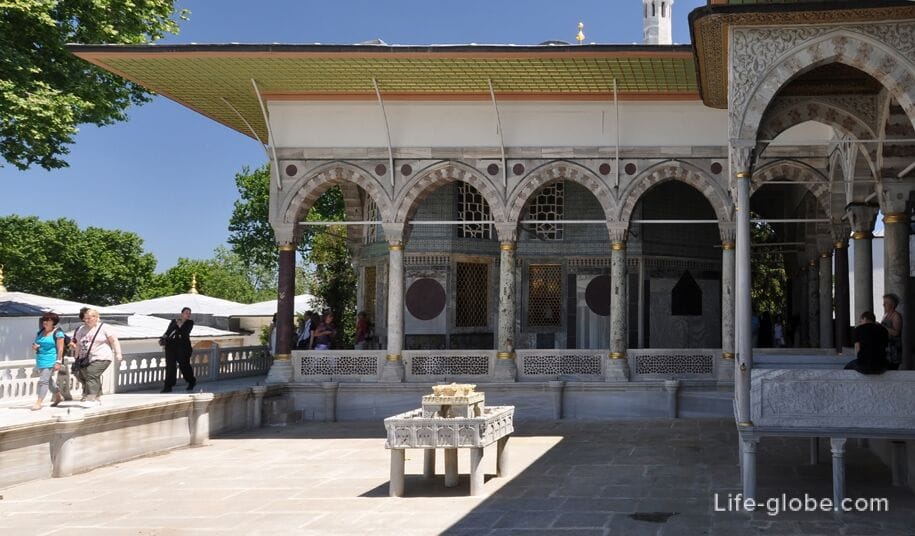
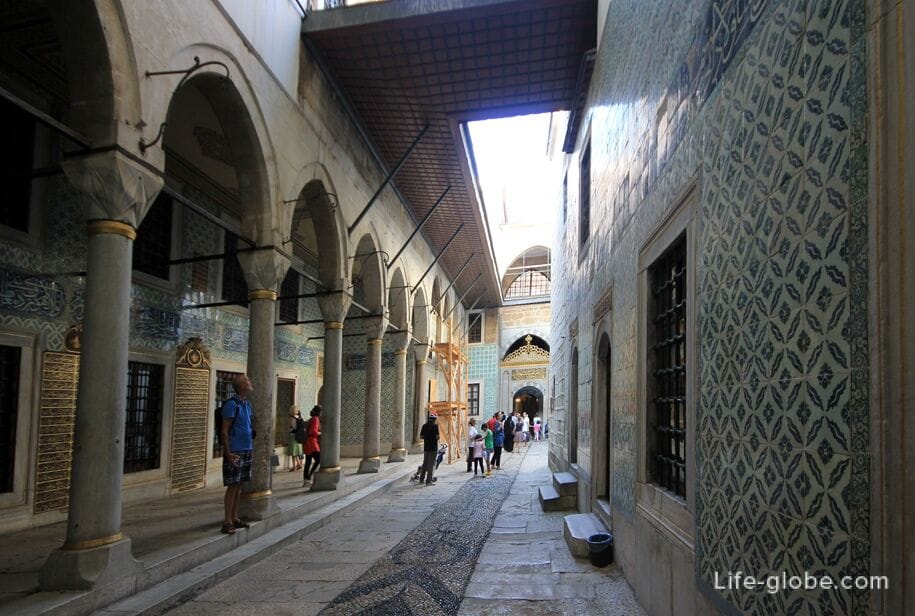
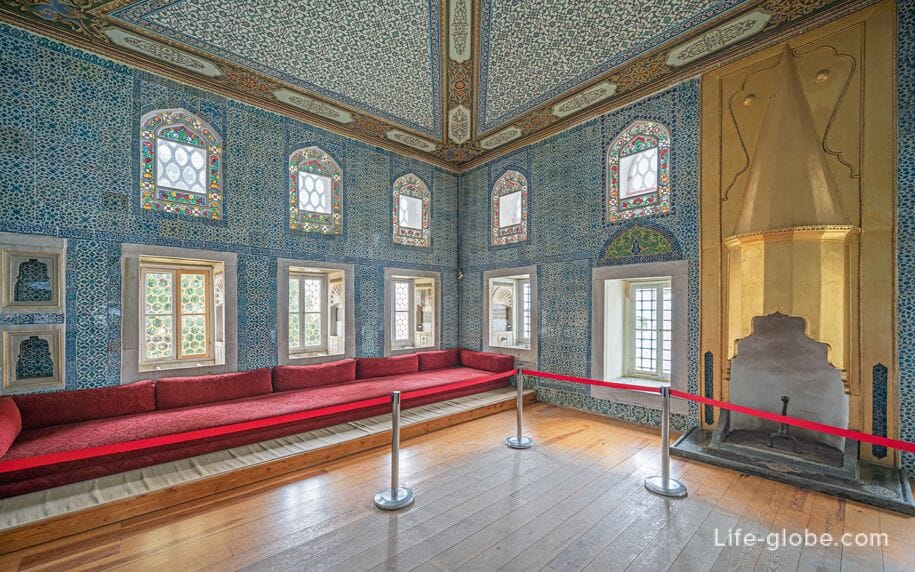
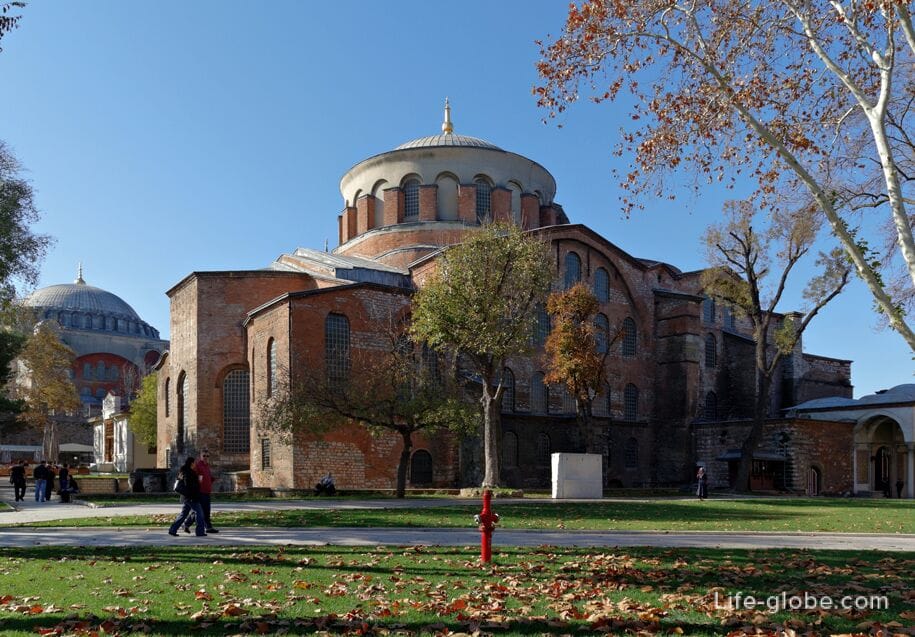
Near the walls of the Topkapi Palace there is a large Gulhane Park, which was the former outer park of the Topkapi Palace.
Today it is a public park with places for walking and recreation, cafes, fountains, monuments, historical sites and museums, including a Roman Gothic column (Gotlar Sütunu), a Welcome pavilion (Alay, Alay Köşkü),The Archaeological Museum of Istanbul (Istanbul Arkeoloji Müzesi) with the Museum of the Ancient East (Eski Şark Eserleri Müzesi) and the tiled pavilion of 1472 (Çinili Köşk Müzesi / Chinili Keshk), as well as the Museum of the History of Science and Technology in Islam (Istanbul Islam Bilim ve Teknoloji Tarihi Müzesi).
Entrance to the park is free (free of charge). Entrance to museums is paid. Learn more about Gulkhan Park...


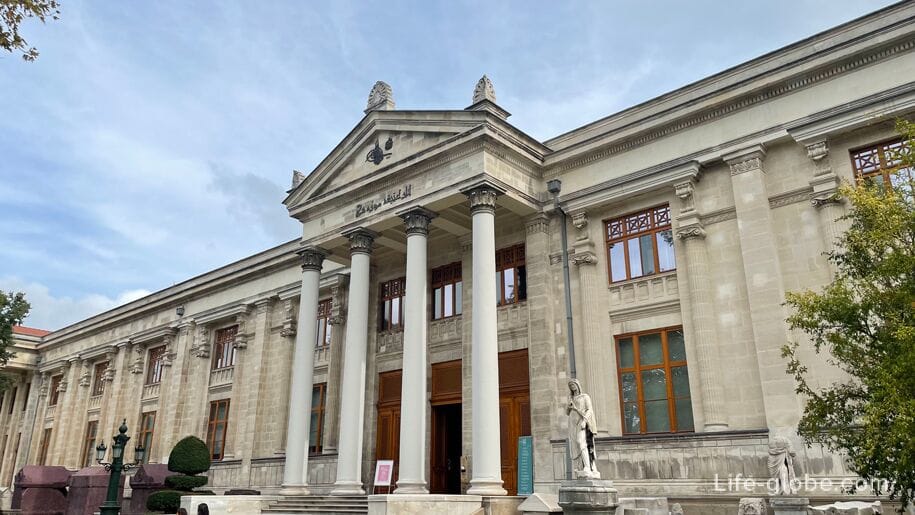
The historic Sultanahmet Square is now the heart of Istanbul and is part of the small district of the same name, where the main sights of the city are concentrated, representing a magnificent ensemble.
The current Sultanahmet Square is located on the site of an ancient Hippodrome, the construction of which was started by the Roman emperor Septimius Severus in 203, when the city was still called Byzantium. Chariot races were held at the hippodrome. Therefore, Sultanahmet Square has a second name - "Hippodrome Square" (At Meydanı).
In Sultanahmet square near such notableByzantine obelisk Konstantin (Konstantin Dikilitaşı, Örme Dikilitaş), the remains of ancient Greek Serpent column (Yılanlı Sütun), the ancient Egyptian obelisk of Theodosius (Dikilitaş), German fountain (Alman Çeşmesi) in neo-Byzantine style and Ottoman Palace of Ibrahim Pasha (Ibrahim Paşa Sarayı) - today it is the Museum of Turkish and Islamic arts (Türk ve Islam Eserleri Müzesi), historical Turkish baths 16th-century Hammam Hürrem Sultan (Hürrem Sultan Hamamı), dancing fountain (Fountain of Sultan Ahmad Maydan), column Mily or Zero column (Milyon Taşı), large Ottoman fountain of Ahmed III (III Ahmet Çeşmesi) and the mausoleum of Ahmed I (Sultan Ahmet Türbesi) - the tomb, the resting place of Sultan Ahmed I and his wife and children, as well as other members of the Ottoman dynasty. Learn more about Sultanahmet Square and district...

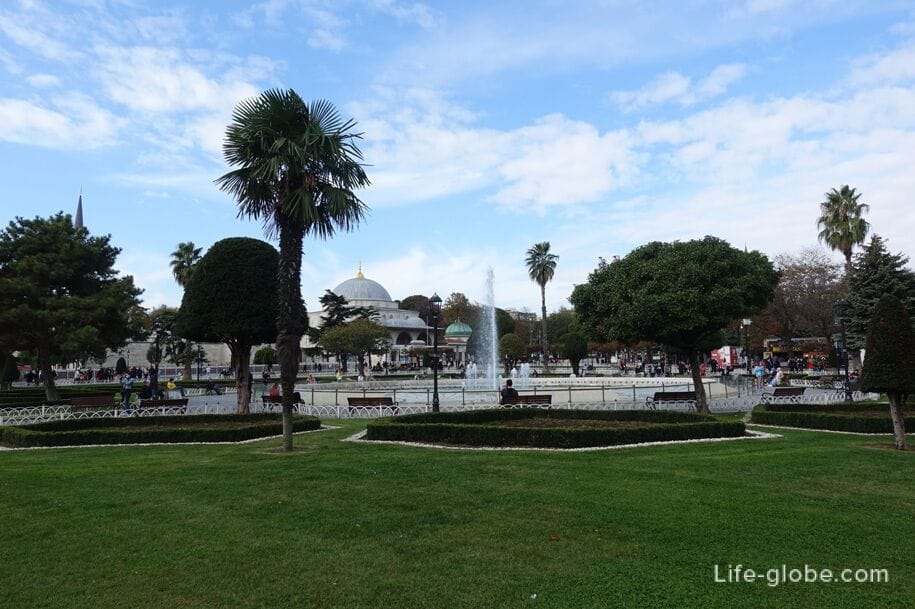

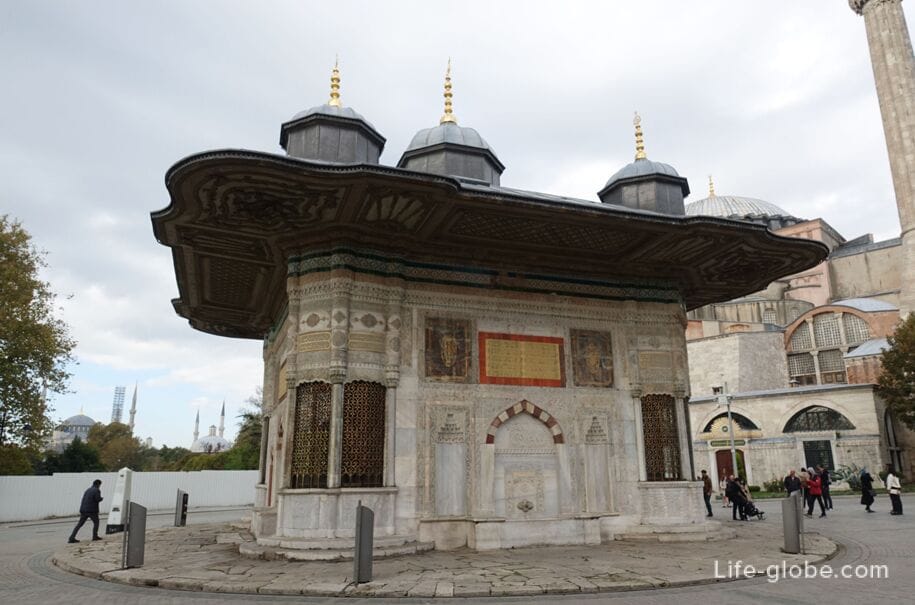
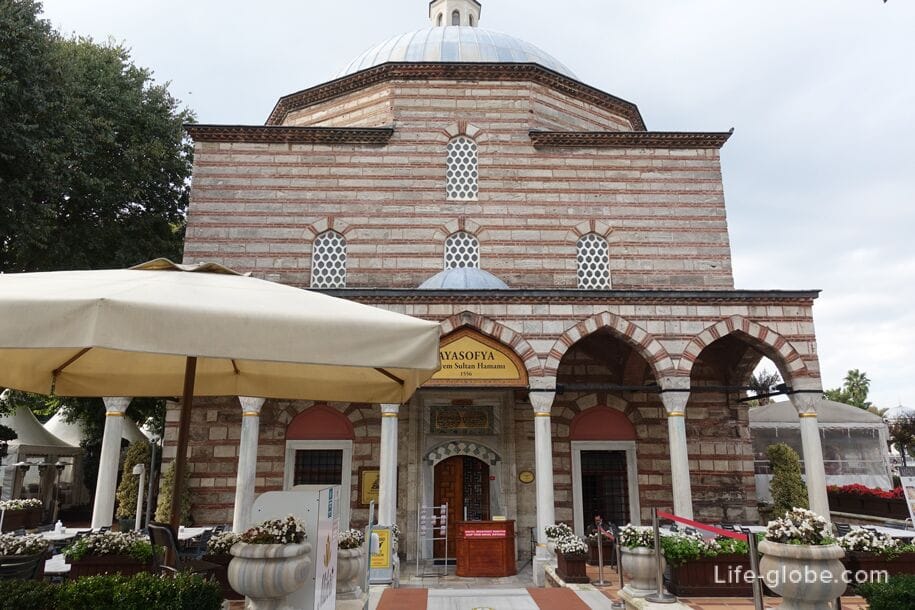
Hagia Sophia (Ayasofya) is a mosque in Istanbul, which during its history has been an Orthodox church, mosque and museum.
The mosque is one of the greatest world-famous monuments and examples of Byzantine culture, as well as a symbol of the "golden age" of Byzantium.
Hagia Sophia has mausoleums, tombs, four minarets, and the giant dome system of the mosque with arched windows is a masterpiece of architectural thought of its time.
The interior of Hagia Sophia has absorbed several cultures and religions: inscriptions in Scandinavian runes, unique Orthodox mosaics, Islamic mihrab, Sultan's lodge and minbar. The "Weeping Column" also attracts attention, which, according to legend, cures diseases and fulfills wishes.
Entrance to the mosque is free. More about the Hagia Sophia Mosque...
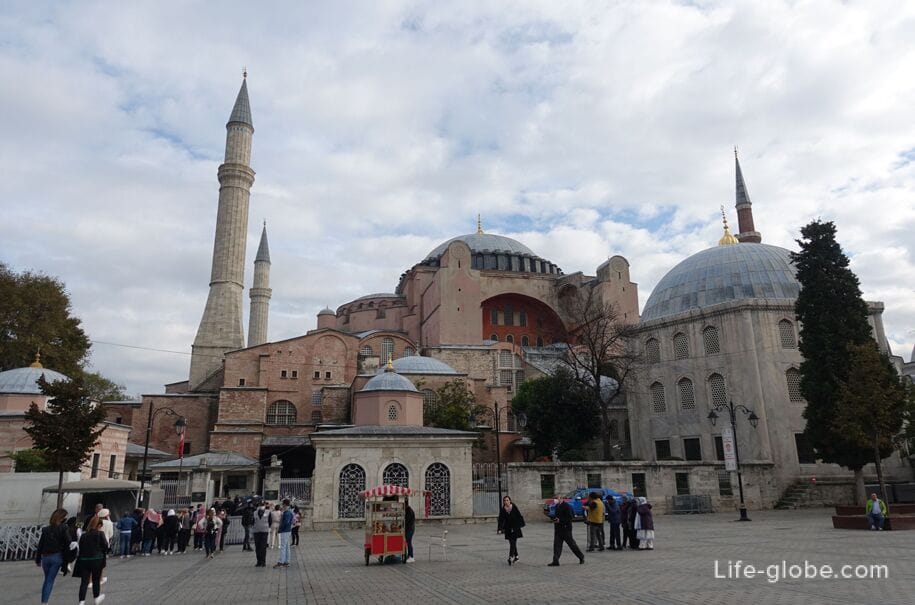
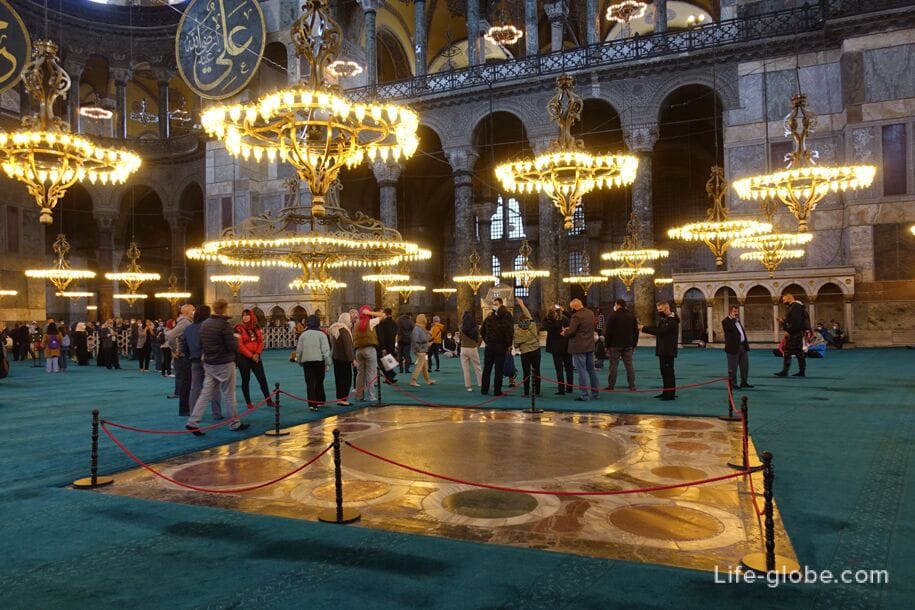
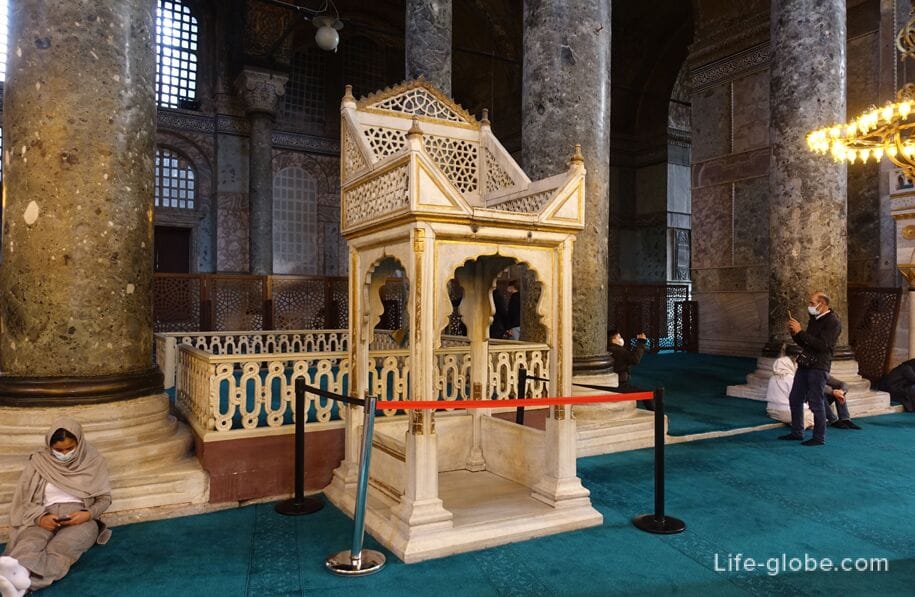
The Blue Mosque or Sultanahmet Mosque (Sultanahmet Camii / Sultan Ahmet Camii) is a historical imperial mosque, which is the first mosque in the city, and is also considered an outstanding example of Islamic and world architecture.
The mosque is known primarily for its six minarets and interior decoration, which is considered a masterpiece.
Today it is a functioning mosque, which is included in the UNESCO World Heritage List.
Entrance to the mosque is free. More about the Blue Mosque...
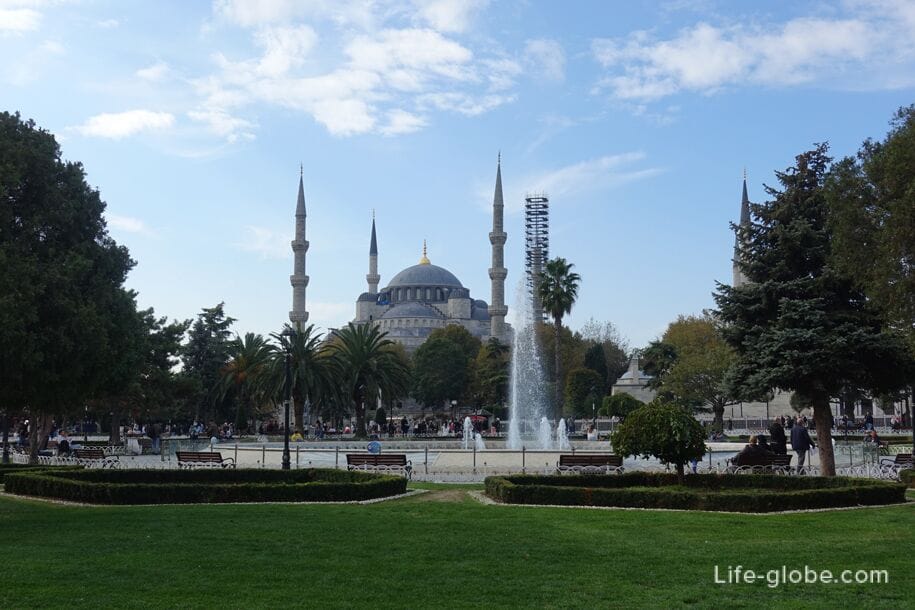
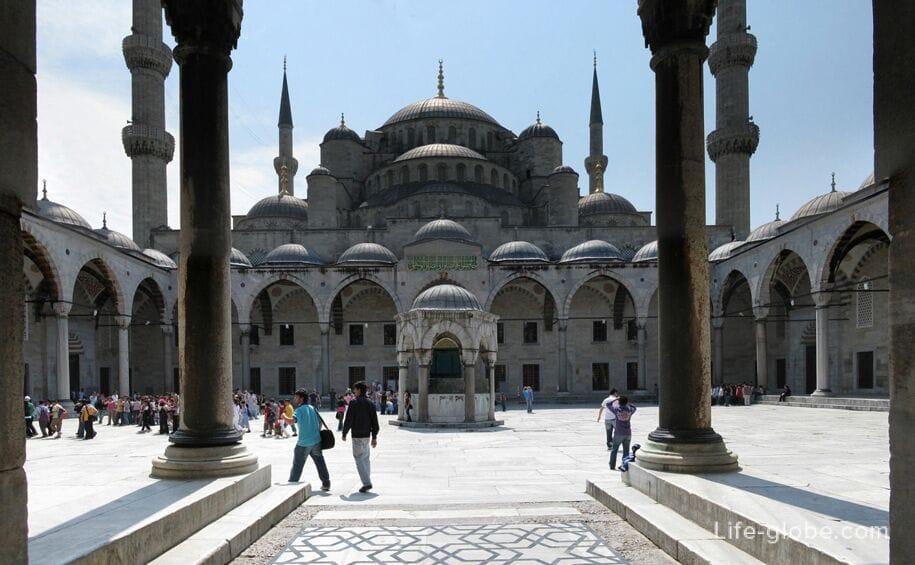
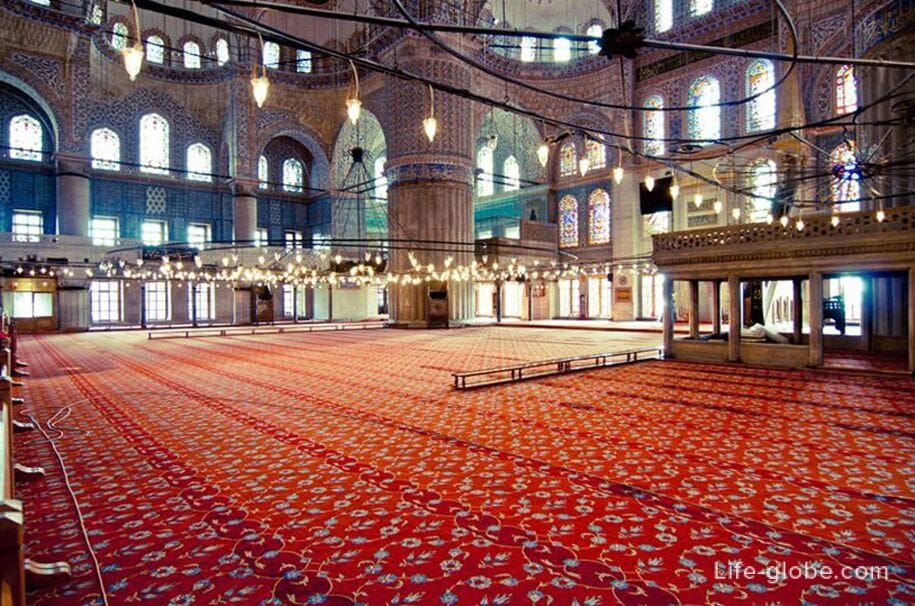
The Museum of Mosaics of the Grand Palace (Büyük Saray Mozaikleri Müzesi) is a museum of collections of mosaics from the time of the Byzantine Empire, discovered on the site of the Grand Imperial Palace of Constantinople.
The mosaics in the museum, according to research, date back to the period somewhere between 450-650 years of our era. Most likely, the mosaics were created under the Byzantine emperor Justinian I, in the first half of the 6th century.
Entrance to the mosaic museum is paid; with Arasta Bazaar (Arasta Çarşısı), near the Blue Mosque.
The museum's website: muze.gov.tr/muze-detay. Learn more about the Grand Palace Mosaic Museum...
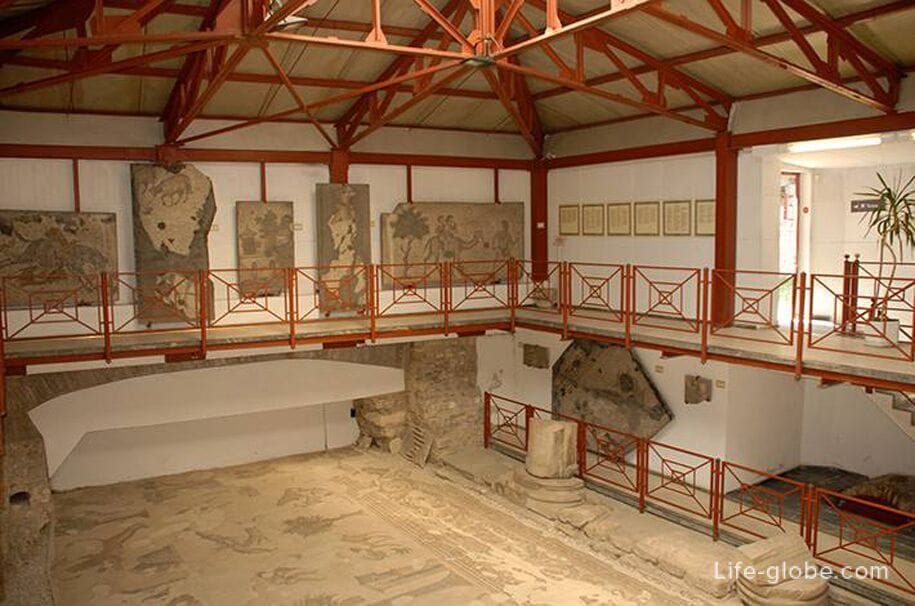

The Basilica cistern or Yerebatan Cistern (Yerebatan Sarnıcı) is one of the most famous, large and well-preserved underground reservoirs of Constantinople.
The cistern was built under the Byzantine Emperor Justinian I and was popularly called the "cistern-palace" because of the marble columns rising from the water, seemingly countless. The name "Basilica cistern" comes from the fact that there was a basilica at this place.
The cistern is a large underground structure with columns, one of which is called the "Crying Column" or "Column of Tears". It got this name due to the fact that, unlike other columns in the tank, it always remains wet, and there are patterns on its surface that resemble tear drops in shape.
The cistern is also notable for the two heads of Medusa, used as pedestals under two columns and belonging to the masterpieces of sculptural art of the Roman period.
Entrance to the tank is paid.
Address of the Basilica Cistern: Alemdar, Yerebatan Cd. 1/3, 34110 Fatih/Istanbul, Turkey.
The site of the Basilica Cistern: yerebatan.com/tr. Learn more about the cisterns and dungeons of Istanbul...
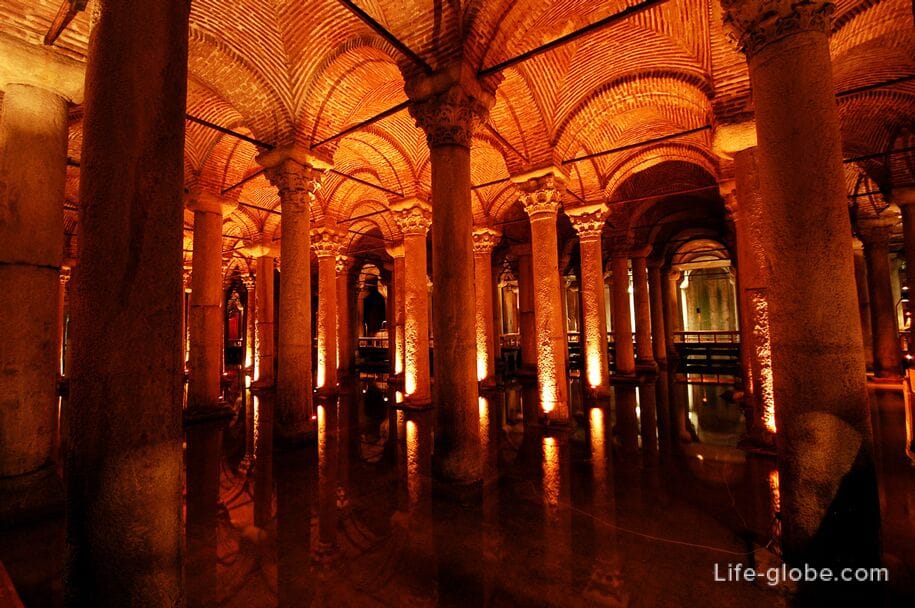
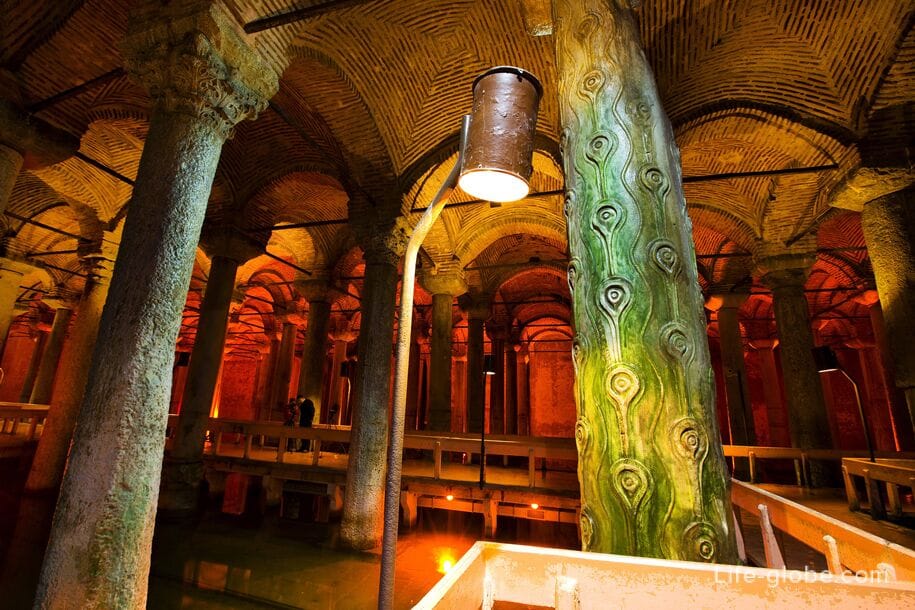
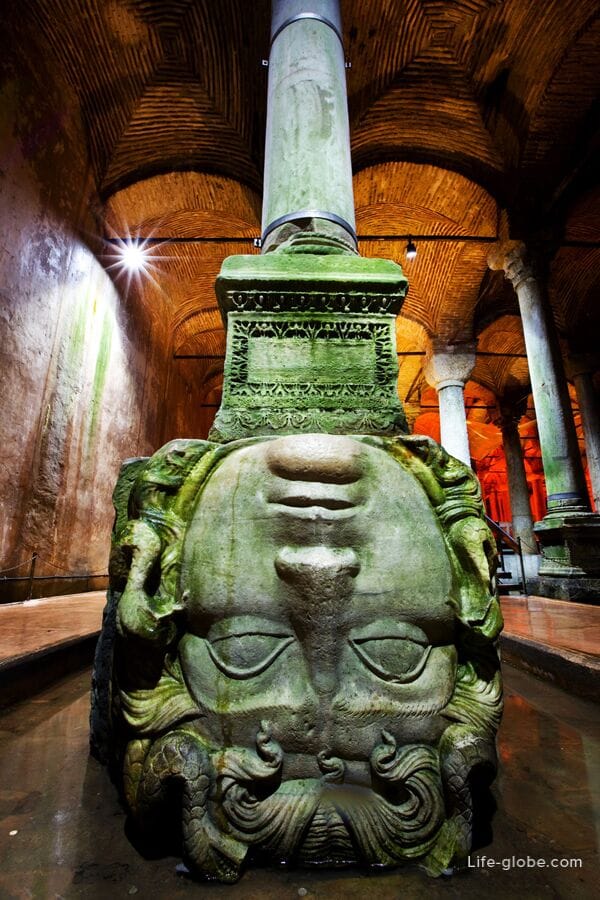
The Feodosiya cistern or the Sherefiye cistern (Şerefiye Sarnıcı) is one of the largest and most significant closed cisterns in the city, which has been restored today and functions as a museum, where visitors are shown a 10-minute show with three-dimensional effects and music.
It is assumed that the Sherefie cistern was built in 428-443, during the reign of Theodosius II. Water was delivered to the cistern from the aqueduct of Valens.
Entrance to the tank is paid.
The Theodosius Cistern is located under a modern building, the entrance is from Piyer Loti Caddesi Street No. 2/1.Tank address: Binbirdirek, Piyer Loti Cd. No:2/1, 34122 Fatih/Istanbul, Turkey.
Feodosiya Cistern website: serefiyesarnici.istanbul. More about the tank of Theodosius...
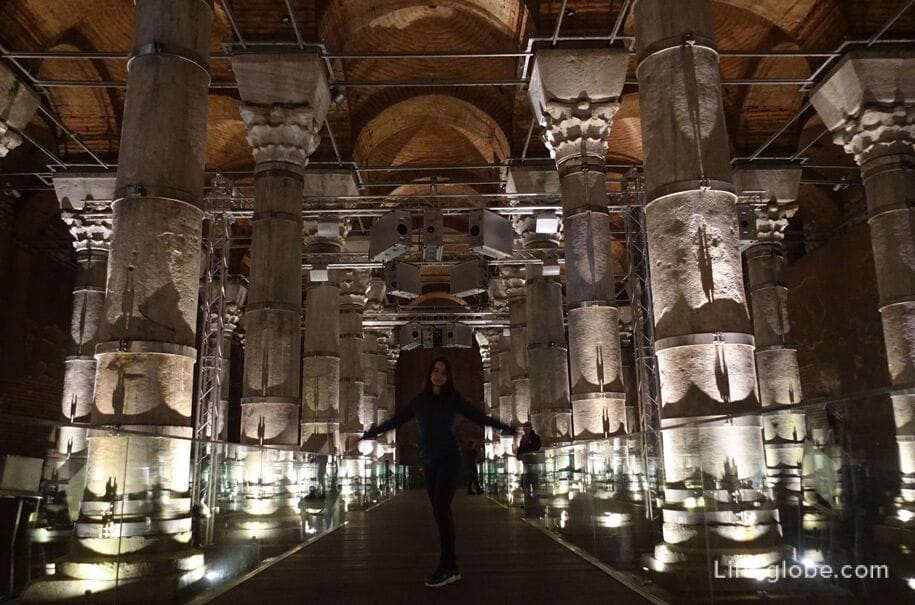
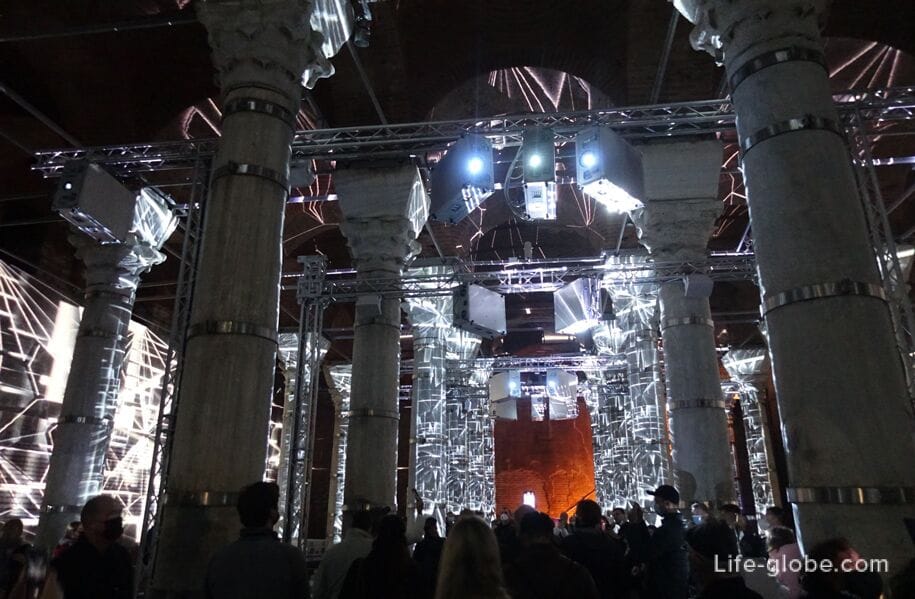
The small square of Chamberlitash (Çemberlitaş Meydanı) is located on the site of the former Forum of Constantine.
The main decorations of the square are:
- The Column of Constantine or the Chamberlitash column (Çemberlitaş Sütunu) is a Roman triumphal column dating from 328. More about the column of Constantine...
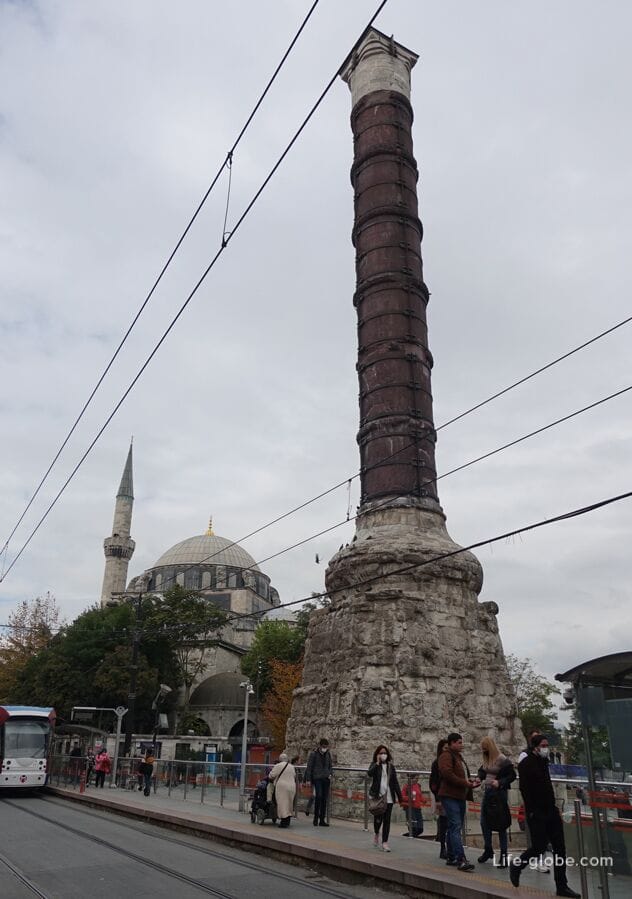
- Historical Turkish bath - Chamberlitash Hamami (Çemberlitaş Hamamı), originally built by Mimar Sinan in 1584 and commissioned by Nurban Sultan, head of the Imperial harem of Istanbul after the death of her second husband Selim II. Learn more about Chamberlitash Hammam...

Grand Bazaar or Grand Bazaar (Kapalıçarşı / Kapalıçarshi) is a historical bazaar, which is one of the oldest and largest markets in the world, as well as a symbol of Istanbul.
The birth of the Grand Bazaar was started in the winter of 1455-1556 by Sultan Mehmed II the Conqueror.
Today, the Grand Bazaar has both a covered historical part with domed painted ceilings and an open part, which is located on nearby streets.
The range of goods sold at the Grand Bazaar is very large, although somewhat monotonous from shop to shop. These are mainly jewelry and jewelry, antiques, shoes, bags, leather and fur products, textiles and articles made of it (clothing), carpets, souvenirs, herbs and dried fruits, lamps, ceramics and wood products, tableware, hookahs, Turks, etc.
Restaurants, tea shops, coffee shops, hookah bars, ateliers and currency exchange offices are also located inside the Grand Bazaar. Learn more about the Grand Bazaar...


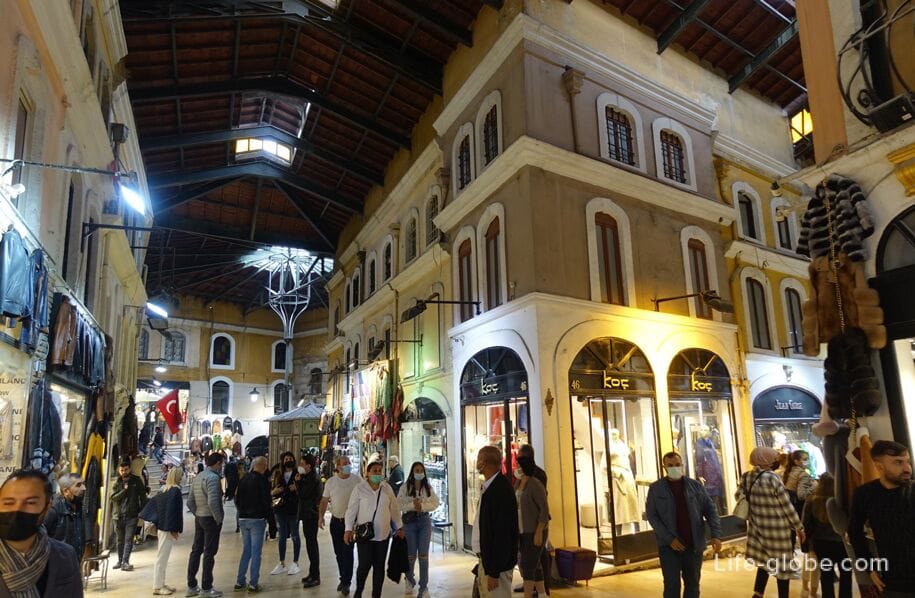

Suleymaniye (Süleymaniye Camii) is a masterpiece of architecture of the Ottoman Empire and a significant mosque in Istanbul.
The mosque was built in 1551-1557 by order of Sultan Suleiman the Magnificent and was built as a complex with adjacent buildings to serve both religious and cultural needs.
Suleymaniye is a complex in which, in addition to the mosque itself with a monumental courtyard, the turbe (tombs-mausoleums) are notable, which are polygonal buildings topped with a massive dome. Inside the tombs rest: Suleiman the Magnificent, his beloved wife Hurrem (Roksolana) and their daughter Mihrimah, as well as other members of the ruler's family.
Since the mosque is located on a hill, its territory offers panoramic views of part of historic Istanbul and the Golden Horn Bay.
Mosque address: Süleymaniye Mah, Prof. Sıddık Sami Onar Cd. No:1, 34116 Fatih/Istanbul, Turkey.
Entrance to the mosque complex is free. More about the Suleymaniye Mosque...

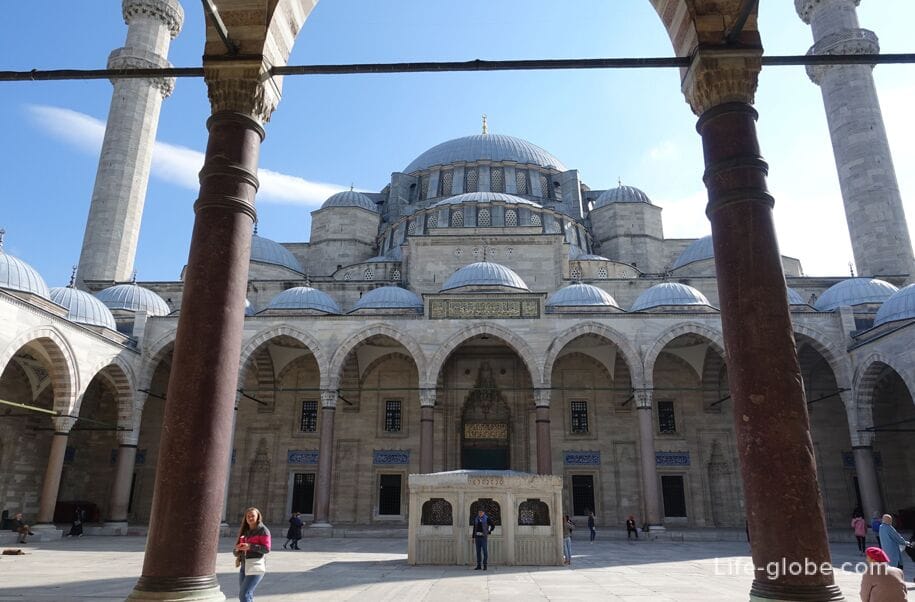
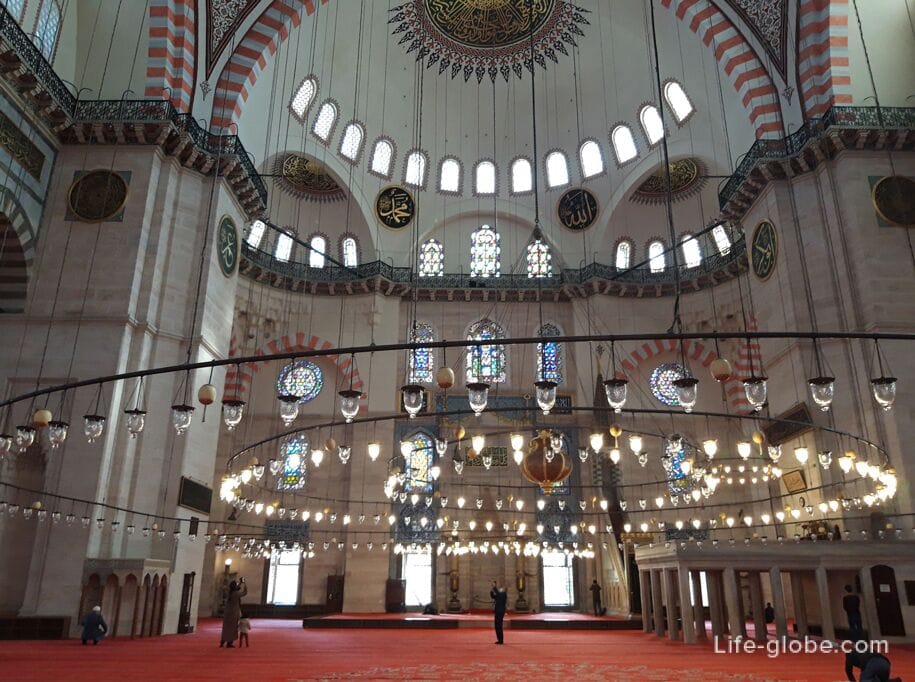
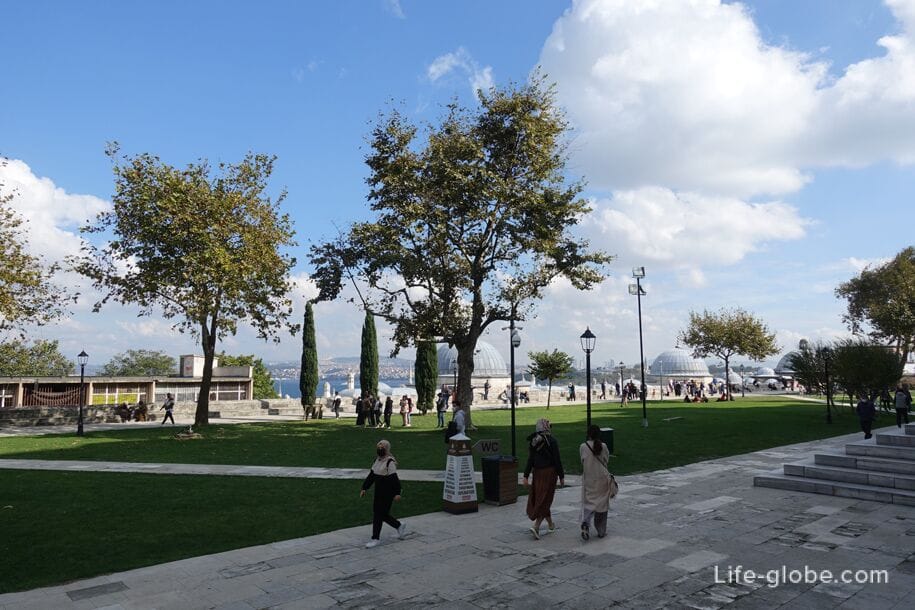
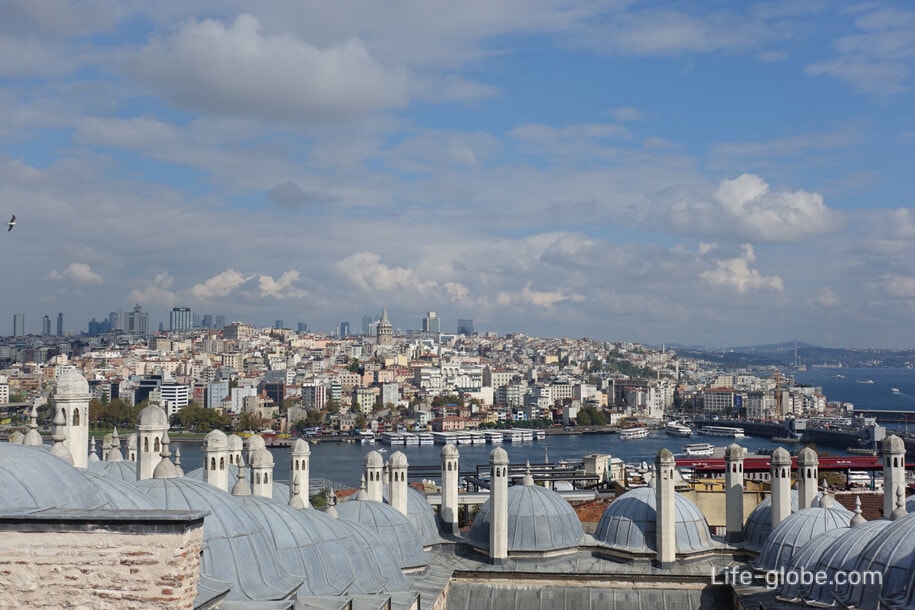
The Suleymaniye Hammam (Süleymaniye Hamamı) is part of the Suleymaniye Mosque complex. It was built in 1550-1557 by the Turkish architect Mimar Sinan by order of Sultan Suleiman the Magnificent and named after the Sultan.
This hamam was visited by Sultan Suleiman himself and other Ottoman sultans. Today, anyone can visit the hamam.
Sulemaniye hamami is a traditional Turkish bath consisting of three sections: cold, warm and hot. In the hammam, men and women are together. Male employees, called tellaks, serve all clients, doing, including foam massages.
Address of the Suleymaniye Hammam: Süleymaniye, Mimar Sinan Cd. No. 20, 34116 Fatih/Istanbul, Turkey.
The site of the hammam Suleymaniye: suleymaniyehamami.com.tr. Learn more about the hammams of Istanbul...

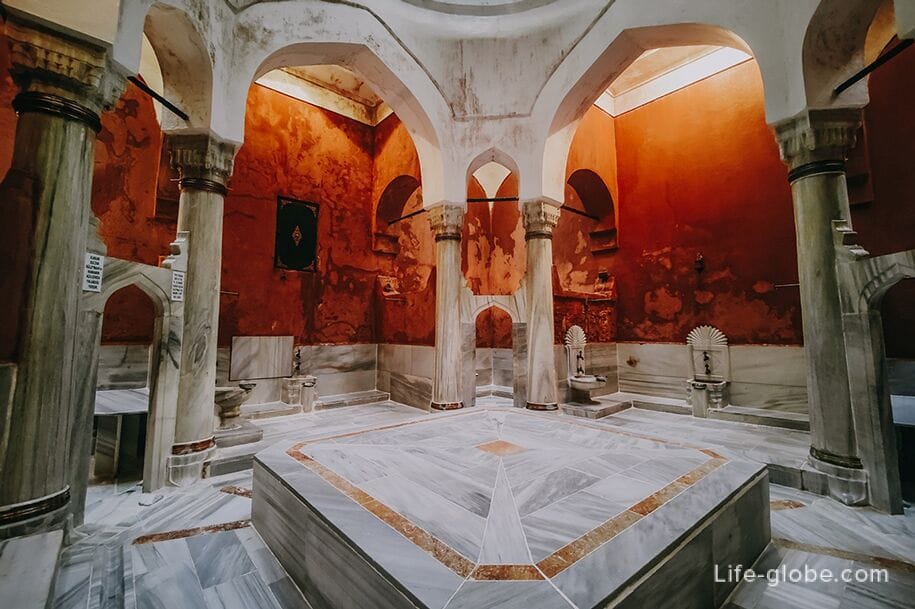
Fatih Mosque (Fatih camii) was built as a complex on the hill of the city by order of Sultan Mehmed II the Conqueror in 1463-1470 on the site of the Byzantine Church of the Holy Apostles.
The mosque was destroyed by an earthquake in 1766 and rebuilt in 1771.
There is a madrasah at the mosque, and in the courtyard there is a cemetery where Mehmed II rests in the mausoleum, whose tomb is one of the important city shrines.
The mosque is located in the historical center of Istanbul, at the address: Ali Kuşçu, Hattat Nafiz Caddesi No: 6, 34083 Fatih/Istanbul, Turkey.
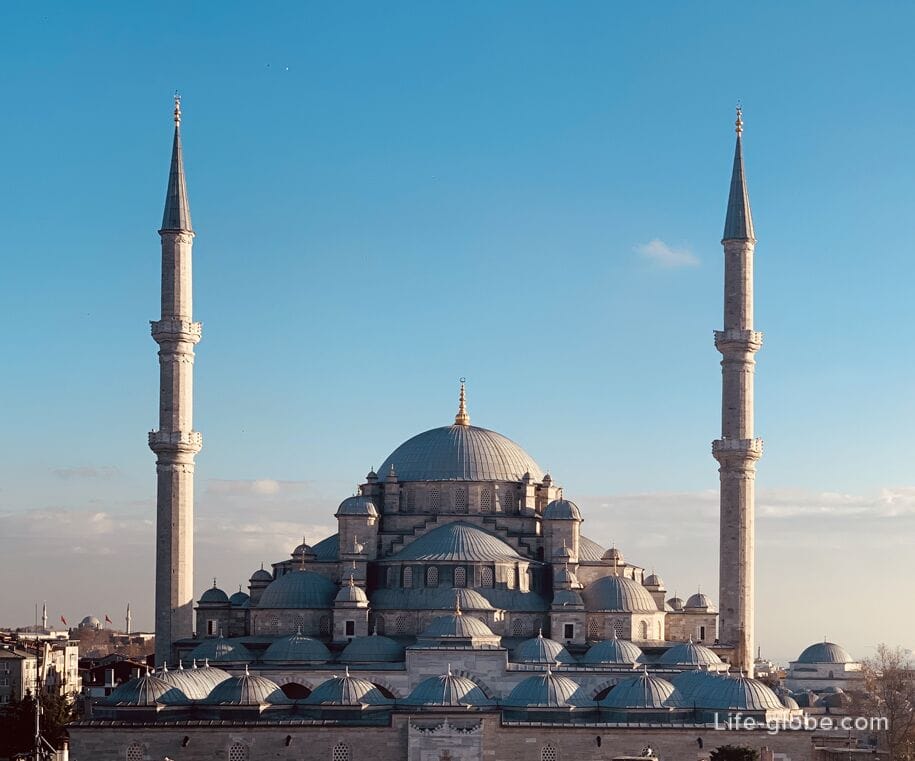

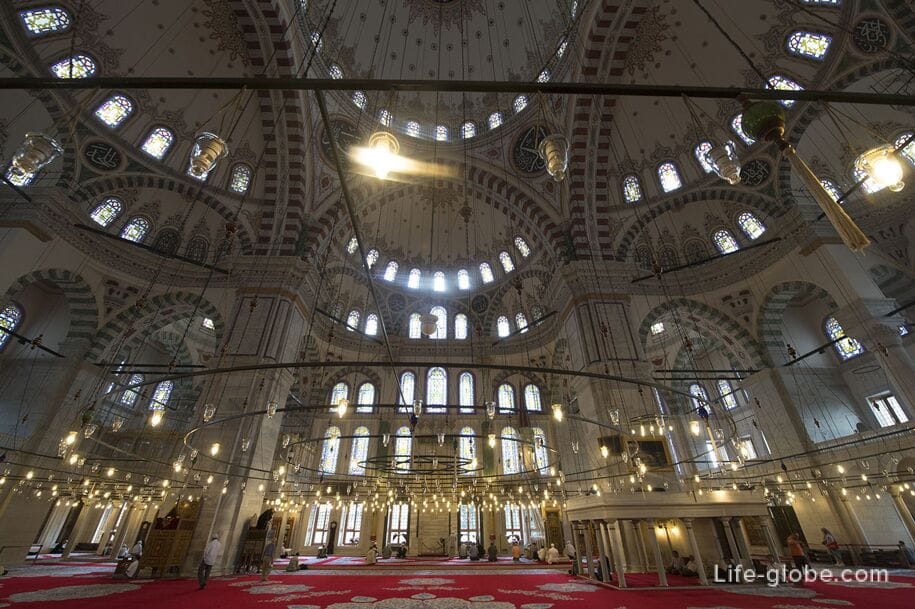
Balat is a traditional Jewish quarter (district) in the large district of Fatih, located near the waters of the Golden Horn.
Today, the area is a popular place among visitors to the city and attracts attention, first of all, with colorful old buildings and stairs, streets with bright decorations and street cafes decorated in authentic and ruin-style.
The most popular street in the area is a slope with stairs called Merdivenli Yokush (Merdivenli Yokuş Sokağı). The best pictures on the Internet and guidebooks from the area can be seen from this street.
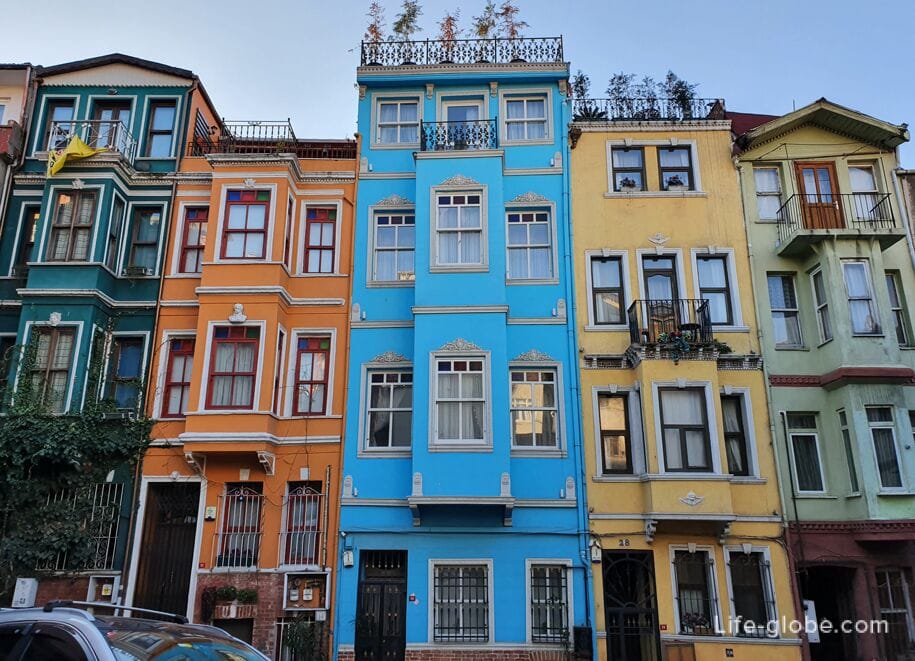
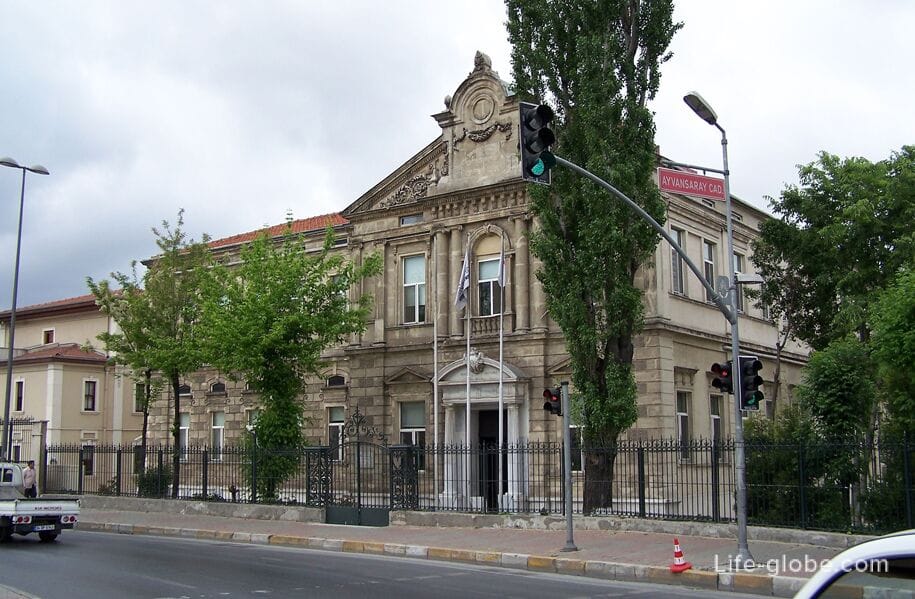
In the Balat district is notable for: the toy Museum at Balat (Istanbul Oyuncak Müzesi), is the oldest synagogue of Istanbul Achrida (Ahrida (Ohrid) Sinagogu) Ottoman mosque, the mausoleums and lookout Selim or Yavuz Selim the terrible (Yavuz Sultan Selim Camii), the Church of the virgin Pammakaristos (Fethiye Camii, the mosque of the Conquest) with Byzantine mosaics, the Bulgarian Church of St. Stephen (St. Stephen's Bulgarian Orthodox Church / Sveti Stefan Kilisesi) in neo-Byzantine style, the main Orthodox Cathedral of Istanbul, St. George's Cathedral (St. George's Cathedral, Aya Yorgi Kilisesi) with part of the column "column of flagellation". Learn more about the Balat and Fatih districts...
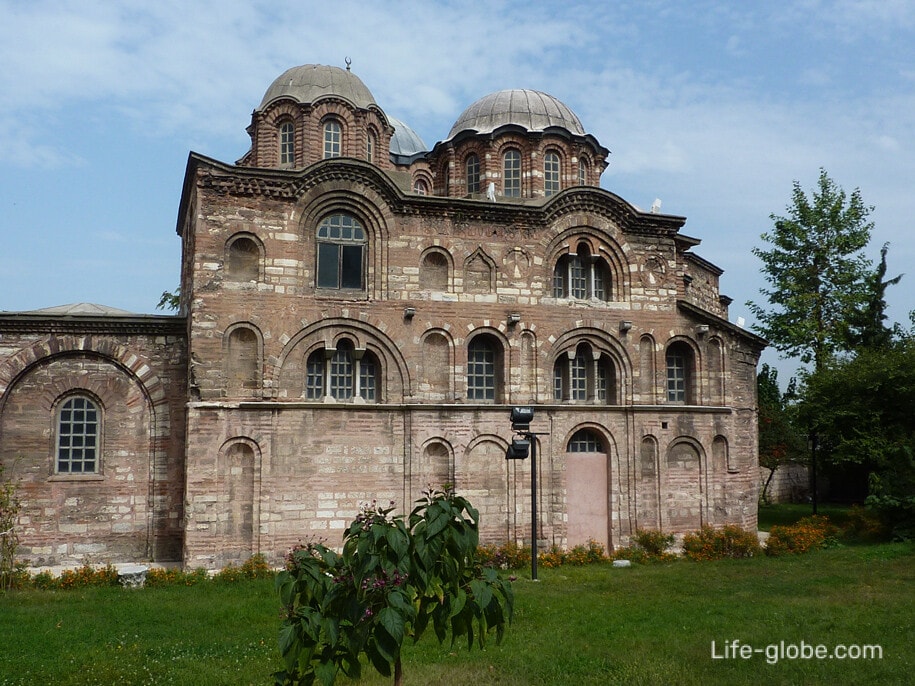
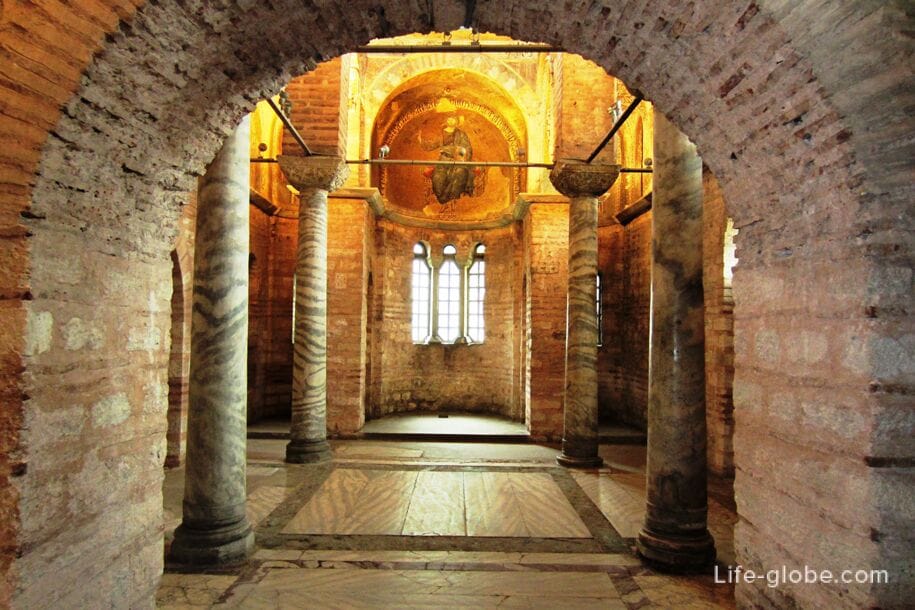
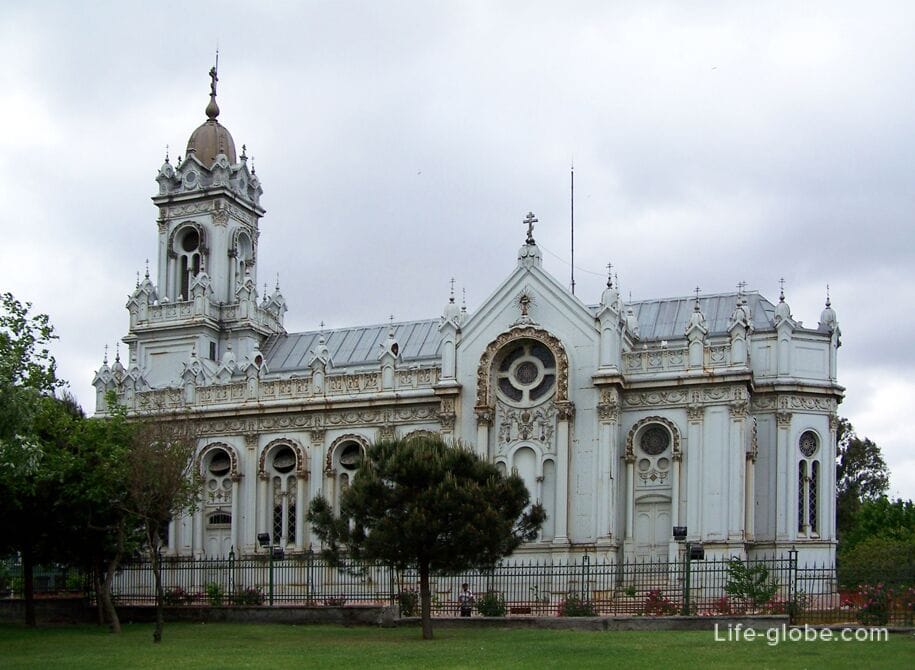
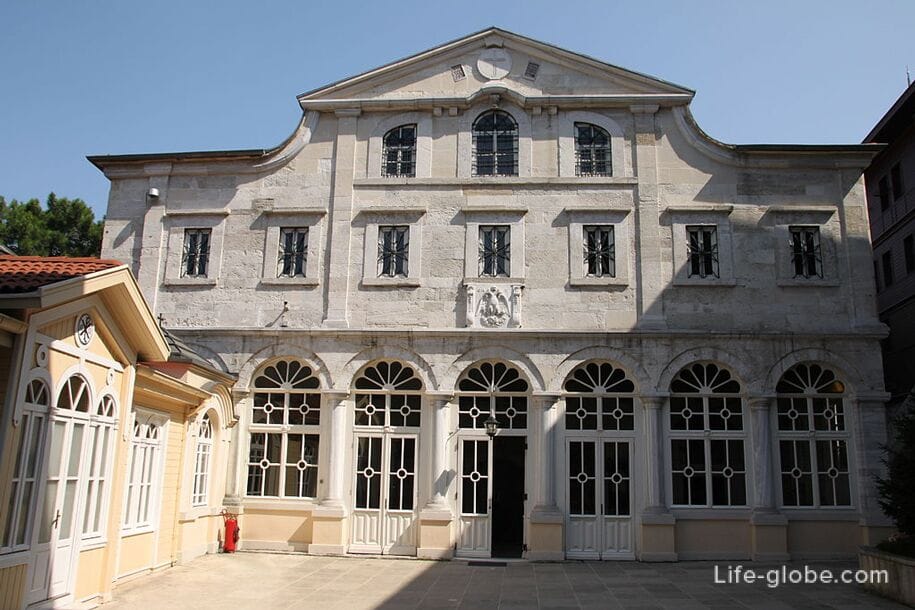
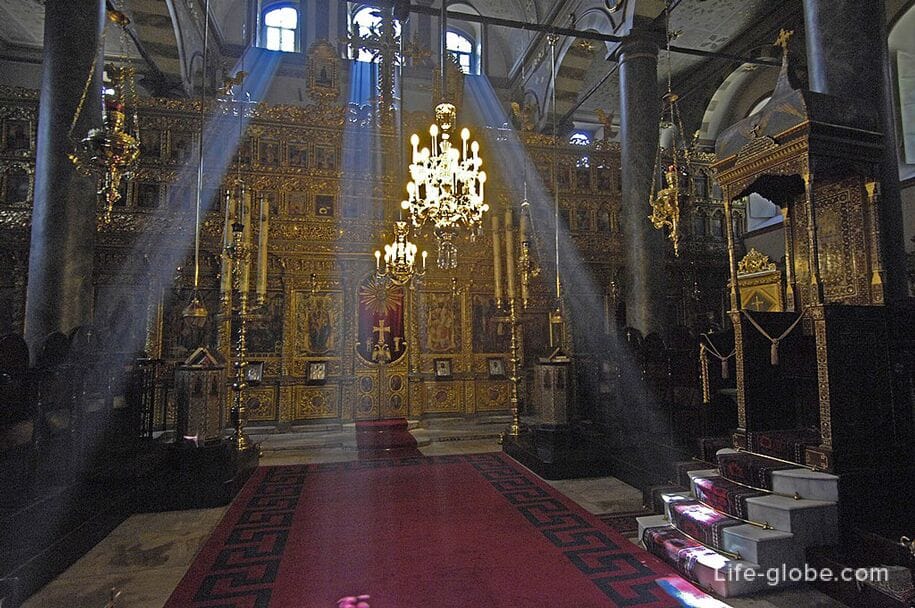
The Kariye Mosque or Monastery of Chora, also the Church of the Holy Savior in Chora (Kariye Camii) is a medieval Greek Orthodox church used today as a mosque.
The Church of the Savior in the Choir is built in the style of Byzantine architecture. In the 16th century, during the Ottoman Empire, the Christian church was turned into a mosque. It became a museum in 1945 and was turned into a mosque again in 2020.
The interior of the building is covered with some of the oldest and best preserved Byzantine Christian mosaics and frescoes. In addition to mosaics, the mosque also has colorful and patterned marble decorations.
After the building was converted from a church into a mosque, Christian symbols: inscriptions, frescoes and mosaics were covered with fine paint and lime whitewash, without destroying the building, so it has survived to this day.
Mosque address: Dervişali, Kariye Cami Sk. No:18, 34087 Fatih/Istanbul, Turkey.


The Blachernae Palace or Tekfur Palace (Tekfur Sarayı, Tekfur sarayı) today is the remains of a former palace built for the son of the Byzantine emperor.
The Tekfur Palace was one of the palaces used by the emperors during the last period of Byzantine palaces. It was ideally positioned to protect the emperors from possible rebellion. The palace was also used as a workshop for the manufacture of glass and tiles during the Ottoman Empire. During the 57-year-old Latin invasion of Istanbul, the Tekfur Palace and almost all other imperial buildings around it were destroyed.
Today, part of the ruins of the palace have been restored, and are used as a museum with part of the walls, an interior room with an exposition, a courtyard, an elevator and an observation deck.
Entrance to the palace is paid.
Palace address: Ayvansaray Mahallesi, Şişhane Caddesi, 34087 Fatih/Istanbul.
Website of the Blachernae Palace Museum: tekfursarayi.istanbul.

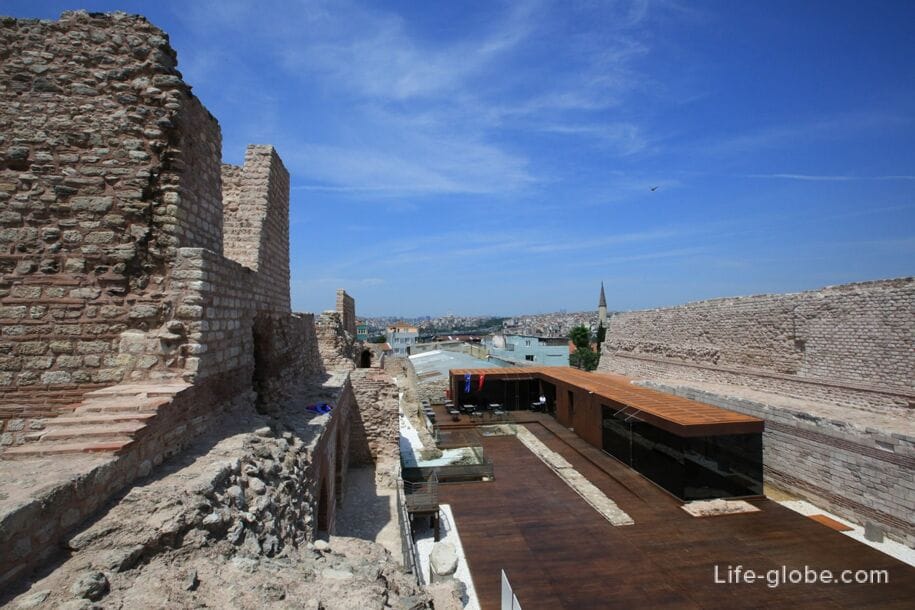
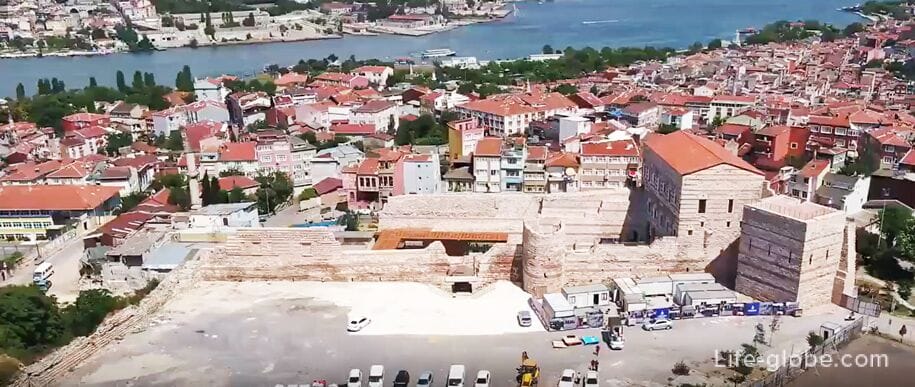
Pierre Loti is a 53-meter-high hill, which is one of the best and most famous viewing platforms in Istanbul.
Panoramic views of the Golden Horn and the European part of Istanbul open from the observation deck of the hill.
In addition to the observation deck on the hill, there are also: a panoramic cafe of the same name, several souvenir shops, a toilet, a restaurant and the Turkhouse hotel, which overlooks the 7 hills of Istanbul and the Golden Horn Bay. Free Wi-Fi is available throughout the hotel. Guests can make use of a sauna and a hammam. Link to the hotel
Pierre Loti Hill is located on the European side of Istanbul, in the Eyup area near the waters of the Golden Horn.
The observation deck on the hill itself is free.
You can climb (descend) to the hill on foot through the old cemetery (free of charge) or by using the Eyüp-Piyer Loti Teleferik Hatt (TF2) gondola cable car, which is the public transport of the city (Istanbul transport cards are valid). More about the hill, the Pierre Loti observation deck and the cable car...
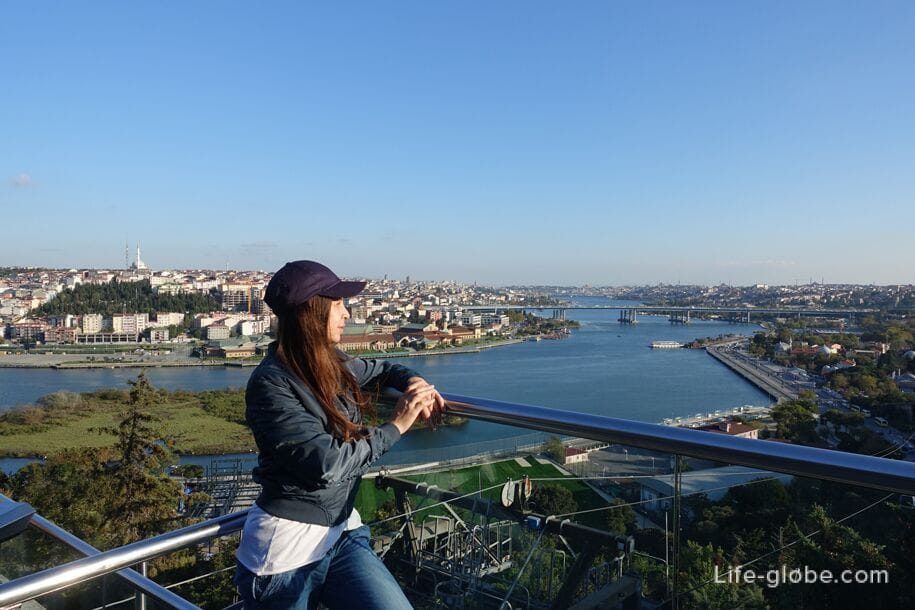
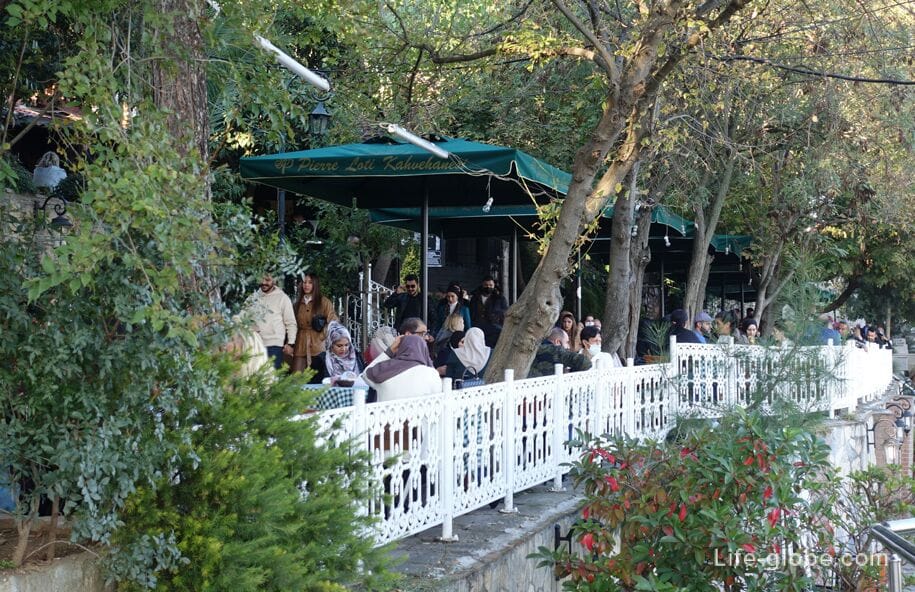
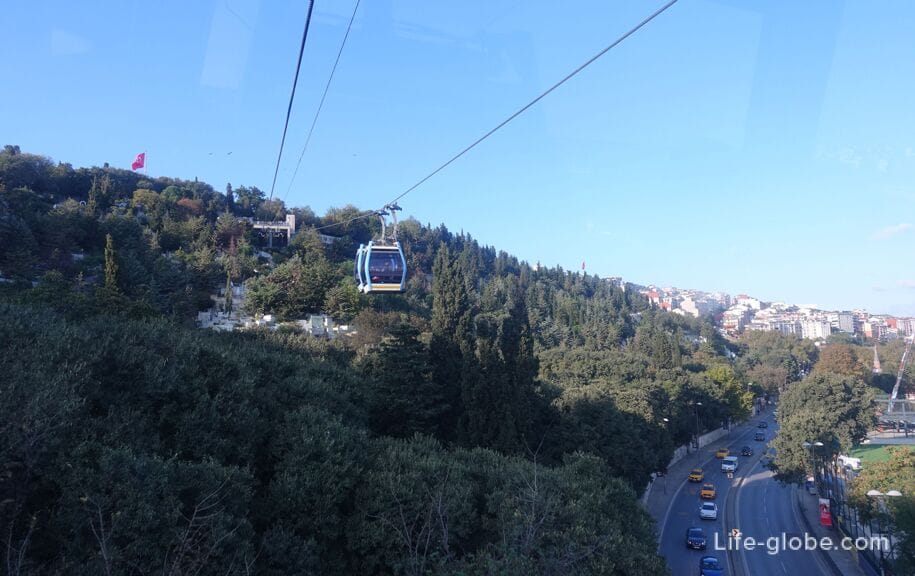
The Panorama 1453 Museum (Panorama 1453 Tarih Müzesi) is a history museum with a large panoramic painting depicting the conquest of Constantinople by the troops of the Ottoman Sultan Mehmed the Conqueror on May 29, 1453.
Entrance to the museum is paid.
Museum address: Merkez Efendi Mahallesi, Topkapı Kültür Park Içi Yolu, 34015 Zeytinburnu/Istanbul, Turkey.
The museum's website: panoramikmuze.com .
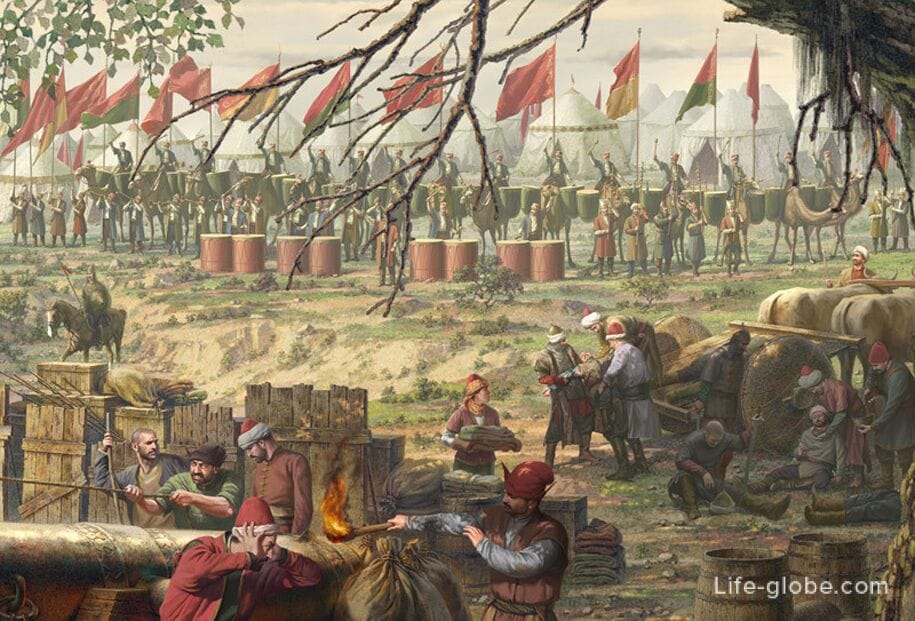
Vialand Theme Park (formerly known as Isfanbul Park) is the largest and main entertainment venue in Istanbul for people of all ages.
This park is called Istanbul Disneyland.
The park consists of three thematic zones: the world of antiquity, the world of adventure and the children's world.
There is also a cafe, a shopping center and other entertainment in the park.
On the territory of the park there is 4-star Vialand Palace Hotel with garden, terrace, free Wi-Fi, free private parking and a 24-hour front desk. Breakfast may be included in the room rate. Link to the hotel
Park address: Yeşilpınar, Şht. Metin Kaya Sk. No: 11/1, 34065 Eyüpsultan/Istanbul, Turkey.
The park's website: vialand.com.
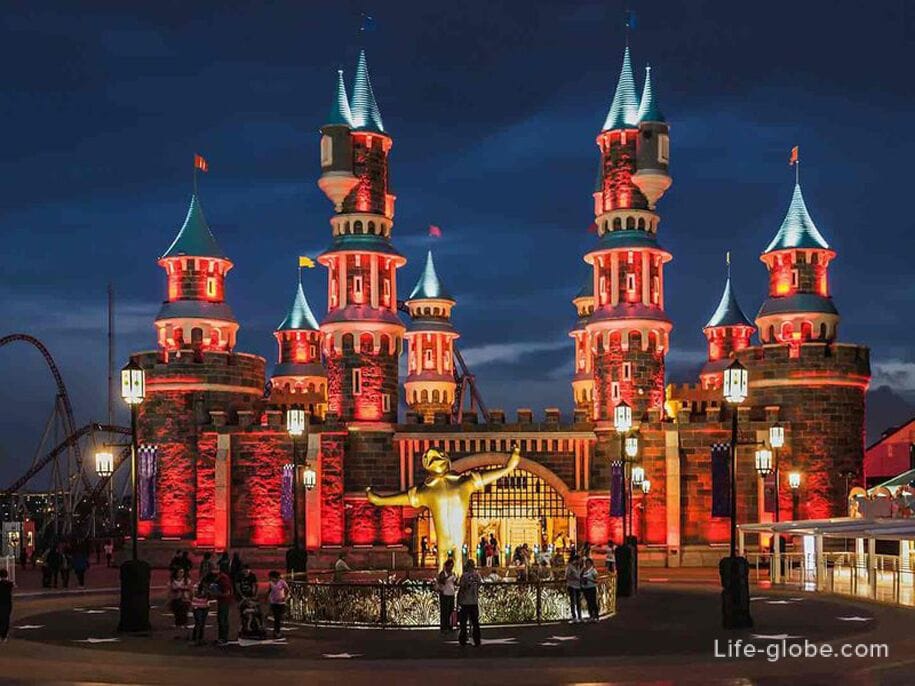
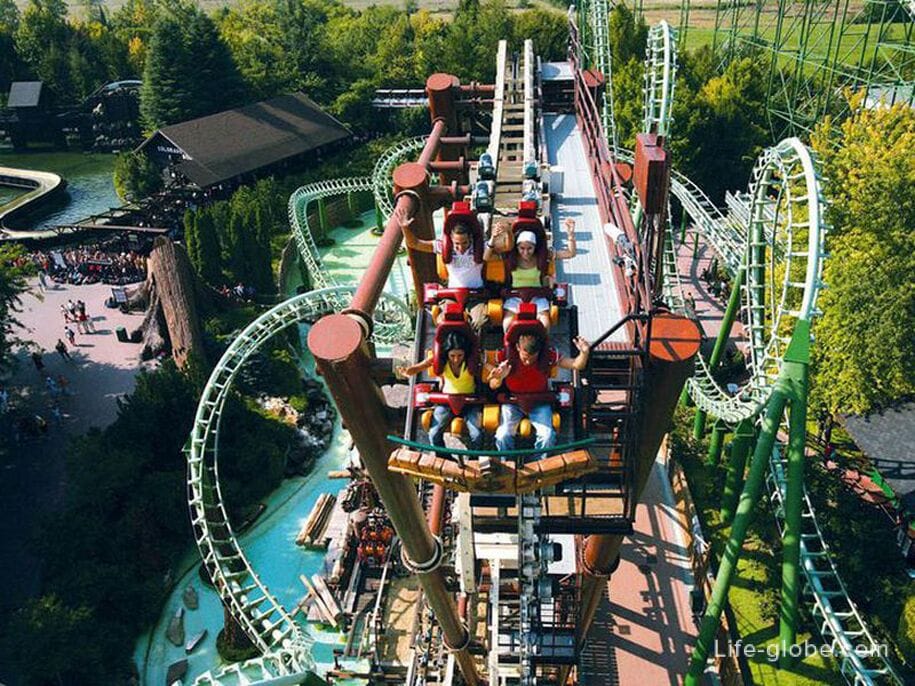
The fortress of Yedikule or Yedikule (Yedikule Hisari), which translates as "fortress of the seven towers" or "dungeon of the seven towers", was built in 1458 under Sultan Mahmed II the Conqueror.
The fortress of seven towers was created by adding three new towers and completely covering a section of the ancient walls of Constantinople, including two Byzantine twin towers and pylons that originally formed the main entrance gate to the city - the Triumphal Golden Gate (Altınkapı), built by the Roman emperors Theodosius I and Theodosius II.
The fortress was created as an official treasury fortress of the Empire, where each of the towers functioned as a repository of precious goods, documents, weapons, coins, gold and silver bars. In the 16th century, the treasury was moved to the inner part of the Topkapi Palace and after that the "Seven Towers" became a prison for high-ranking prisoners.
During the Napoleonic Wars, the fortress was the prison of many French prisoners of war, including the writer and diplomat Francois Pouqueville.
Today, the Yedikule Fortress is a museum of the Yedikule dungeon (Yedikule Hisarı Müzesi).
Yedikule is located near the waters of the Marmara Sea, at the address: Yedikule, Yedikule Meydanı Sk. No: 9, 34107 Fatih/Istanbul, Turkey.
The website of the Yedikule Museum: yedikulehisari.com. Learn more about the towers, fortresses, castles, walls and gates of Istanbul (fortifications of Istanbul)...
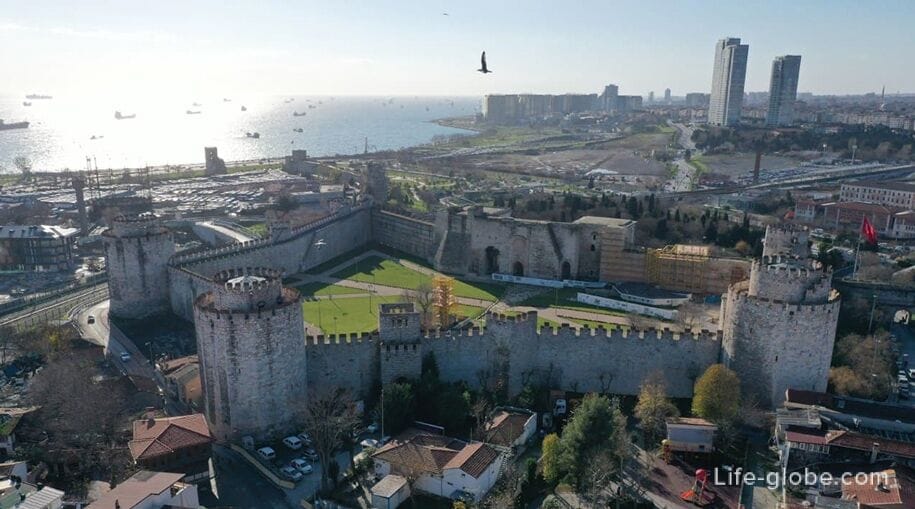
Istanbul Aquarium (Istanbul Akvaryum) is the largest in Istanbul, which contains more than 1,500 species of animals (sharks, piranhas, rays, penguins, etc.), as well as a souvenir shop and cafe.
The aquarium consists of 17 themed zones, including rainforest and underwater world zones.
In the aquarium, you can dive with sharks and rays in the main tank.
Aquarium address: Şenlikköy, Yeşilköy Halkalı Cd. No: 93, 34153 Florya/Istanbul, Turkey.
Aquarium website: istanbulakvaryum.com/tr . Detailed article "To Istanbul with children"...
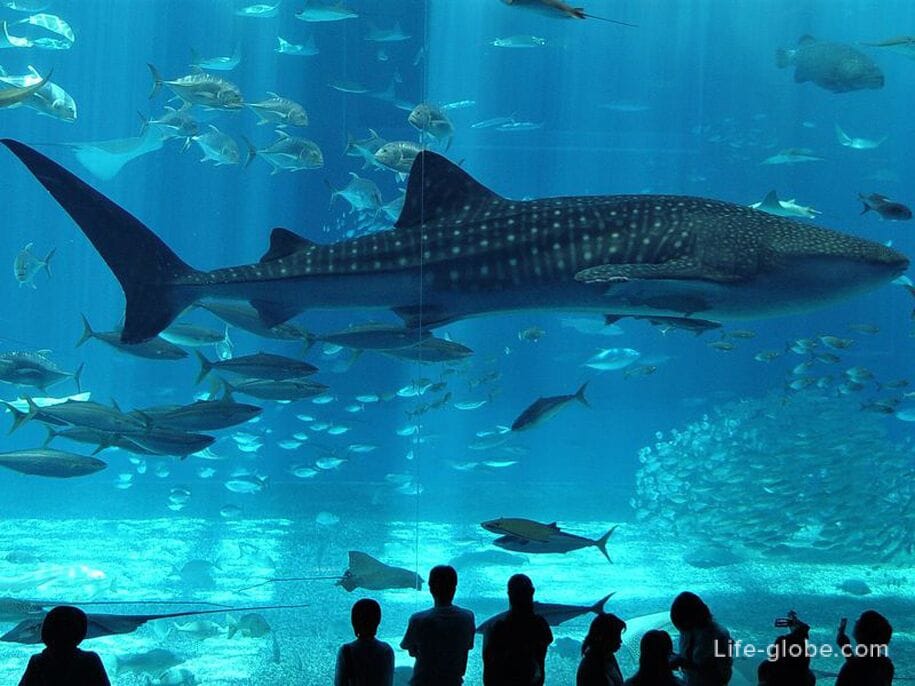

The Egyptian Bazaar or Spice Bazaar (Mısır Çarşısı / Mysır Charshısı) is a historical market in Istanbul, where trade is carried out mainly in sweets, spices, dried fruits and tea.
The market was opened in 1663-1664 and was intended for herbalists and cotton sellers. Then the bazaar was called "New Bazaar" (Yeni Çarşı) and "Valid Bazaar" (Valide Çarşısı).
In the middle of the 18th century, the bazaar was called the "Egyptian" or "Spice Bazaar", because spices brought from Egypt were traded there. Spices were supplied from India, Syria, Egypt and Arabia, and they were turned into essences, pills, powders and ointments that gave a pleasant smell to the beard and dishes.
Today, the Egyptian Bazaar has a closed part with vaulted painted ceilings and an open part.
The Egyptian bazaar sells mainly foodstuffs, including Turkish sweets, dried fruits, nuts, olives, tea, coffee, herbs, spices, meat delicacies, etc.
There is also a restaurant, shops with jewelry, souvenirs, dishes, hookahs, soap, textiles and some other non-food products.
The Egyptian Bazaar is located near the Galata Bridge, at the address: Rüstem Paşa, Erzak Ambarı Sok. No: 92, 34116 Fatih/Istanbul, Turkey. Learn more about the Egyptian Bazaar...


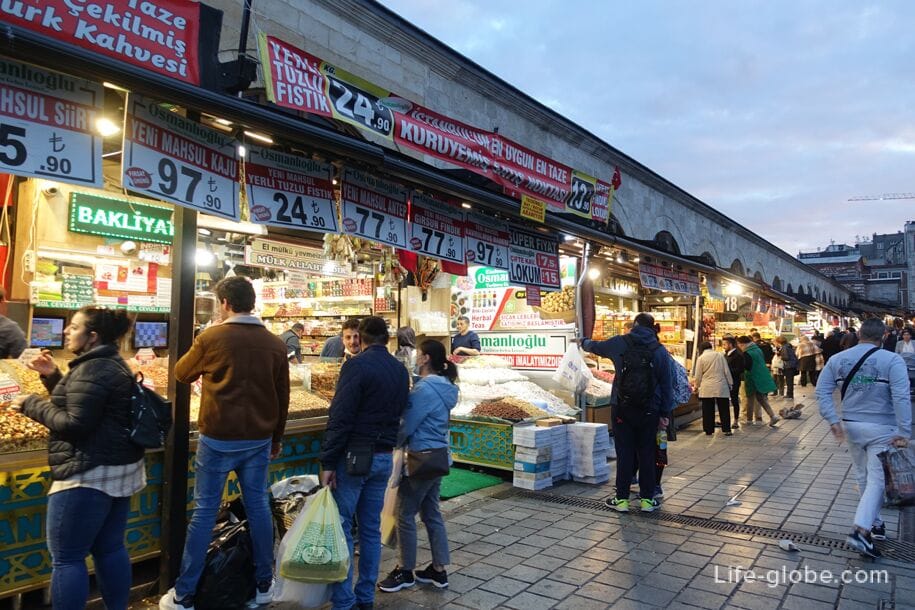
The Golden Horn (Altın Boynuz or Haliç / Halic) is a large body of water in Istanbul, which is a narrow curved bay (bay) connecting to the Bosphorus Strait at the point where the Bosphorus meets the Sea of Marmara.
Small ferries and yachts ply the Golden Horn Bay.
You can enjoy the views of the Golden Horn and its shores from the water by taking an excursion walk through the reservoirs of Istanbul or from ferries that function as public transport in Istanbul (Istanbul transport cards are valid) and connect both the shores of the Golden Horn itself and the Golden Horn with the shores of the Bosphorus. Ferry berths are located both on both shores of the Golden Horn and the Bosphorus Strait. More about the Golden Horn Bay...
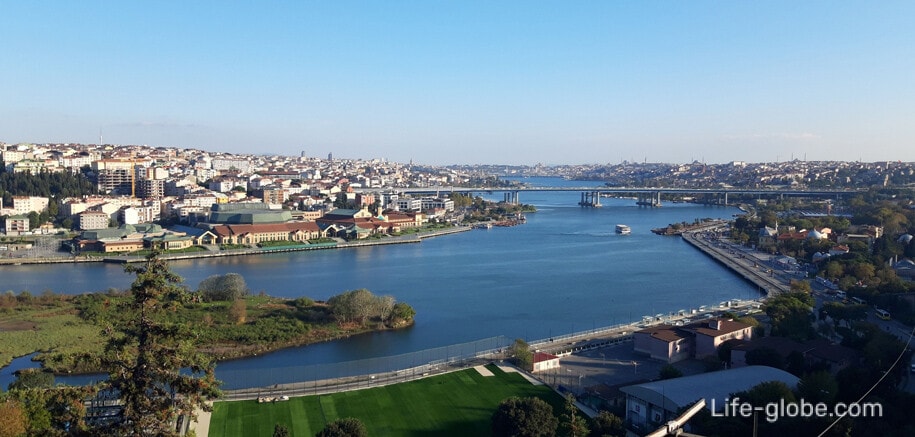
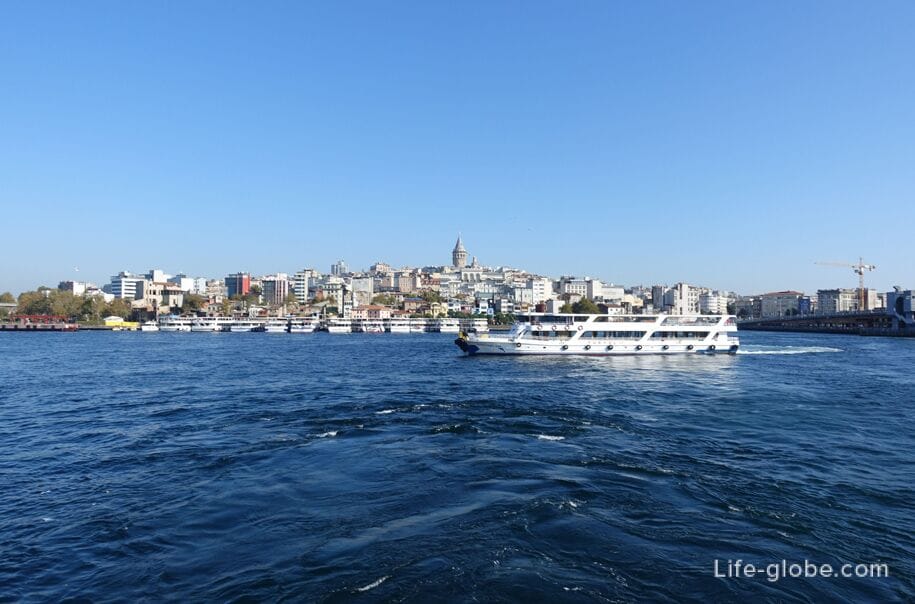
The Golden Horn is crossed by transport and pedestrian bridges that connect the Fatih district with the Beyoglu district.
The most visited and famous is the two-level transport and pedestrian Galata Bridge (Galata Köprüsü) with restaurants and observation decks on the lower tier. More about Galastky Bridge...
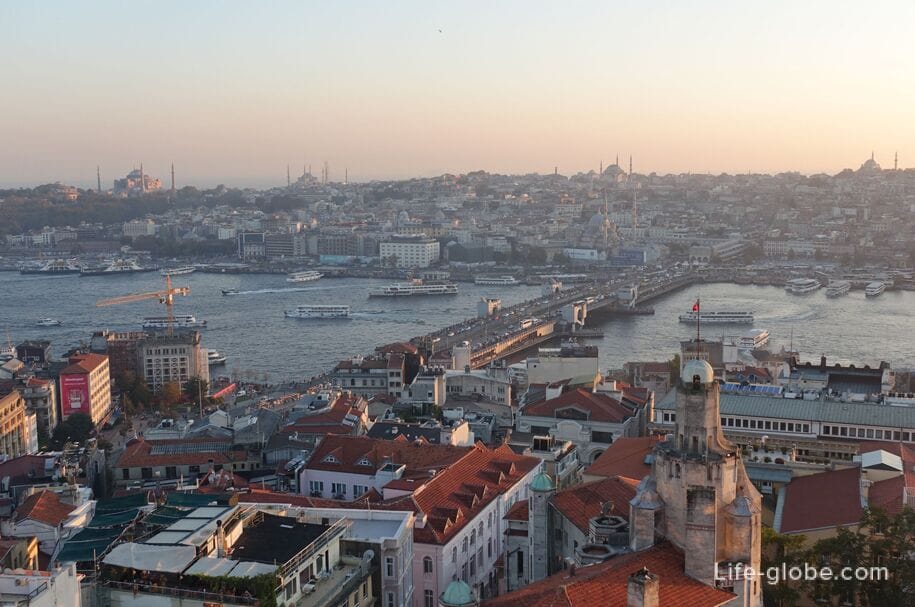

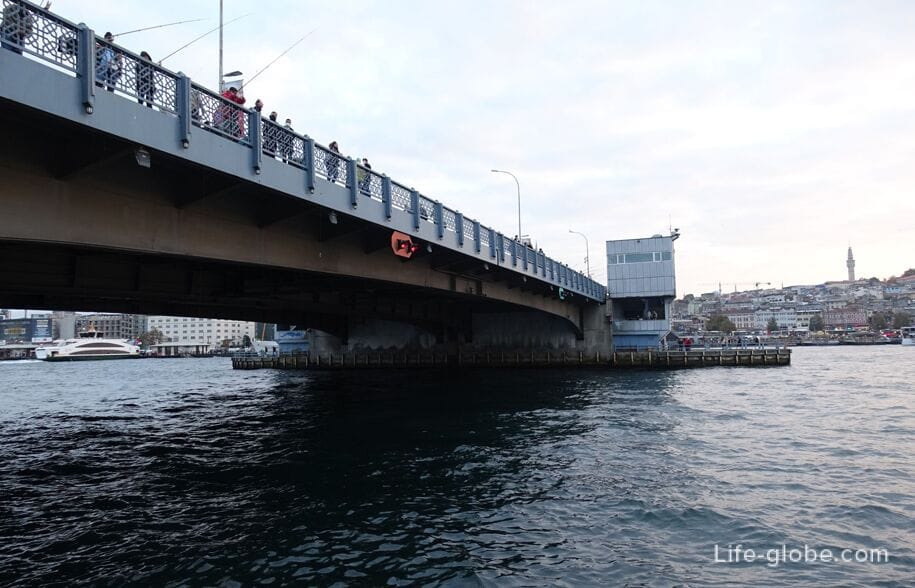
Galata Tower (Galata Kulesi Istanbul), erected by the Genoese in the middle of the fourteenth century (1348-1349), has been restored today and is one of the symbols and one of the main attractions of Istanbul.
The height of the tower is 67 meters, the diameter is 9 meters, and the height above sea level reaches 140 meters.
The tower is accessible to visitors. It houses a museum exhibition, and on the upper levels of the tower there are circular (indoor and outdoor) observation decks, giving beautiful panoramic 360-degree views of Istanbul.
Entrance to the Galata Tower and ascent to the observation deck is paid.
Galata Tower address: Bereketzade, Galata Kulesi, 34421 Beyoğlu/Istanbul.
Galata Tower website: muze.gov.tr/muze-detay. Learn more about the Galata Tower...

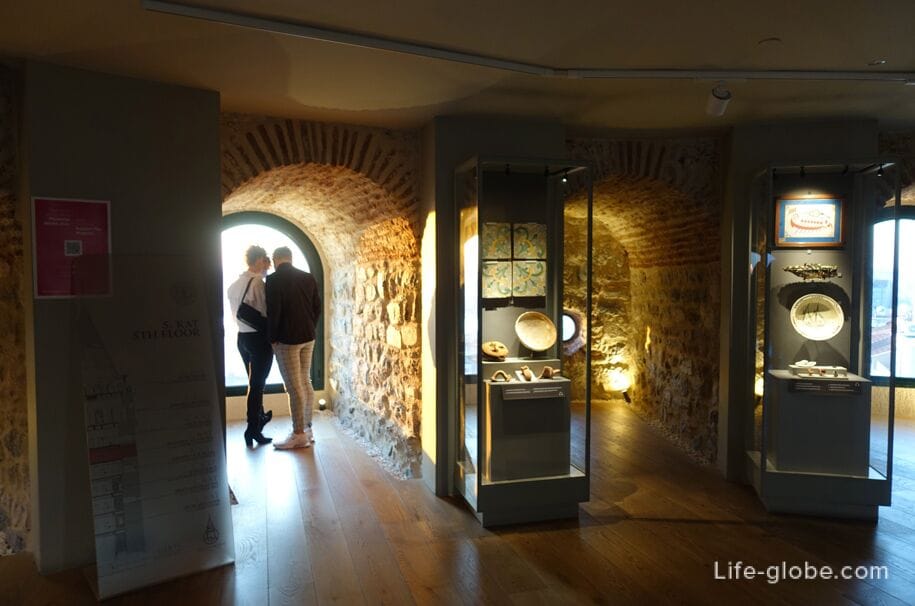
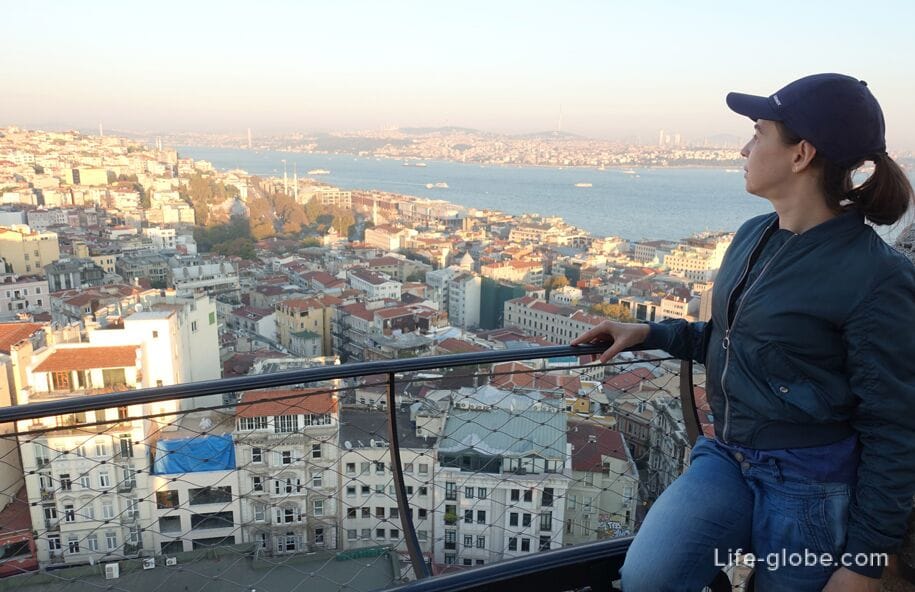
Istiklal (Istiklal Caddesi) is the most famous pedestrian shopping street in Istanbul, which attracts many tourists and locals.
Istiklal Street is 1.4 kilometers long. It stretches from Taksim Square, goes towards the Golden Horn Bay, and ends at Tunel Square, where the Beyoglu station of the historic underground funicular "Tunel" is located.
Along the street there are dense rows of buildings, including historical ones (mainly of the 19th - early 20th centuries), which were designed in neoclassical, Neo-Gothic, Renaissance, art-nova and national Turkish styles; there are also buildings in the styles of the first years of the Turkish Republic and a number of later examples of modern architecture.
There are museums in the buildings along the street today (includingIstanbul Madame Tussauds Museum), shrines, currency exchangers, nightclubs, many cafes, kebabs, bars and restaurants, shops, including famous world brands, boutiques and souvenir shops, as well as various accommodation facilities (hotels, apartments)
The historical red retro tram "Nostalgia" runs along Istiklal Street, connecting Taksim Square with Tunel Square. More about Istiklal Street...
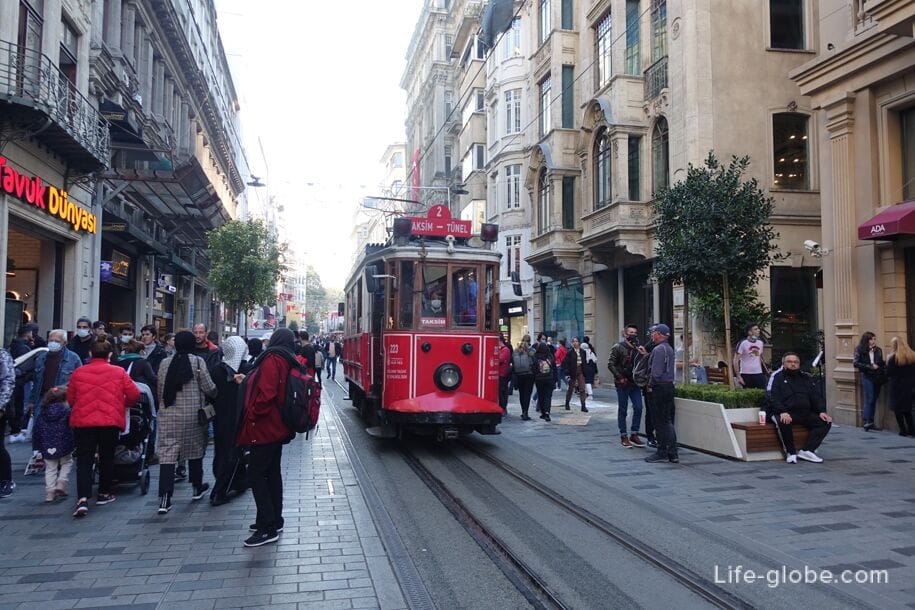
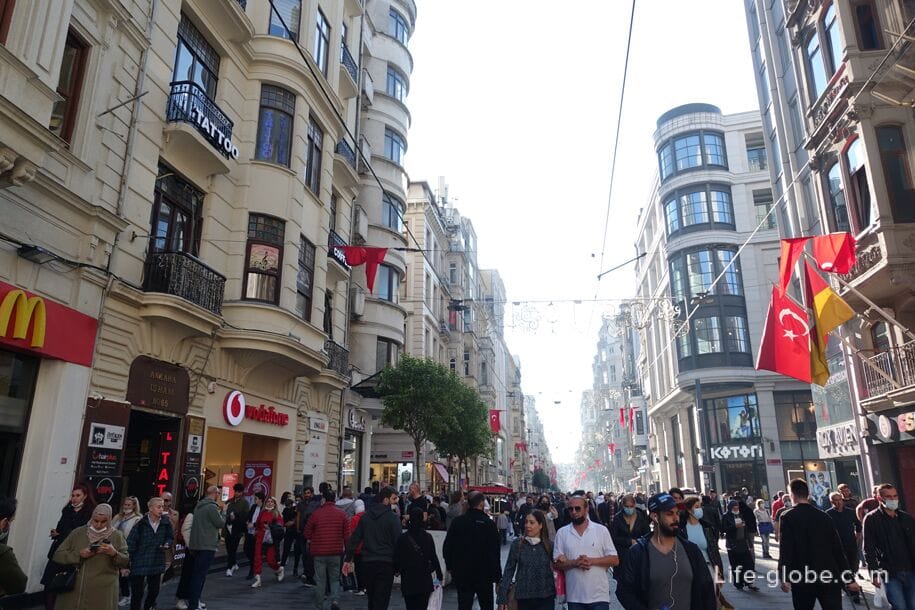
Taksim Square (Taksim Meydanı) is one of the major central squares of Istanbul, which now also acts as the main transport hub of the city and a walking area with some significant attractions.
The center of Taksim Square is decorated with an 11-meter figured monument of the Republic (Cumhuriyet Anıtı), designed by Italian architect Pietro Canonica and opened on August 8, 1928.
Also notable on the square is the Taksim Mosque (Taksim Camii), erected in 2017-2021, although the plan of the mosque on the square has been developed since 1952.
In addition Taksim square is surrounded by modern and historic (19th century) of a building, including cultural centre atatürk (Atatürk Kültür Merkezi), the 5-star The Marmara Taksim terrace with an outdoor pool, the 4-star hotel CVK Taksim Hotel Istanbul features a panoramic restaurant and the famous dessert cafe "Hafiz Mustafa 1864" (Hafız Mustafa 1864 Meydan) with delicious baklava and Turkish delight. More about Taksim Square...
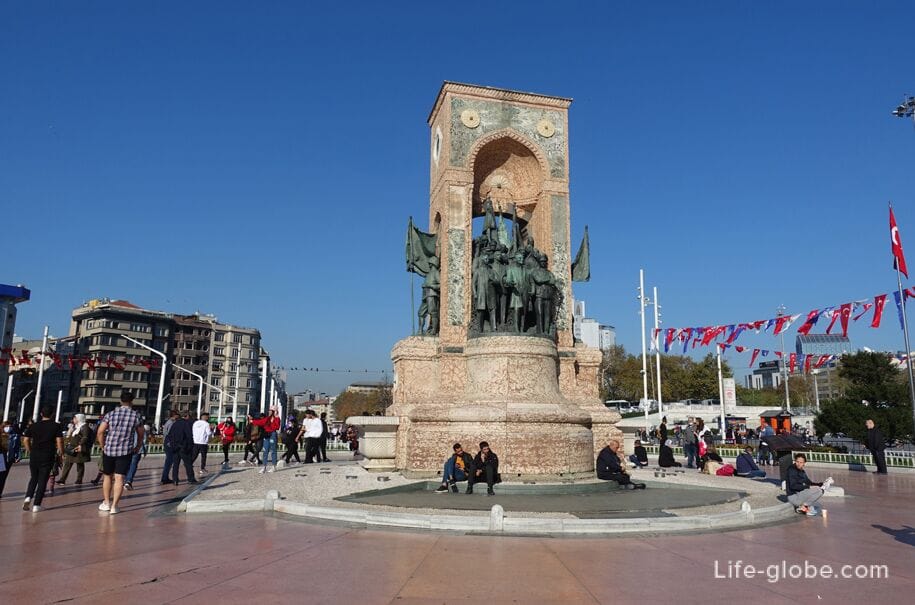


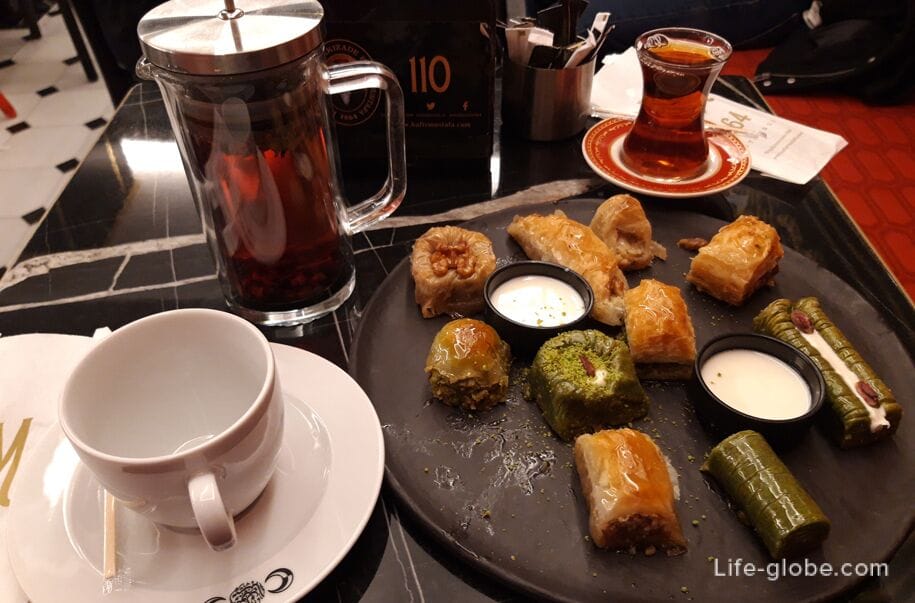
Istanbul Museum of Modern Art (Istanbul Modern Sanat Müzesi, Istanbul Modern) is an art museum where modernist and contemporary art by Turkish and foreign authors are presented, as well as there is a cinema, library, shop and cafe.
On the upper floor of the museum there is an exposition of the permanent collection, rooms for educational programs, a shop and a restaurant, and the lower floor is used for temporary exhibitions, a modern cinema "Istanbul" and a library.
The permanent collection of the museum presents works by a wide range of artists from Turkey and also works by foreign artists.
Museum address: Asmalı Mescit, Meşrutiyet Cd. No: 99, 34430 Beyoğlu/Istanbul, Turkey.
The museum's website: istanbulmodern.org .
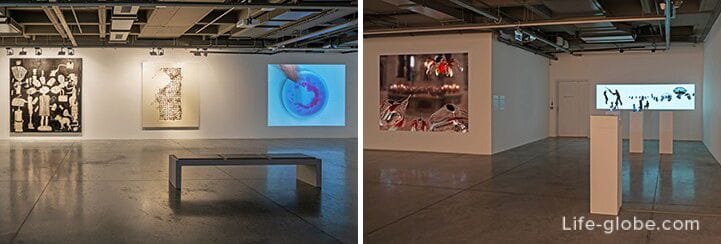
Galata Mevlevihanesi Museum (Galata Mevlevihanesi Müzesi) is a museum in a building belonging to a religious movement, where you can see ritual dances dedicated to the culture of dervishes.
Entrance to the museum is paid.
Museum address: Şahkulu, Galip Dede Cd. No: 15, 34420 Beyoğlu/Istanbul, Turkey
The museum's website: muze.gov.tr/muze-detay.

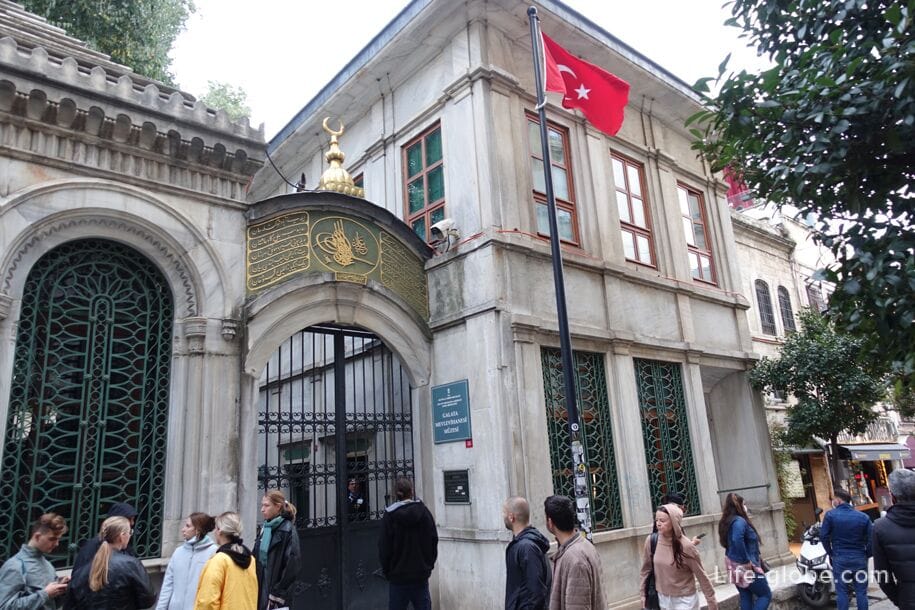
The Pera Muzesi Museum is an art museum located in the elegant building of the former Bristol Hotel, designed by architect Achille Manoussos and built in 1893.
The museum exhibits paintings and ceramics, temporary exhibitions of works by modern masters are held.
The museum pays special attention to orientalism in the art of the 19th century.
The museum's collection of Oriental paintings consists of works by European and Ottoman/Turkish artists, including works by Osman Hamdi Bey and his most famous painting "The Turtle Trainer".
The Anatolian collection of weights and measures includes more than ten thousand copies and consists of items from prehistoric times to those used in modern Anatolia. These include the main types of scales and measuring instruments used to measure weight, length and volume in every field, from land measurement to trade, from architecture to jewelry making, from delivery to pharmacy.
The collections of tiles and ceramics date back to the Kutahya Foundation of Suna and Inan Kiracha (1980s). Today the collection consists of more than 800 items representing various periods, especially the 18th and 20th centuries.
Museum address: Asmalı Mescit, Meşrutiyet Cd. No: 65, 34430 Beyoğlu/Istanbul, Turkey.
The museum's website: peramuzesi.org.tr .

Aynaly Kavak or Aynalykavak (Aynalıkavak kasrı), which is also known as the shipyard Palace, is a summer pavilion preserved from the Ottoman Sultan's palace complex and which was considered the fourth largest palace of the Ottoman Empire, after the palaces Topkapi, Dolmabahce and Beylerbeyi.
According to some sources, the construction of structures began during the reign of Mehmed II the Conqueror. Another version says that the complex is identical to the reign of Suleiman the Magnificent. The palace complex included numerous buildings and gardens. Over the course of history, the buildings were supplemented until the complex was destroyed as part of Selim's innovative movements.
Today, the preserved (now restored) Ainalikavak Pavilion is one of the most elegant legacies of classical Ottoman architecture that has survived to the present day.
Within the walls of the palace pavilion there is a museum with beautiful halls.
Entrance to the museum is paid.
Pavilion address: Keçeci Piri, Donanma Cd., 34440 Beyoğlu/Istanbul, Turkey.
Website of the museum-palace: aynalikavak-kasri.

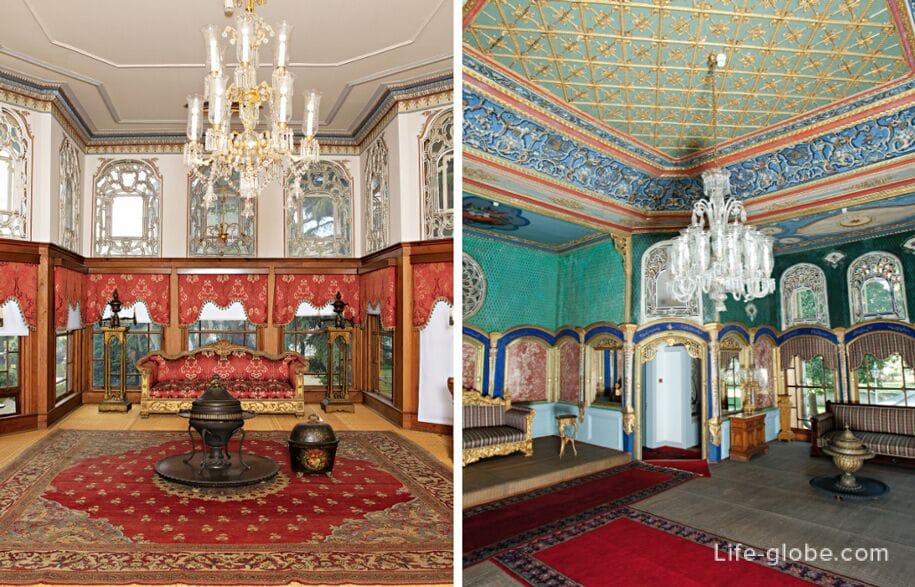
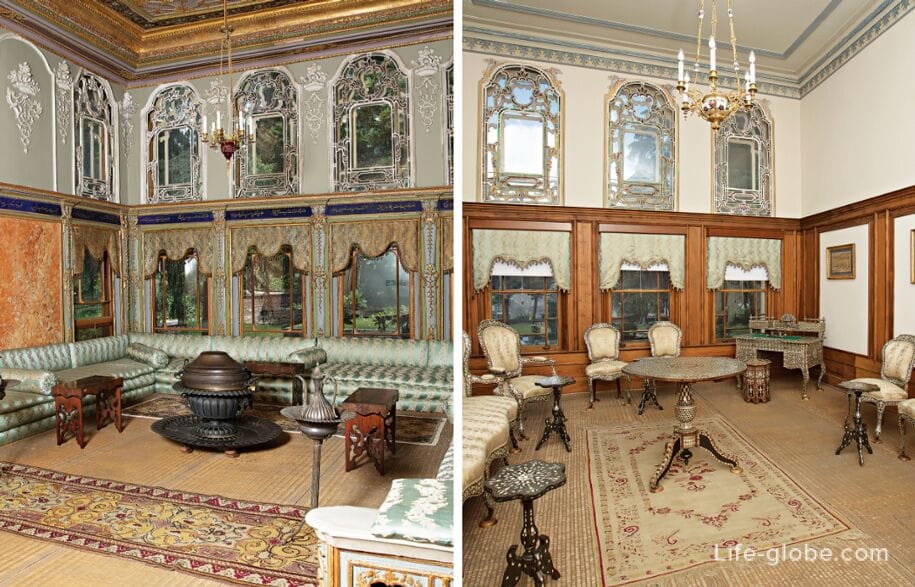
Rahmi Kocha Museum (Rahmi M. Koç Müzesi) is dedicated to the history of transport, industry and communications with a collection of cars and interactive exhibits.
During the visit, guests of the museum will learn about its founder - Turkish philanthropist, collector and millionaire Rahmi Mustafa Koc, a representative of one of the richest dynasties in Turkey.
The museum's exposition mainly consists of the personal collection of the creator, from ancient gramophone needles to steam locomotives. There are also vintage cars, motorcycles and an Istanbul tram, scientific instruments, toys, models, communications equipment and even an American submarine. In the practical gallery, you can sit in the cockpit of an airplane, drive an old car, or conduct scientific experiments.
Entrance to the museum is paid.
Museum address: Piri Paşa, Aziz Sk. No: 5, 34445 Beyoğlu/Istanbul, Turkey.
The museum's website: rmk-museum.org.tr .
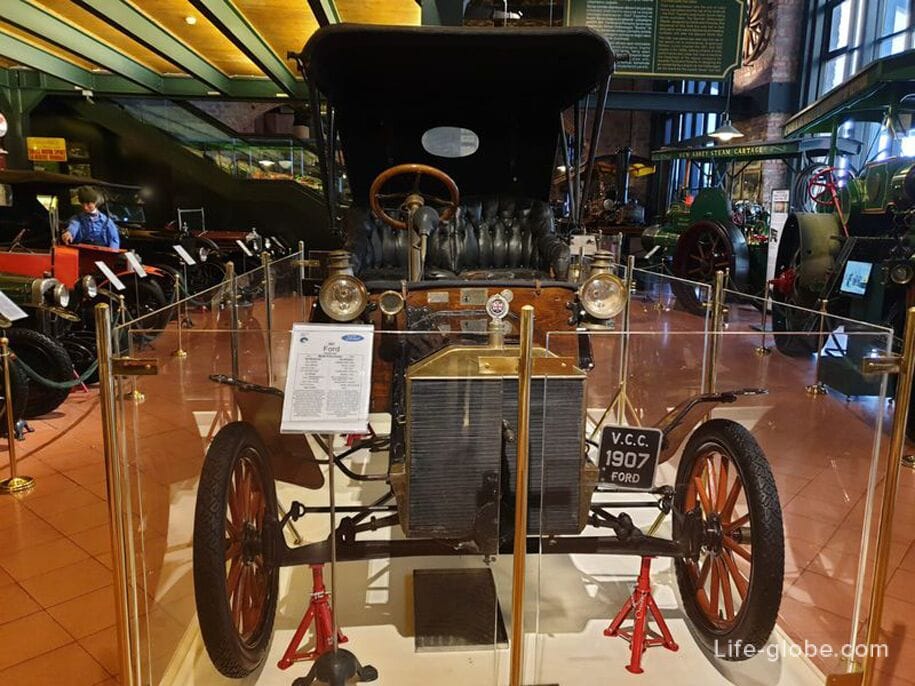
Miniaturk Park is a theme park created under the slogan "A small model of a big country" in which there are miniature copies of Turkish attractions, from the Blue Mosque and Topkapi Palace to the white terraces of Pamukkale, the temple of Armetida and the Mausoleum of Halicarnassus.
In the park there are miniature models of 136 architectural works, including 60 works from Istanbul, 63 works from Anatolia and 13 works from Ottoman geography outside Turkey, reduced to a factor of 1:25.
Entrance to the park is paid.
The address of the park is: Ernektepe, Imrahor Cd. No: 7, 34445 Beyoğlu/Istanbul, Turkey.
The park's website: miniaturk-istanbul-muzeleri-bilet/488216.
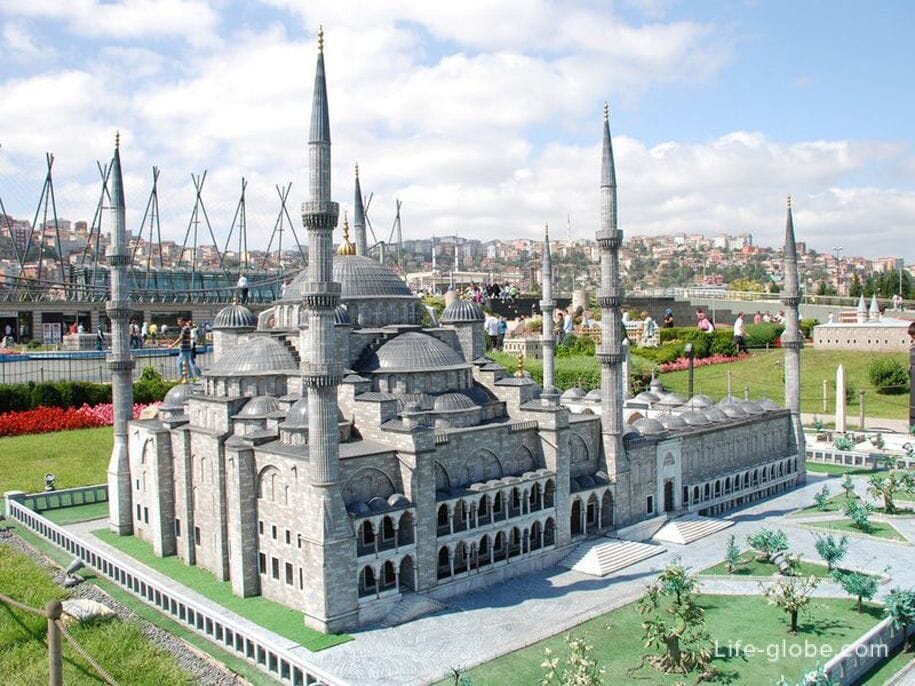
The Bosporus (Bosfor, Bosporus, Istanbul Boğazı / Istanbul Bogazi) is a strait in Istanbul and its surroundings, which is an intercontinental strait dividing Europe and Asia, as well as connecting the Black Sea with the Marmara.
Most of the shores of the Bosphorus Strait, with the exception of those in the north, are densely populated sides of the city of Istanbul.
The Bosphorus is crossed by the Bosphorus bridges, and along its waters there are walking embankments, there are park areas, cafes and restaurants, as well as accommodation facilities (hotels, apartments)
The Bosphorus is one of the main attractions of Istanbul and its "breath", filled with the cry of seagulls, the sound of waves, pleasure boats, and attractive buildings, including historical palaces, fortresses, mosques and yalas (mansions built directly on the shore), are located on both sides of the Bosphorus.


Small ferries and yachts ply the Bosphorus Strait.
You can enjoy the views of the Bosphorus and its shores from the water by taking an excursion walk through the reservoirs of Istanbul, or from ferries that function as public transport in Istanbul (Istanbul transport cards are valid) and connect both the shores of the Bosphorus itself and the Bosphorus with the shores of the Golden Horn. Ferry berths are located both on both shores of the Bosphorus and the Golden Horn Bay. Learn more about the Bosphorus...
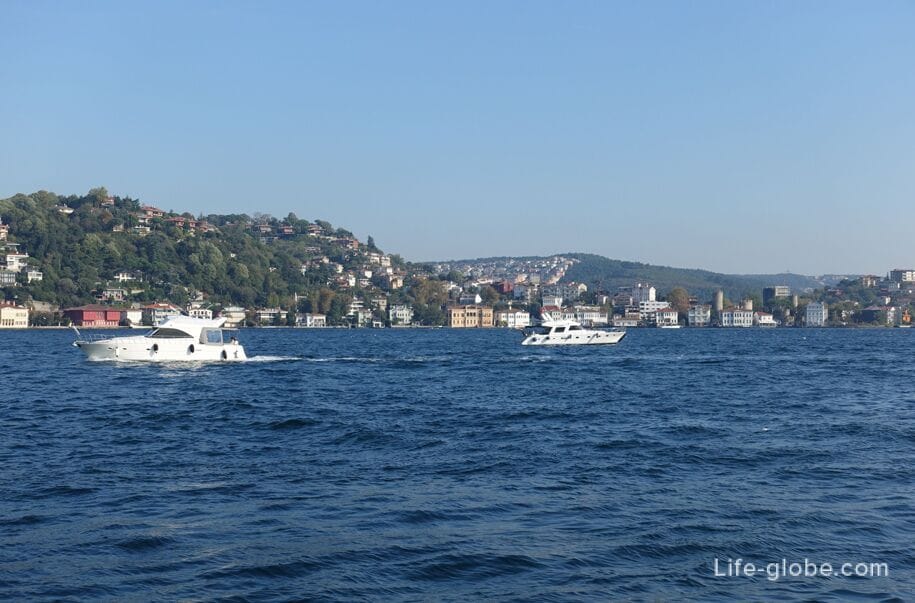
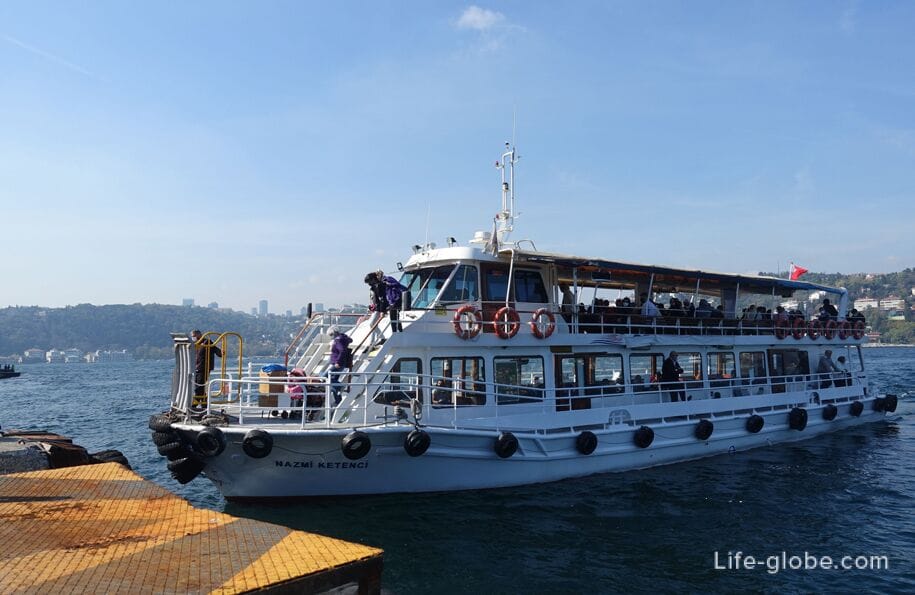
Dolmabahce (Dolmabahçe Sarayı) is a magnificent palace complex of the 19th century, which served as the residence of the Ottoman sultans, and today is one of the most visited sights of Istanbul.
Dolmabahce Palace was built in 1843-1853 by order and for Sultan Abdul-Majid I, who considered the Topkapi Palace operating at that time to be out of date, and wanted to erect a new palace for permanent residence, which in architecture and luxury would not be inferior to the exquisite European residences of influential people.
Today, the Dolmabahce Palace is a Museum where you can visit the garden overlooking the waters of the Bosphorus Palace rooms, consisting of: official public part of the "Selamlik" (Selamlık) with function hall (Tören Salonu), Harem (the Harem), or the family part of it; and the clock Museum and the Museum of painting and sculpture (Resim ve Heykel Müzesi).
Entrance to the palace is paid.
Address of Dolmabahce Palace: Vişnezade, Dolmabahçe Cd., 34357 Beşiktaş/Istanbul, Turkey.
Dolmabahce Palace website: dolmabahce-sarayi. More about Dolmabahce Palace...
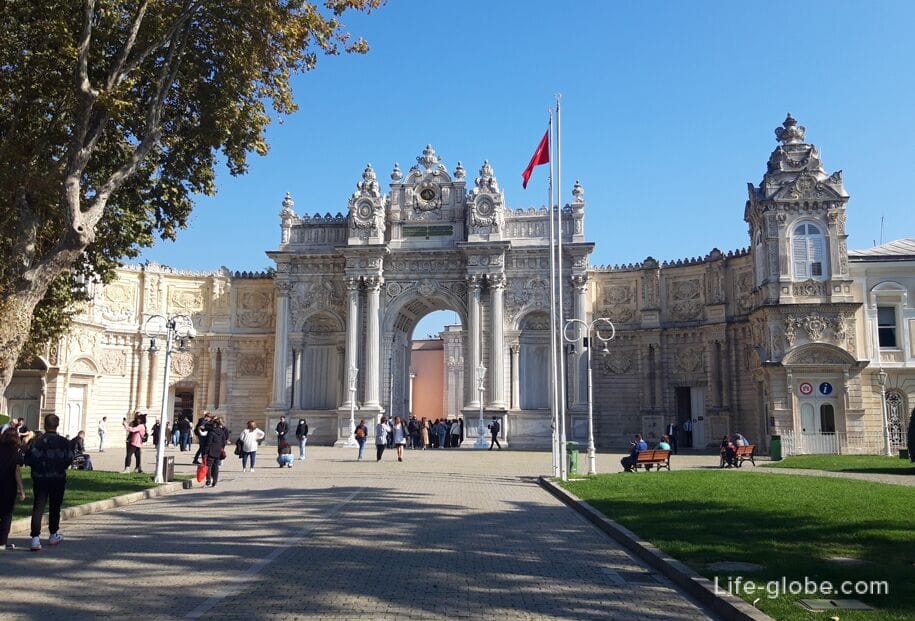



Near the current tourist entrance to the Dolmabahce Palace (in general access - without payment), there is a Clock Tower (Dolmabahce Saat Kulesi), which was commissioned by Sultan Abdulhamid II and designed by the court architect Sarkis Balyan in the period from 1890 to 1895.
The clock tower was made by the French watch house of Jean-Paul Garnier and installed by the court watchmaker Johann Mayer.
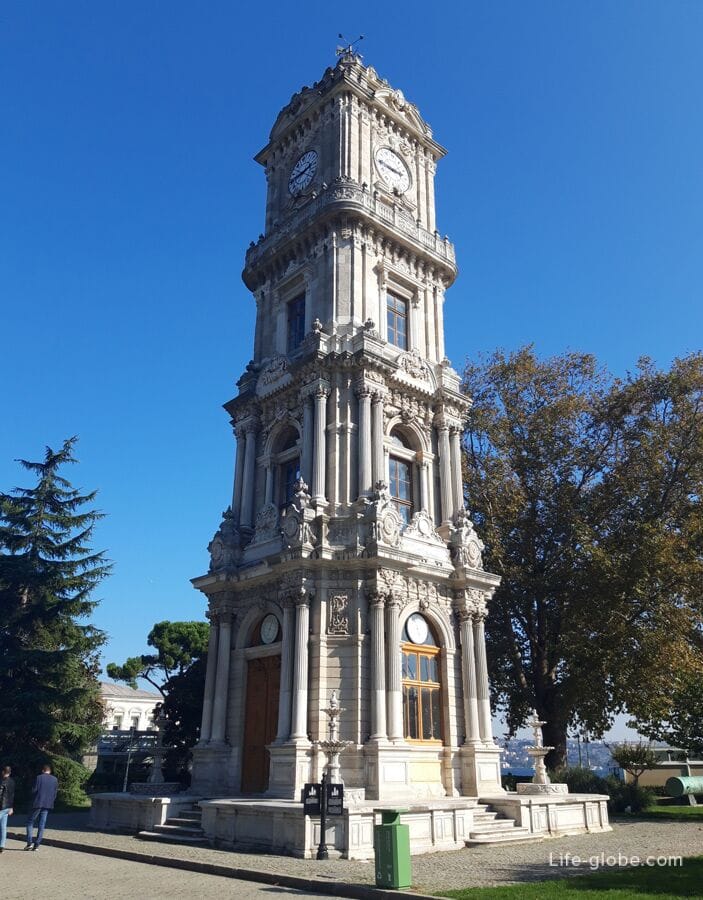
The Museum of Palace Collections (Saray Koleksiyonları Müzesi) is located in the building of the former kitchens of the Dolmabahce Palace and was created by transferring about 20,000 items that the visitor could not see in the furnished rooms of the Dolmabahce Palace.
The main theme of the Museum of Palace Collections is to identify original objects that were used in everyday life in the Ottoman palaces of the 19th century, especially in the Dolmabahce Palace, and in the inventory of national palaces, and make them open to visitors.
Among the exhibited objects: clothing princes and princesses, toys, Handicrafts, stationery used by the sultans, print, epitaphs, samples writing utensils used in the Parliament and the first Grand national Assembly of Turkey, medication, dentist office, shaving sets of silver belonging to the sultans, equipment for cleaning and maintenance Valide-Sultanov, dishes made of crystal, porcelain and silver, manuscripts of the Koran, carpets Hereke, porcelain Yildiz, watches, porcelain furnace, books from the Palace library, drawing tools and materials belonging to the Caliph Abdulmecid Efendi, a collection of oil paintings, lighting and decorative tools.
Entrance to the museum is paid. It is paid separately from the entrance to the Dolmabahce Palace.
Museum address: Vişnezade, Dolmabahçe Cd., 34357 Beşiktaş/Istanbul, Turkey.
Museum website: saray-koleksiyonlari-muzesi.
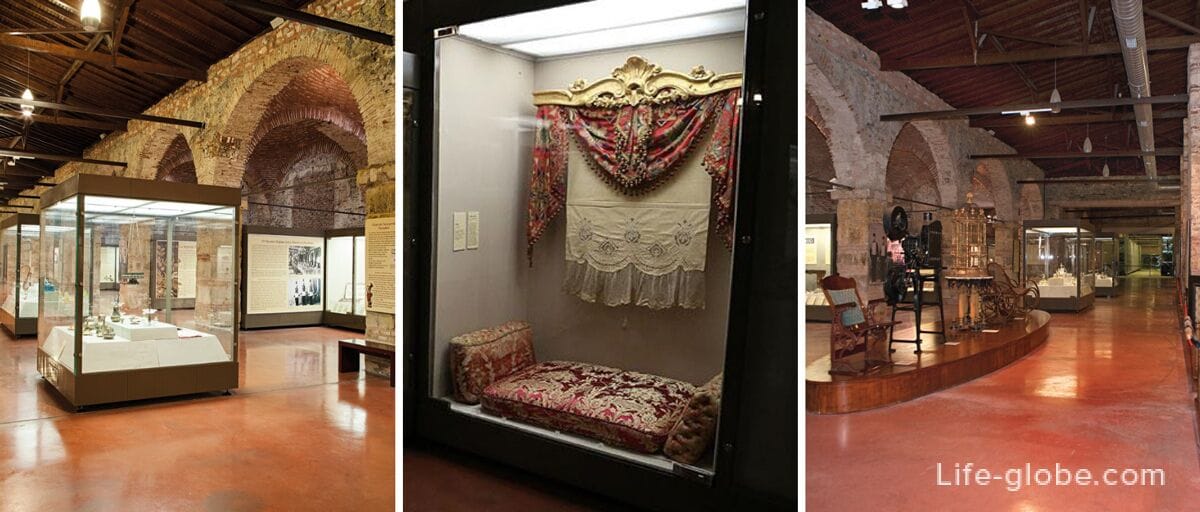

The Naval Museum (Deniz Müzesi) is a museum of the history of Turkish navigation, where ships of the Ottoman era and ancient diving equipment are presented.
The museum is the most outstanding naval museum in Turkey, and by the richness of its collections it is one of the outstanding museums in the world.
Museum address: Sinanpaşa, Beşiktaş Cd. No: 6 D: 1, 34353 Beşiktaş/Istanbul, Turkey.
The museum's website: denizmuzesi.dzkk.tsk.tr/en.
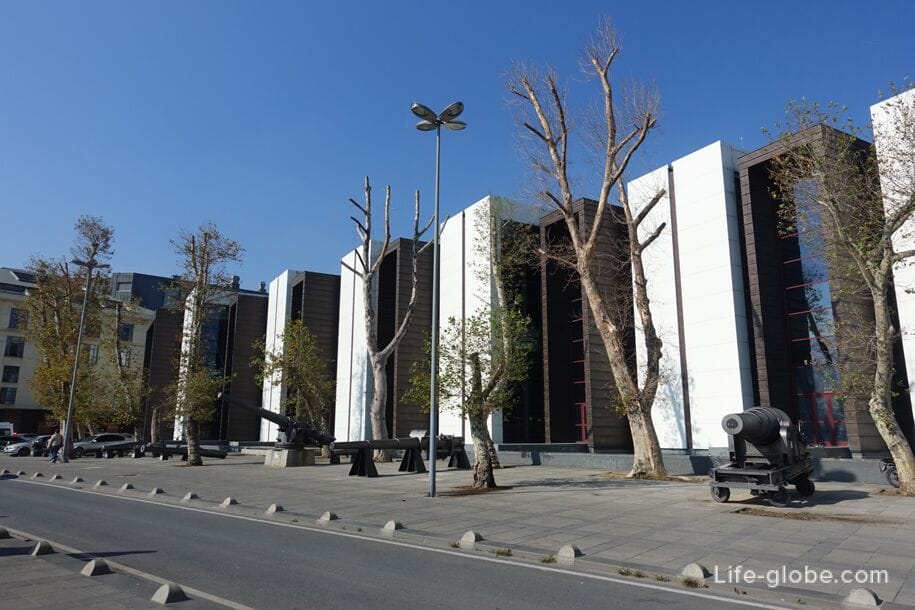
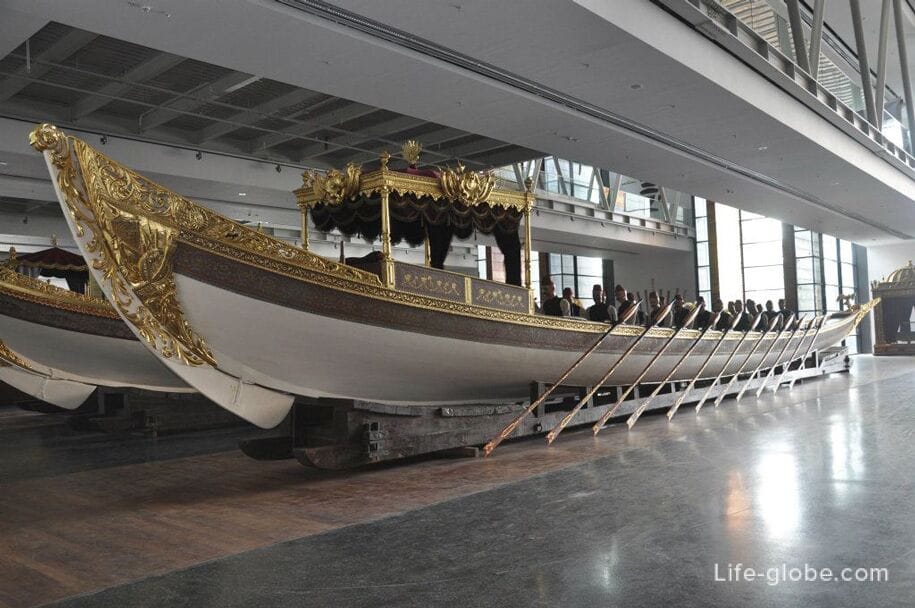
Ihlamur (Ihlamur Kasrı) is a former summer residence of the sultans of the Ottoman Empire, used for recreation, and built in 1849-1855 by order of Sultan Abdul-Majid I.
It was a small palace complex consisting of two buildings: a ceremonial or ceremonial (Merasim Köşkü, Merasim) and private chambers or harem (Maiyet Köşkü, Mayet).
Bright features and spectacular neo-Baroque decorations are visible in the architecture, which makes the complex one of the most elegant examples of Ottoman buildings of the 19th century.
Today it is a museum with an interior palace decoration with halls and rooms and the surrounding garden and forest area with a lake.
Entrance to the park and museum is paid.
Address of the complex: Teşvikiye, Nişantaşı Ihlamur Yolu Sk., 34357 Şişli/Istanbul, Turkey.
Museum website: ihlamur-kasirlari.

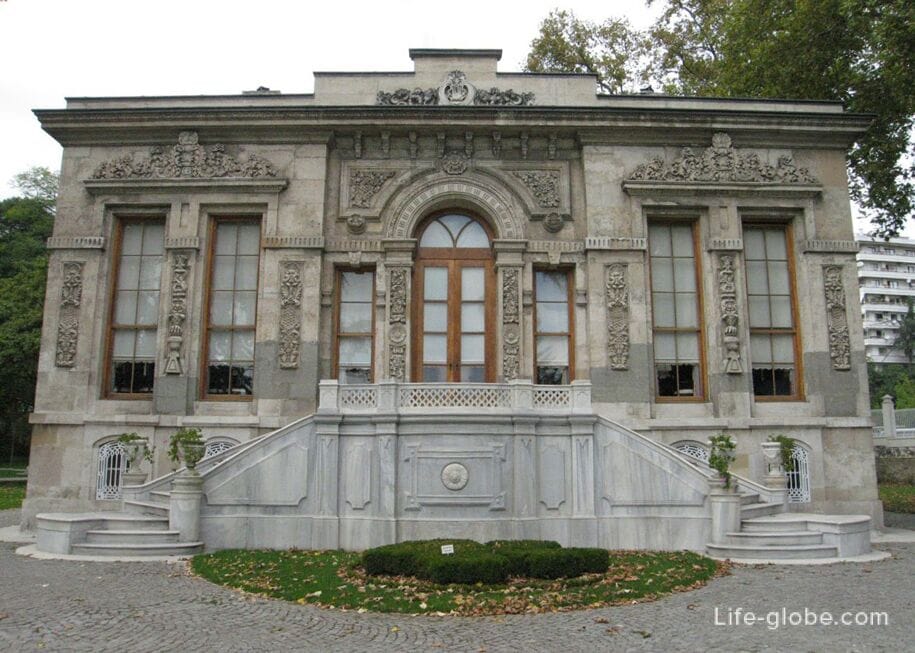

Yıldız is a large Sultan's historical palace and park complex of the 19th century, which includes the palace of the same name and a park with pavilions.
The Yildiz Palace (Yıldız Sarayı, which translates as "Star Palace") was first built by Sultan Selim III for his mother Mihrishah Sultan (Gyurju Gyuzeli).
The palace was used as the main palace of the Ottoman Empire during the reign of the last sovereign ruler of the Ottoman Empire - Sultan Abdulhamid II (since 1889), after the Sultan left the Dolmabahce Palace due to dramatic events and for security reasons.
Now the palace is used by the president (perhaps someday the palace will be reopened to visitors and then the palace can be classified as the best palaces in Istanbul; we recommend checking the information on the official websites).
Yildiz Palace website: yildiz-sale.
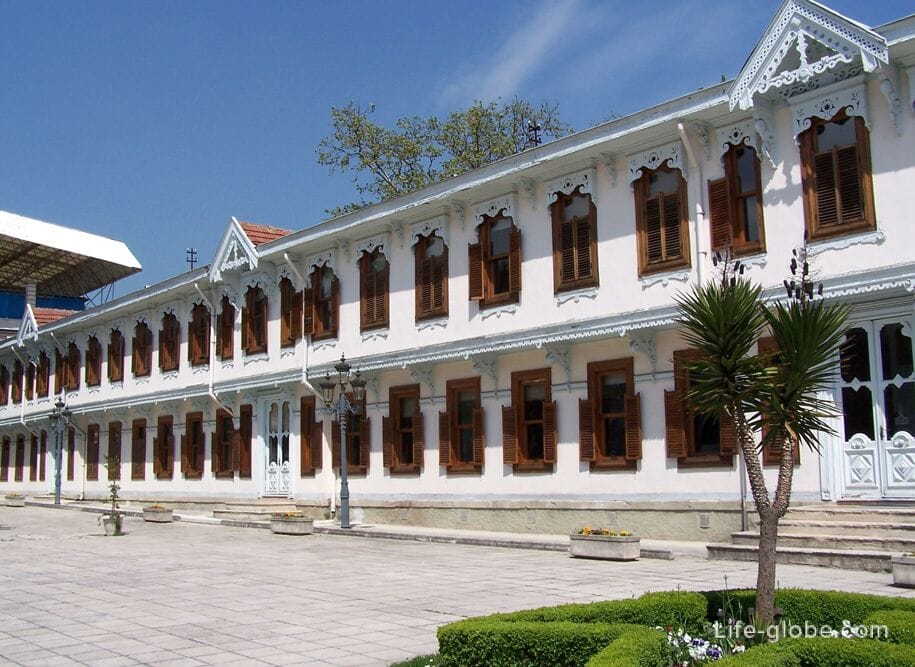
Near Yildiz Palace stretches Yildiz Park (Yıldız Parkı), which formerly adjoined to the Palace and was part of the ensemble of the Palace, and today it is one of the major public historical parks of Istanbul, and lush vegetation, historic pavilions, gazebos, children's and sports playgrounds, toilets, places for recreation and walks, ponds, artificial ponds, fountains, bridges, waterfalls, sculptures and cafes.
Among the buildings of Yildiz Park stand out: the Chadir Pavilion (Çadır Köşkü), built in 1871 at the request of Sultan Abdulaziz and the Malta Pavilion or Maltese Pavilion (Malta Köşkü), which was designed by architect Sarkis Balyan and which now houses a cafe.
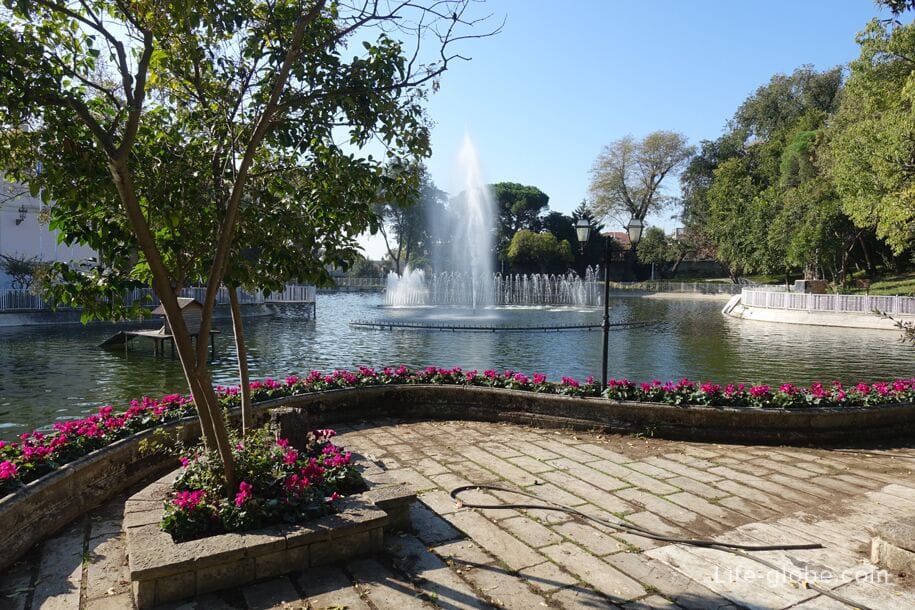
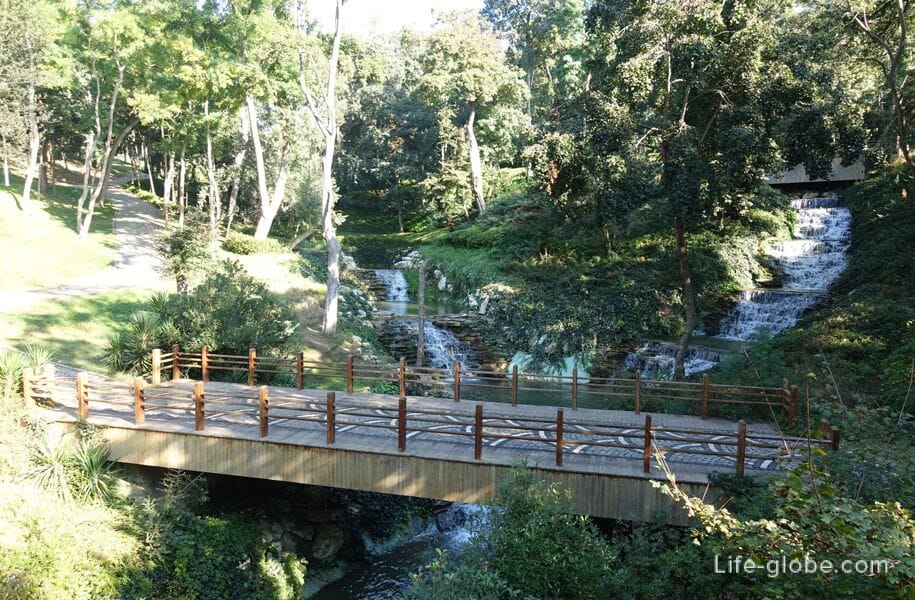
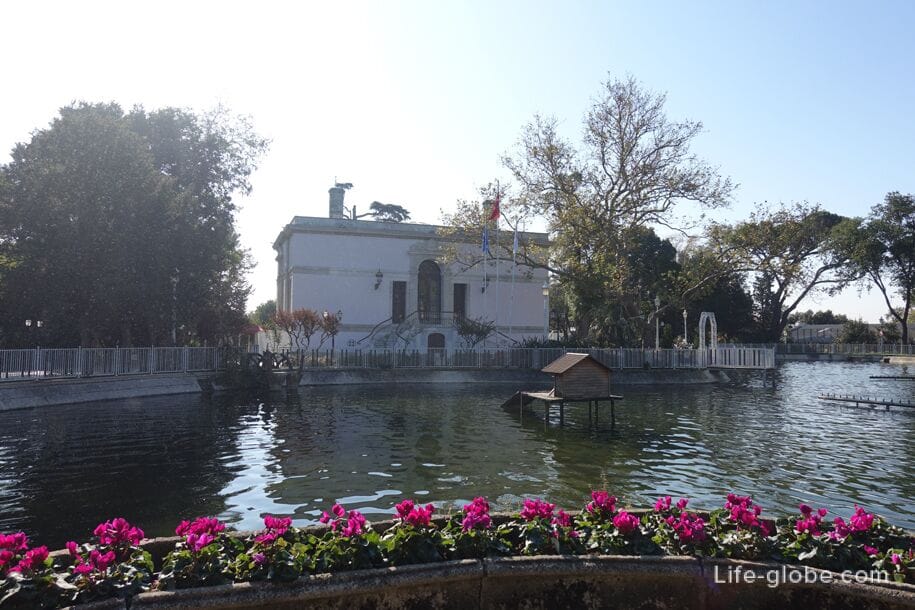

On the outskirts of Yildiz Park there is an active historical porcelain factory Yildiz (Yıldız Çini Ve Porselen Fabrikası), which was opened in 1895 and produced ceramics to meet the needs of the upper class in the European style. The factory produced bowls, vases and plates, which often depicted a view of the Bosphorus. The building had a look reminiscent of medieval castles.
Entrance to the museum-factory is paid. Museum website: yildiz-cini-ve-porselen-fabrikasi.
Entrance to Yildiz Park is free. More about Yildiz Palace and Park...
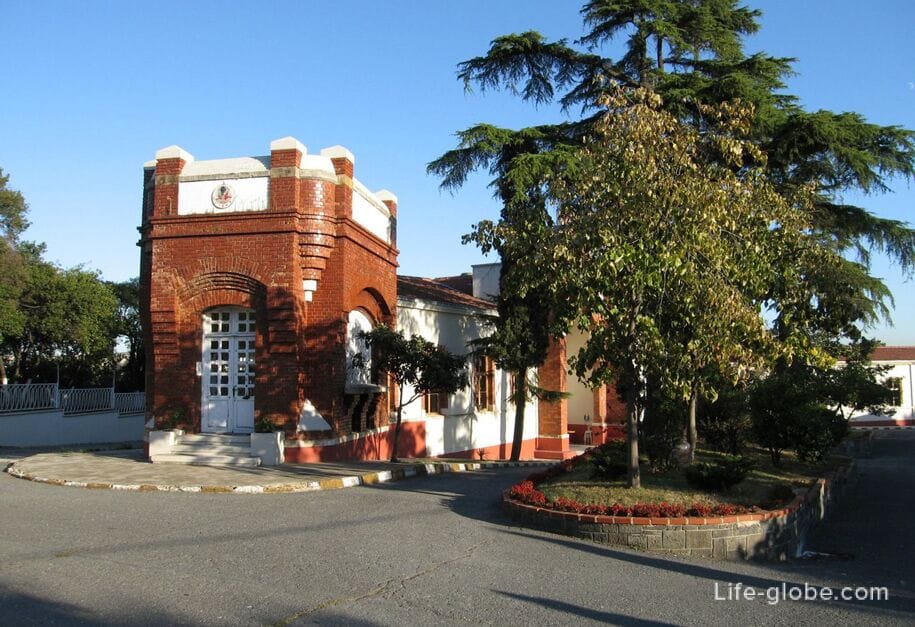
The Ortakoy camii Mosque, also known as the Grand Mosque of the Medjidiye (Büyük Mecidiye Camii), is a very popular mosque in Istanbul and primarily due to the fact that it looks like a small sultan's palace and is located near the waters of the Bosphorus Strait, which makes the mosque one of the most photographed attractions in the city.
The mosque was built in the Ottoman Baroque style in 1853-1854 by decree of Sultan Abdul-Majid I.
The mosque has two minarets.
The mosque is located in the eponymous quarter (district) Ortakoy of the large district of Besiktas (Beşiktaş), at the address: Mecidiye, Mecidiye Köprüsü Sk. No: 1 D:1, 34347 Beşiktaş/Istanbul, Turkey. Learn more about the Ortakoy and Besiktas districts...
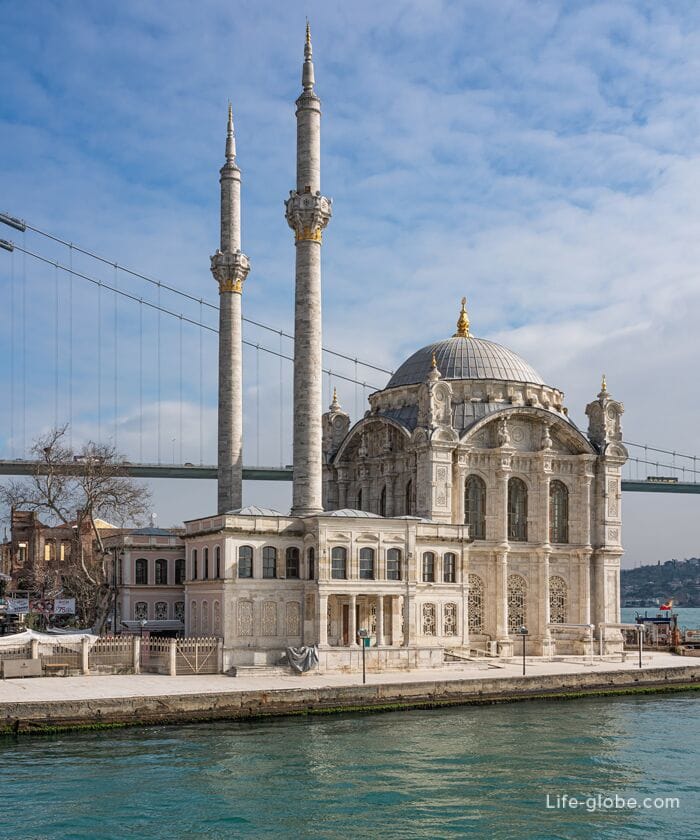
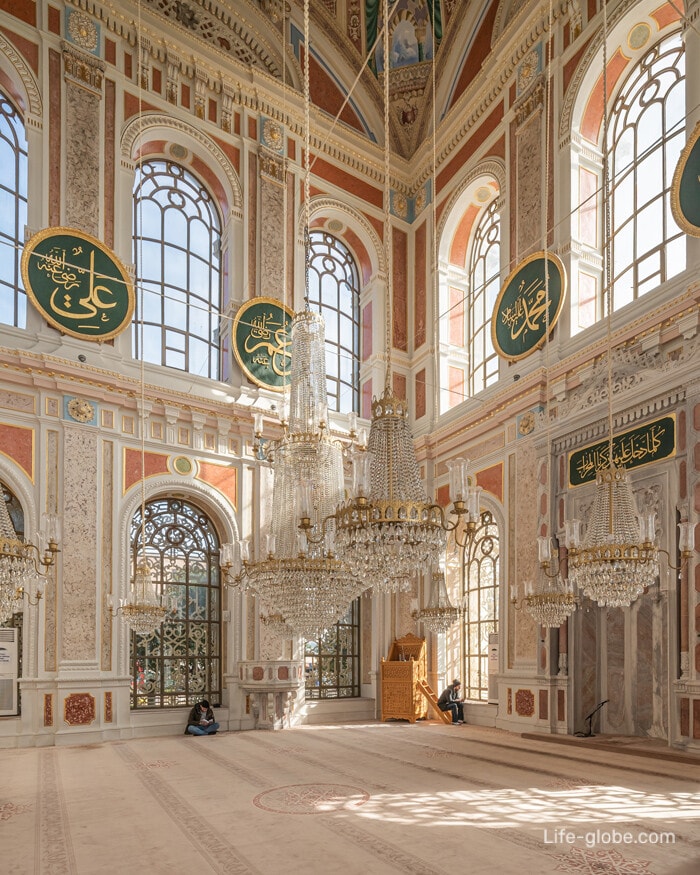
Park Ulus (Ulus Parkı) is a small quiet park on a hill from which beautiful views of the Bosphorus open.
The park has panoramic cafes, places for walking and relaxing.
Entrance to the park is free. Learn more about Istanbul parks and gardens...
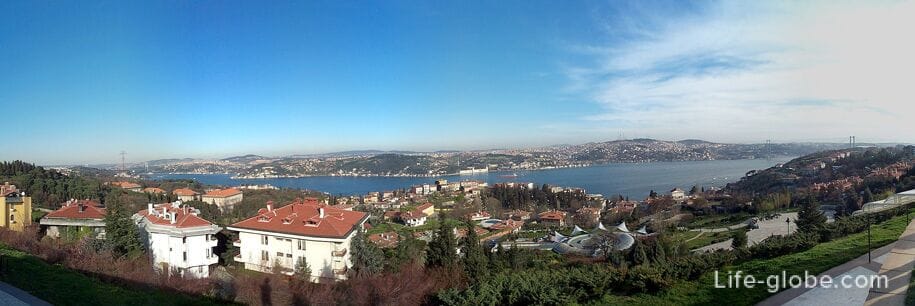
Bebek and Arnavutköy are two historical districts (quarters), which are elite and one of the most picturesque areas of Istanbul and are part of the Besiktas district.
Arnavutkey and Bebek border each other (one area flows smoothly into another) and are located along the waters of the Bosphorus Strait.
The districts attract attention with elegant low historical buildings, narrow streets and an abundance of catering.
Arnavutkoy can not boast of attractions, but the main attractions Bebek include: mansion of Ali Pasha or Walid Pasha (Âli Pasha Mansion, now the Consulate of Egypt), designed by Raimondo D Aronco; mosque Bebek (Bebek Camii), built in 1913; and the Museum of Asiyan (Aşiyan Müzesi) - the house of famous Turkish poet Tevfik Fikret, built in 1906 and was later converted into a Museum.
Since the districts are located on hills, in the warm season they are surrounded by greenery, which makes them even more picturesque. Especially beautiful views of the districts open from the waters of the Bosphorus, when the districts look like tiny fairy-tale villages, whose houses come close to the water. Learn more about the districts of Arnavutkey and Bebek...
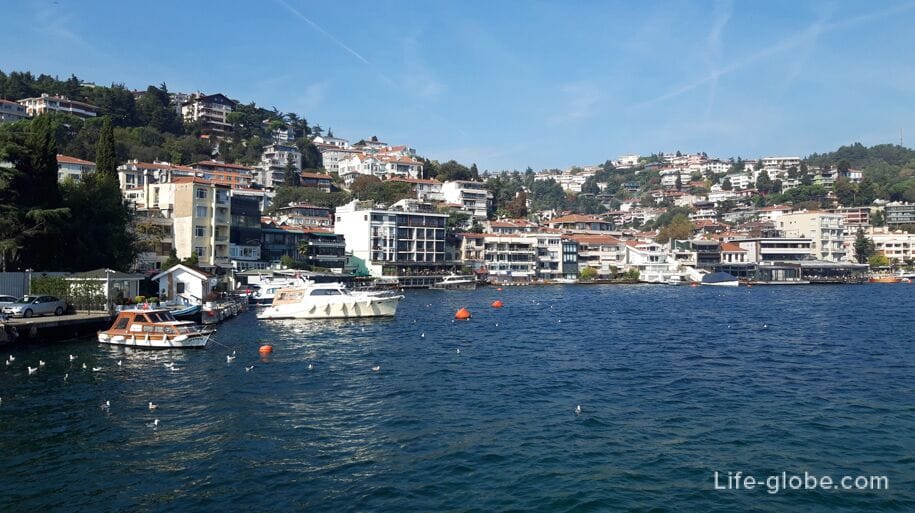
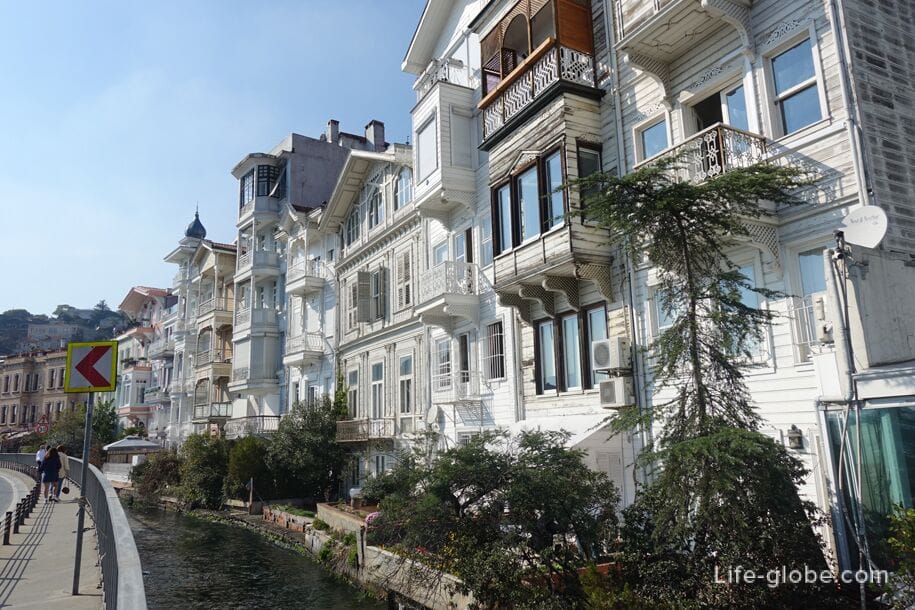
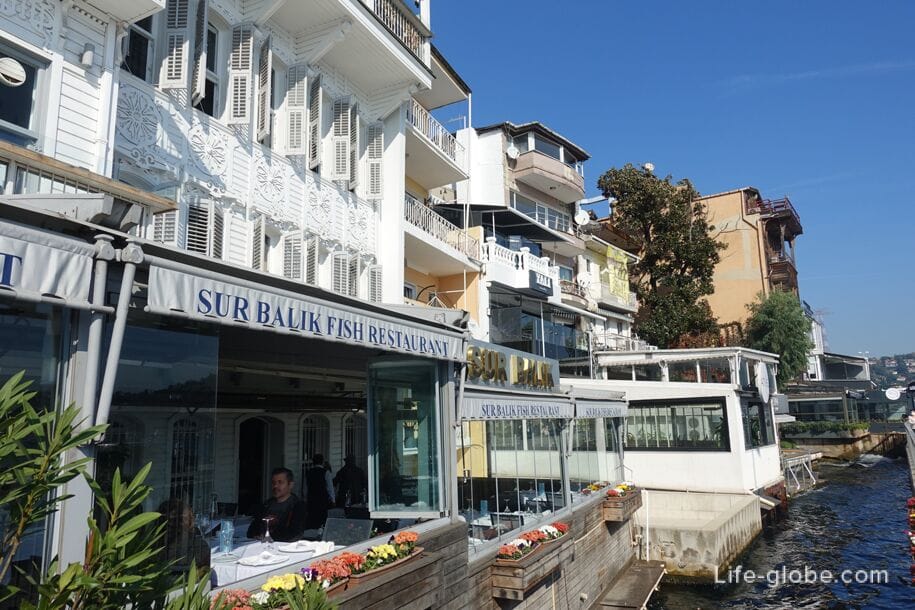

Rumeli Hisarı (Rumeli Hisarı) is a medieval fortress built in 1452, which is now a museum, occupies an area of 30 hectares, surrounded by defensive walls with towers and gates.
There are hiking trails on the territory of the fortress, there is a functioning mosque and a small cistern. The fortress offers panoramic views of the Bosphorus, Sultan Mehmed Fatih Bridge and the Asian part of Istanbul.
Entrance to the fortress is paid.
Fortress address: Rumeli Hisarı Yahya Kemal Caddesi No.:42 34470 Sariyer/ISTANBUL.
Website of the fortress museum: muze-detay/rumeli. More about the Rumelikhisar Fortress...

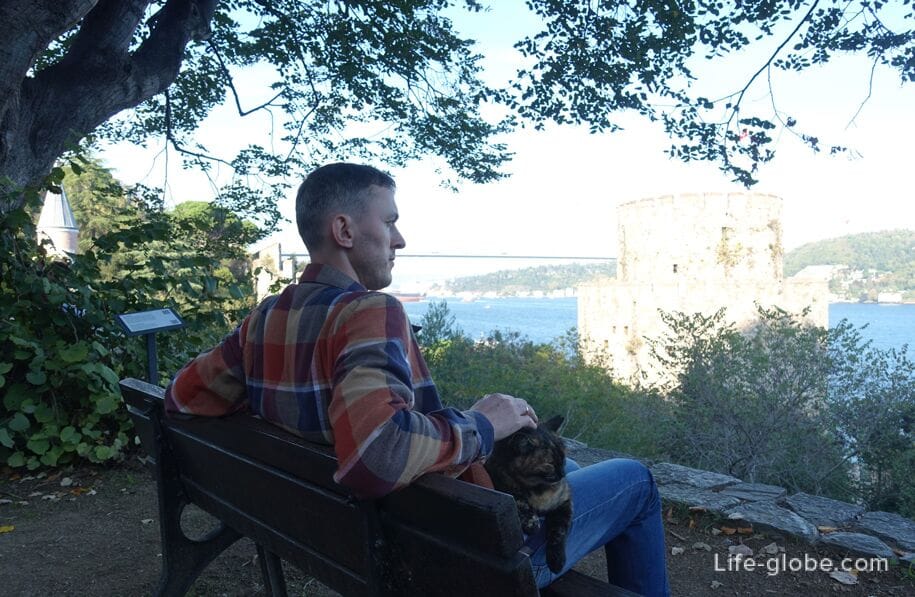
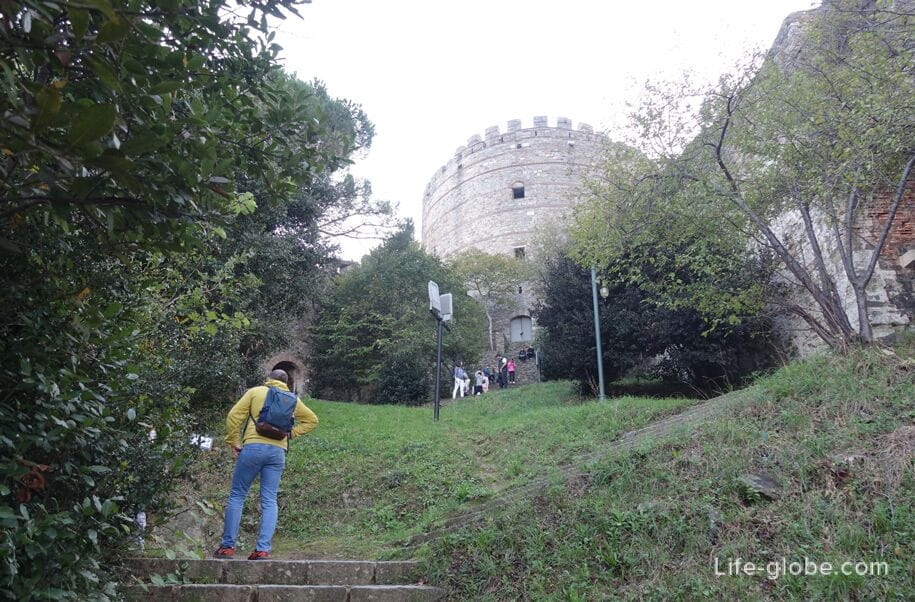
The Ataturk House Museum (Atatürk Müzesi) is a museum dedicated to the life of the first president of Turkey - Mustafa Kemal Ataturk.
The museum is located in a historic three-storey house built in 1908, which Mustafa Kemal rented after returning from the Syrian Front and lived there with his mother, sister and adopted son until May 16, 1919, the day when he sailed on the ship "Bandyrma" to Samsun, on his way to the headquarters of the Inspection of troops of the 9th Army in Erzurum.
The house where some of Ataturk's personal belongings were kept was bought by Istanbul Municipality in 1928 and transformed into a museum, opened to visitors in 1942 as the Ataturk Revolution Museum.
The museum presents Ataturk's personal belongings, such as clothes; there are collections with paintings, medals and other exhibits.
Address of the house-museum: Meşrutiyet, Halaskargazi Cd. No: 140, 34363 Şişli/Istanbul, Turkey.
Website: ataturk-muzeleri.
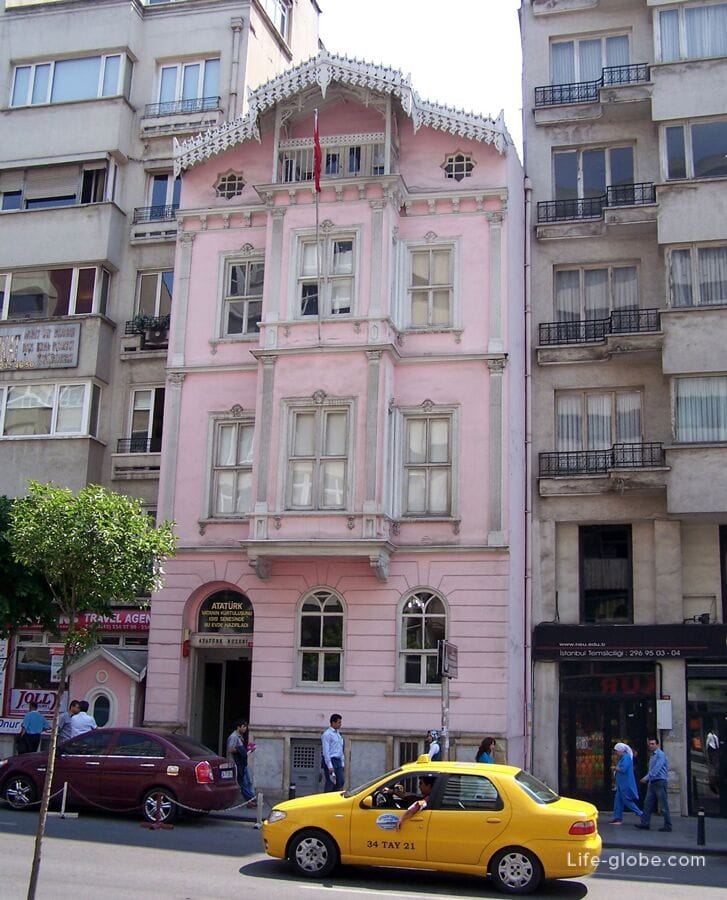
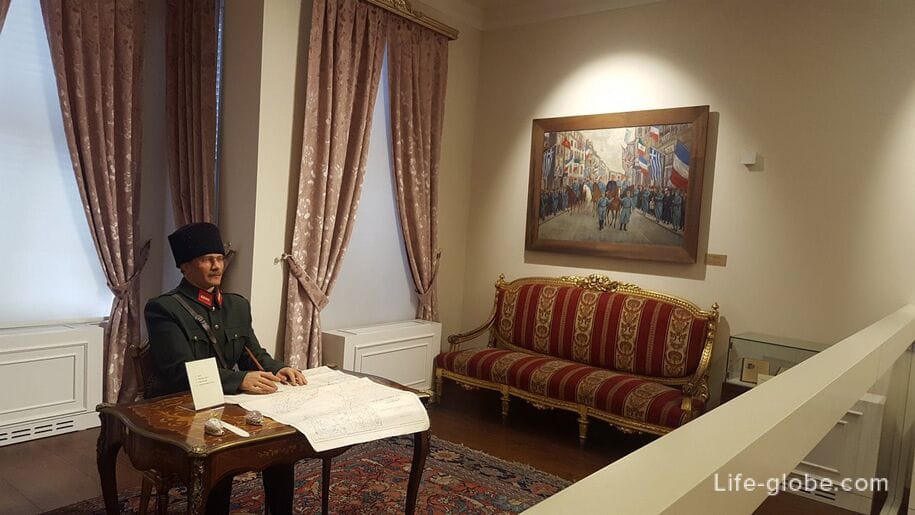
The Museum of Military History (Hisart Canlı Tarih ve Diorama Müzesi) is a museum of military history and cultural heritage of the Ottoman Empire of 1453-1923.
The museum exhibits military and ethnographic historical artifacts of the Ottoman period of 1453-1923, as well as dioramas and mannequins depicting the corresponding periods of history.
Museum address: Hürriyet Mah. Cemil Bengü Cad. No: 21 34403 Çağlayan / İstanbul / Türkiye.
The museum's website: hisartmuseum.com/tr .
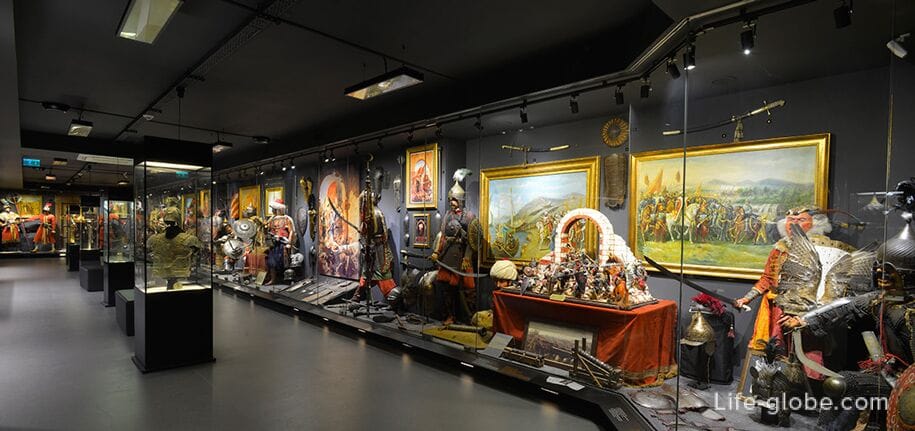
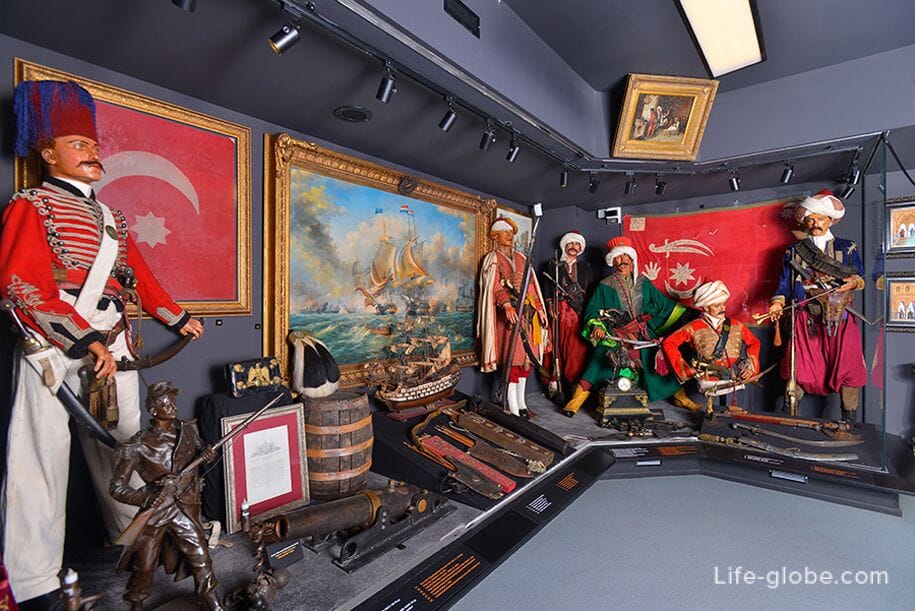

Sapphire is a high and impressive observation deck of Istanbul, which is located in the Sapphire skyscraper (Istanbul Sapphire AVM), which is also a shopping center.
On the top - 54th floor of the skyscraper, at an altitude of 236 meters, there is the most attractive tourist object - a 360-degree observation deck (Sapphire Observation Terrace 360 °), giving stunning panoramic views of Istanbul.
There is also a cafe and restaurant, a souvenir shop and a Skyride 4D Istanbul simulator of a virtual helicopter flight tour over Istanbul.
Entrance to the shopping center is free (free of charge). The ascent to the observation deck is paid, through the shopping center.
The shopping center is located in the business center of the city - Levant (Levent), at the address: Emniyetevleri Mh. Eski Büyükdere Cd. No: 1 Kağıthane-İstanbul. Learn more about the Sapphire and the viewing...

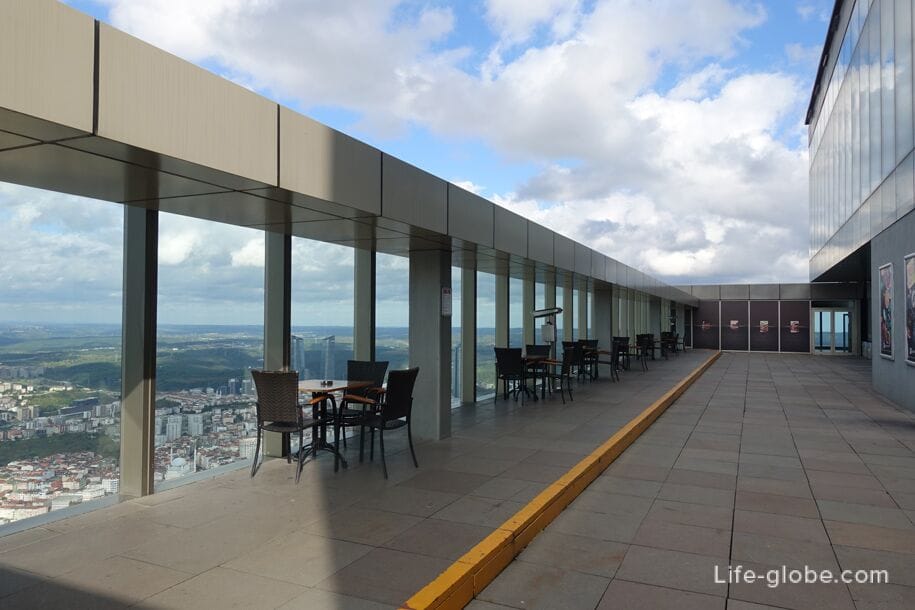
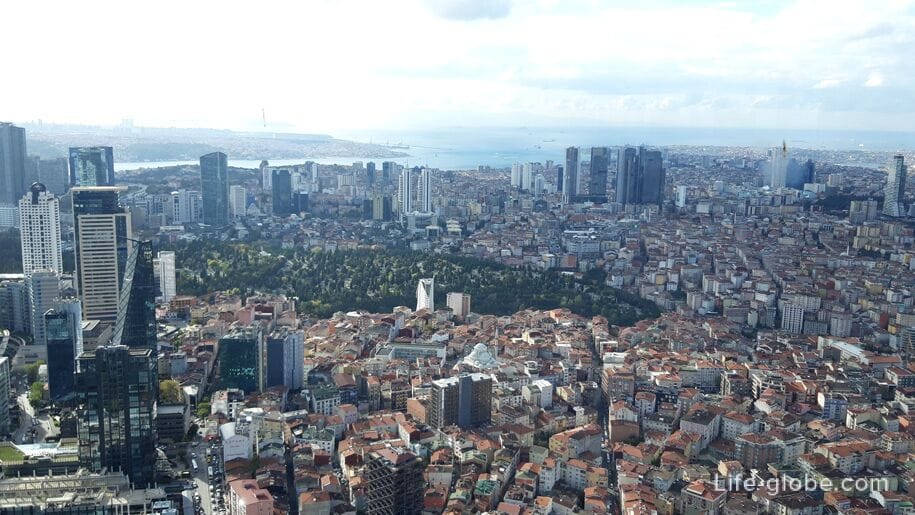
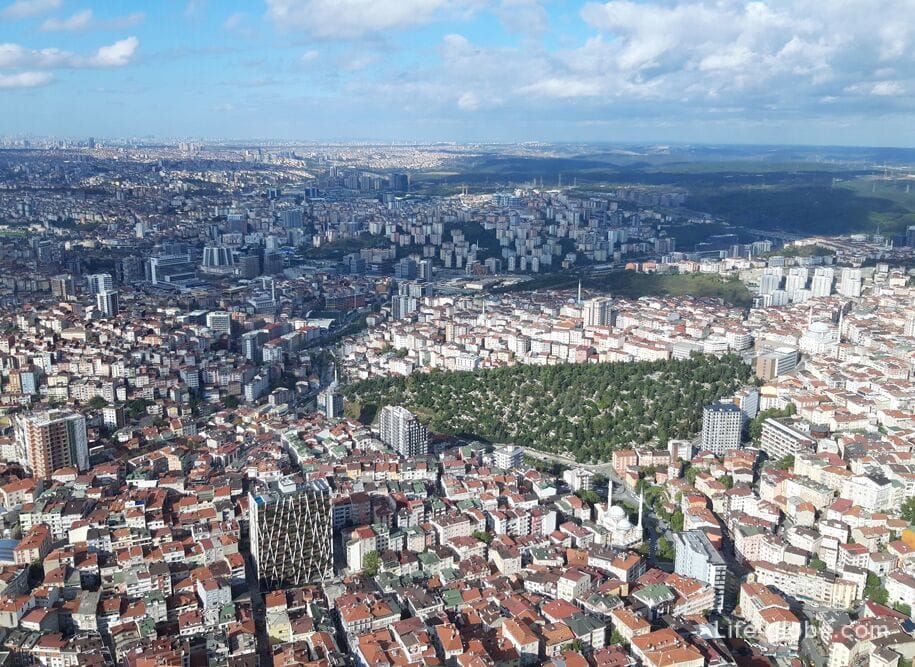
In the museum of classic cars (Ural Ataman Klasik Otomobil Müzesi) vintage cars are collected and there is a cafe in the spirit of the 1950s in the center of the exposition.
Museum address: Ferahevler, Nuri Paşa Cd. No: 107, 34457 Sarıyer/Istanbul, Turkey.
The museum's website: atamanmuseum.com .

Today's Beykoz Glass and Crystal Museum (Beykoz Cam ve Billur Müzesi) is located in a restored historical barn building of the former residence of Abraham Pasha, who was a confidant of the Egyptian Khedive Ismail Pasha and received the title of vizier from Sultan Abdulaziz.
The building, bearing the architectural features of the 19th century, is a modular structure based on the duplication of similar spaces surrounding the courtyard in a U-shape, and its facades are enlivened by round arched openings on the lower floor.
The building houses museum spaces with masonry and a Western-style structure, where developments of Turkish and European glass, porcelain and crystal are presented in 12 sections.
Entrance to the museum is paid.
The museum is located in the Asian part of Istanbul (as well as all of the following attractions and museums), at the address: Merkez, Mehmet Yavuz Cd. No: 115, 34820 Beykoz/Istanbul, Turkey.
Museum website: beykoz-cam-ve-billur-muzesi.
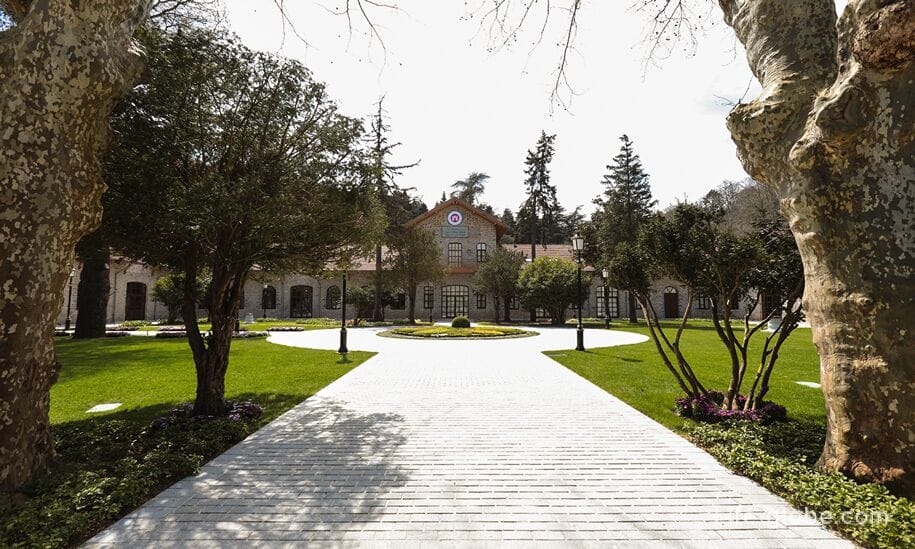
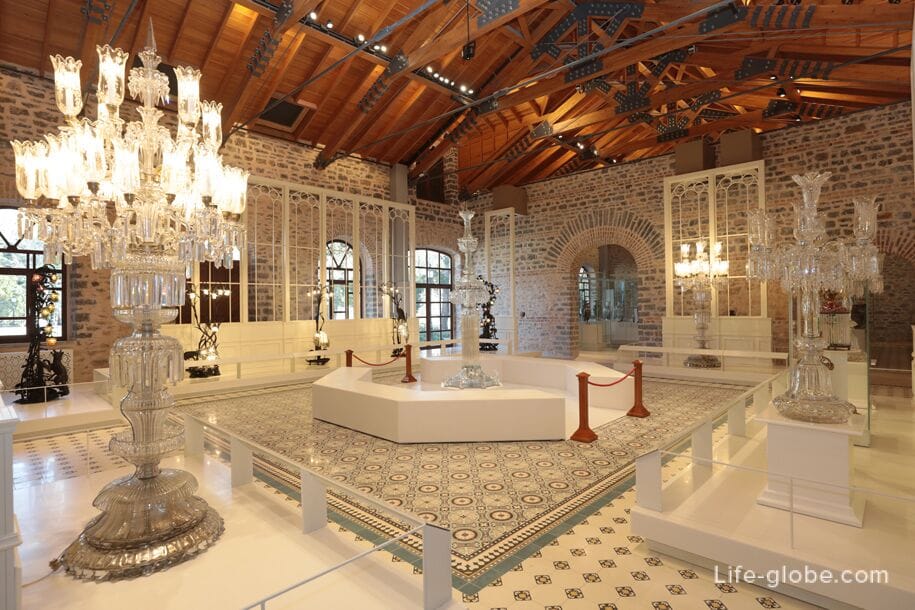

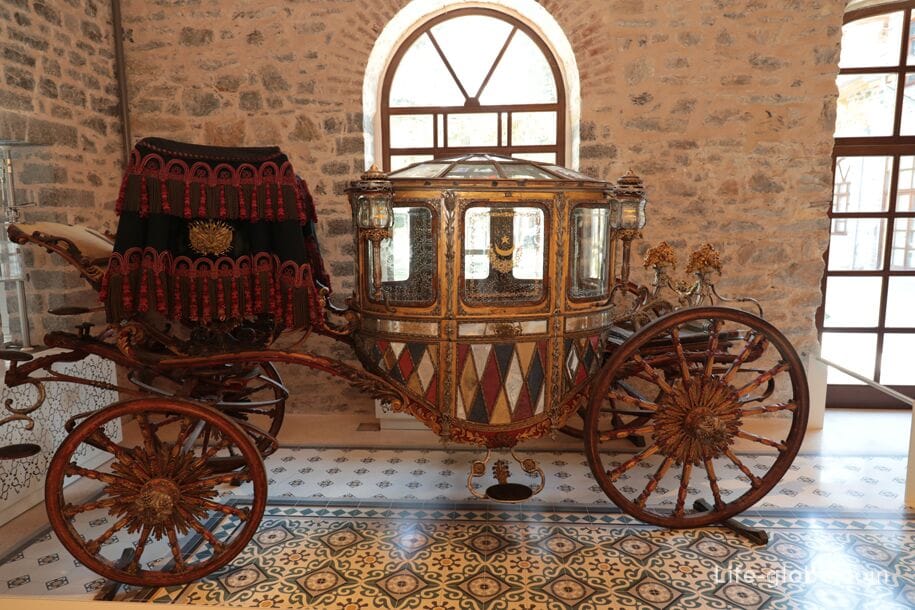
Beykoz Medjidiye Mansion or Beykoz Palace (Beykoz Mecidiye Kasrı) is one of the oldest pavilions in Istanbul.
The construction of the pavilion, which was started by the Egyptian Governor Mehmed Ali Pasha as a gift to Sultan Abdul-Majid in 1845, was continued during the reign of his son, the Egyptian governor Said Pasha, after the death of Mehmed Ali Pasha in 1849. The complete construction was completed in 1854.
The Medjidiye Pavilion was not very popular with Sultan Abdul-Medjid, but was often visited by Sultan Abdulaziz, especially in the summer months. The pavilion was used during sultan's hunts, as well as for daily living and official receptions. The Sultan received the French Empress Eugenie here on October 15, 1869 and together with her watched the army parade from the pavilion.
Today, this two-storey pavilion is a museum and one of the most elegant historical mansions in the city. The mansion is located in surrounded by groves with terraces, magnolias, pines and lime trees. From the territory of the palace park there are views of the Bosphorus.
Pavilion address: Yalıköy, Beykoz Kasrı, 34820 Beykoz/Istanbul, Turkey.
Beykoz Museum website: beykoz-mecidiye-kasri. More about the palaces of Istanbul...



Otagtepe Park is located near the Sultan Mehmet Fatih Bridge (Fatih Sultan Mehmet Köprüsü).
Although this park is located far from the main tourist routes and attractions of the city, but it is a very popular place in Istanbul, mainly due to the fact that the park is located on Otagtepe Hill and offers beautiful panoramic views of the Bosphorus Strait and the European side of the city.
In the park: walking paths, lawns, recreation areas, picnic areas and gazebos, observation terraces, a small pond with turtles.
Entrance to the park is free. More about Otagtepe Fatih Park...
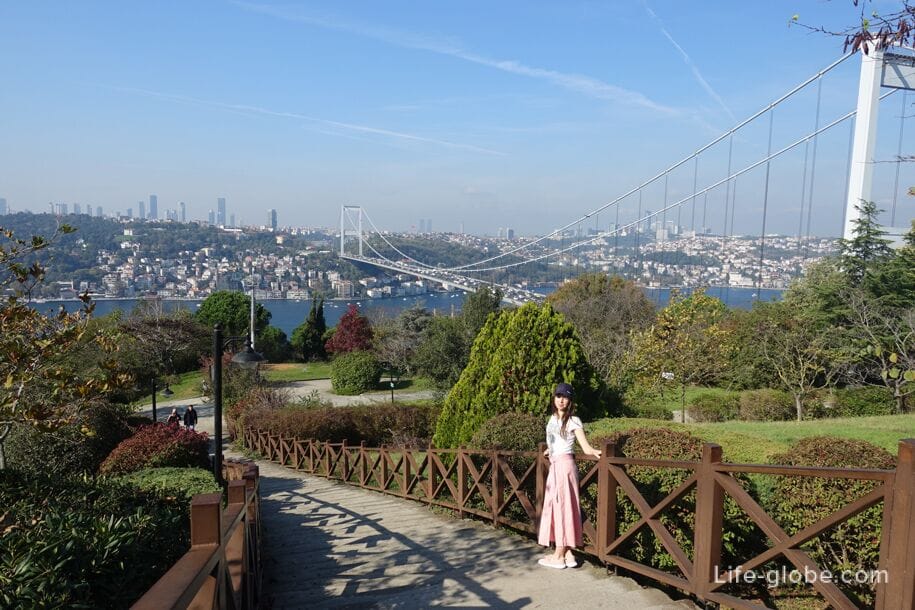
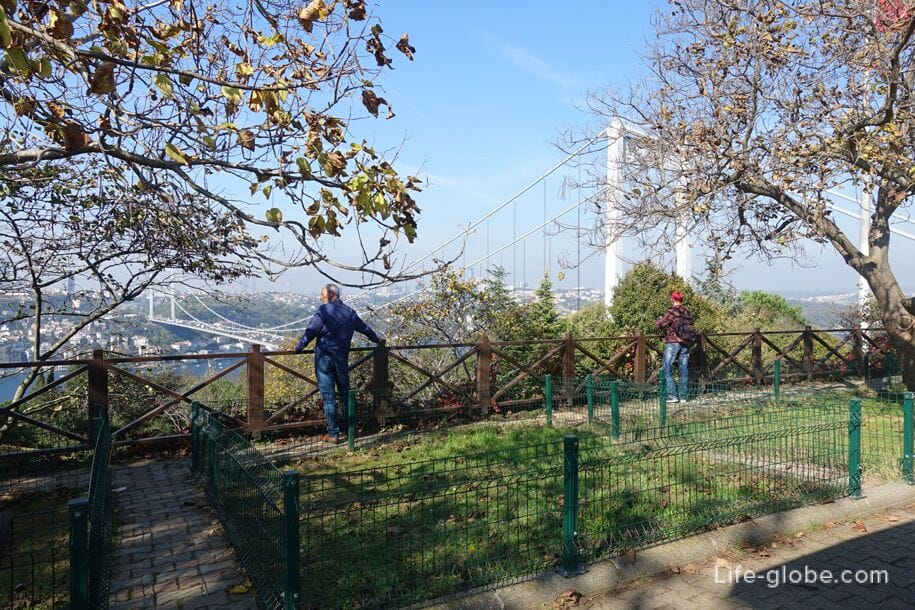

The Palace of Küçüksu (Küçüksu Kasrı) is a neo-Baroque palace that served as the summer residence of the sultans of the Ottoman Empire, and today is a museum with palace halls.
Translated from Turkish, the palace is called as "The Palace of heavenly water" or "The Palace of small water".
This miniature palace was built in 1857 by order of Sultan Abd-ul-Majid I. The construction of the palace was carried out on the site of a two-story wooden palace built during the reign of Mahmud I.
Today, the Kyuchuksu Palace is a striking monument of the Ottoman Empire and functions as a museum with recreated palace interiors.
Entrance to the palace is paid.
Palace address: Göksu, Küçüksu Cd., 34810 Beykoz/Istanbul, Turkey.
Palace website: kucuksu-kasri. More about the Kyuchuksu Palace...
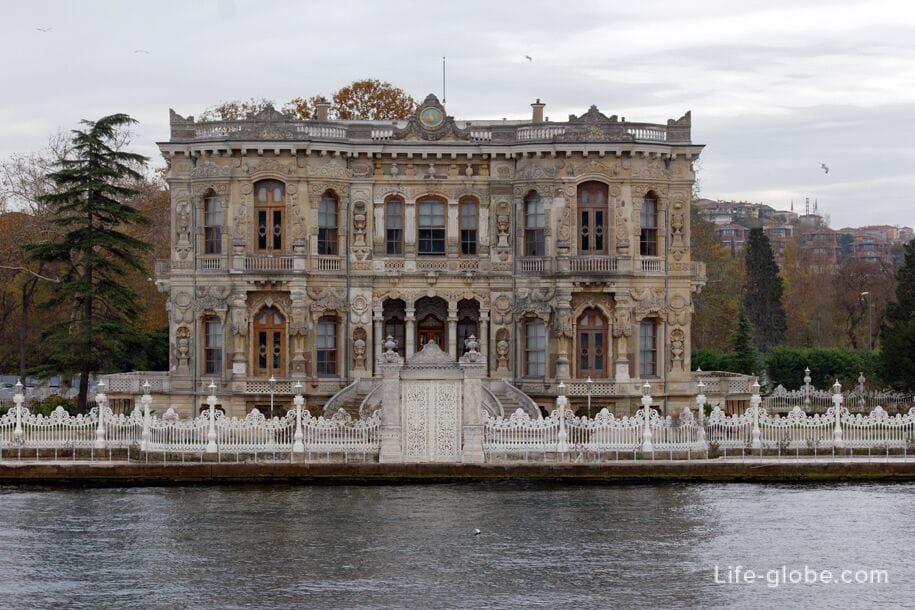

The Beylerbeyi Sarayı Palace is a 19th-century neo-Baroque palace that served as a summer residence and accommodation for high-ranking guests of the sultans of the Ottoman Empire.
The first wooden palace on the current site, known as the "Divergent Garden", was erected by order of Sultan Mahmud II in 1808-1839. After the destruction of the wooden building due to a fire, by order of Sultan Abdul-Aziz in 1863-1865, a new palace was erected, which acquired its current appearance.
Since 1912, the palace was the last residence of the deposed Sultan Abdulhamid II. Within the walls of the palace, the Sultan died in 1918.
Today the palace is a museum, which is a palace complex, which includes the main building of the palace with recreated interiors, as well as the surrounding garden with terraces, pavilions, sculptures, a fountain and a cafe.
The gardens of the Beylerbeyi Palace also attract attention by the fact that they have access to a terrace near the waters of the Bosphorus, which is used as an observation deck.
Entrance to the Beylerbeyi Palace and the adjacent park is paid.
The address of the palace: Beylerbeyi, Abdullahağa Cd., Istanbul.
Palace website: beylerbeyi-sarayi. More about the Beylerbeyi Palace...
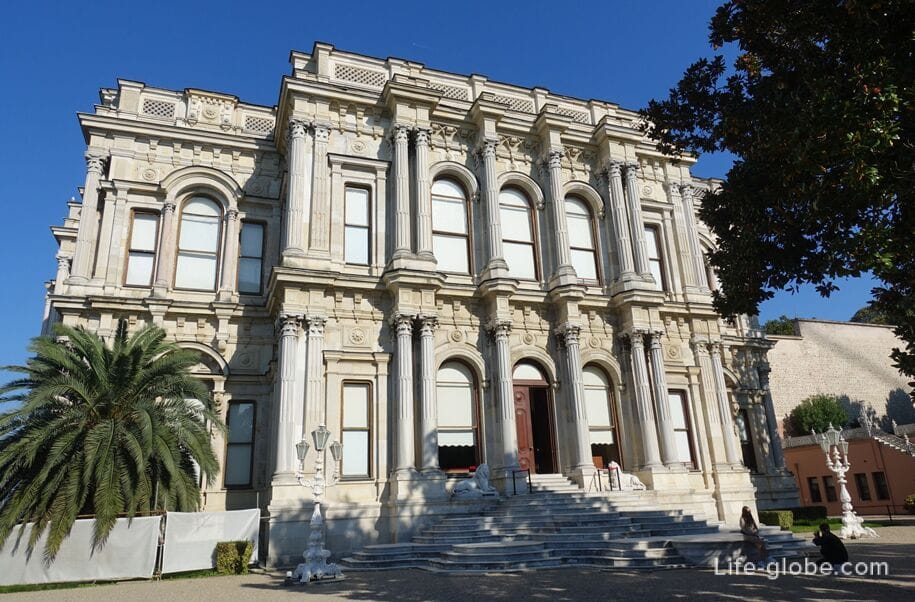

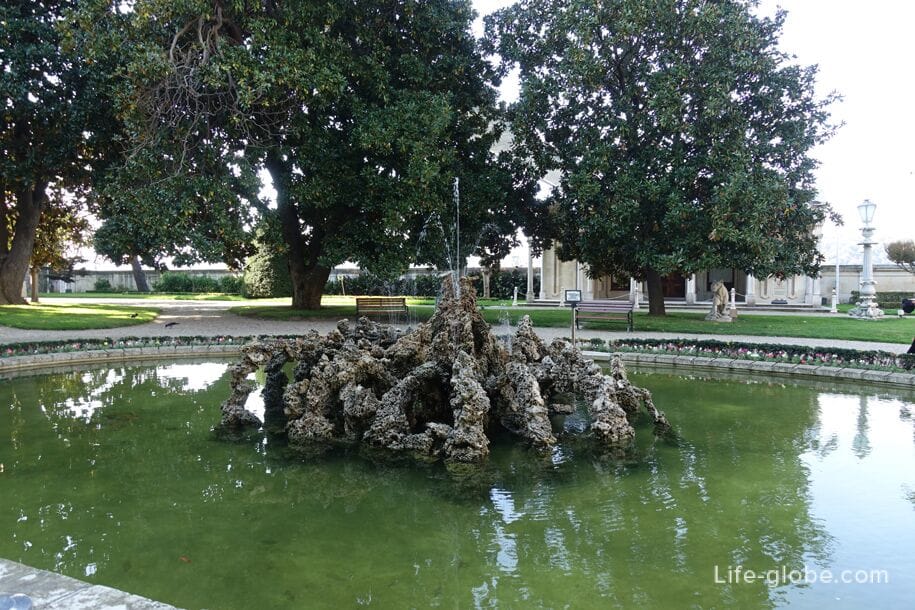

Kuzgunchuk district or Kusgunjuk (Kuzguncuk) is a colorful quarter (district) located in the large district of Uskyudar (Üsküdar).
Kuzgunchuk is sometimes called "gingerbread" or "toy".
This is a small pleasant quiet area near the waters of the Bosphorus, which has a rustic atmosphere with streets built up, including old colorful wooden houses, parks, a museum, mosques, churches, small shops and seaside cafes.
Near the shore of the quarter there is a ferry pier "Kuzguncuk Çarşı" and a small park, as well as exits to the Bosphorus.
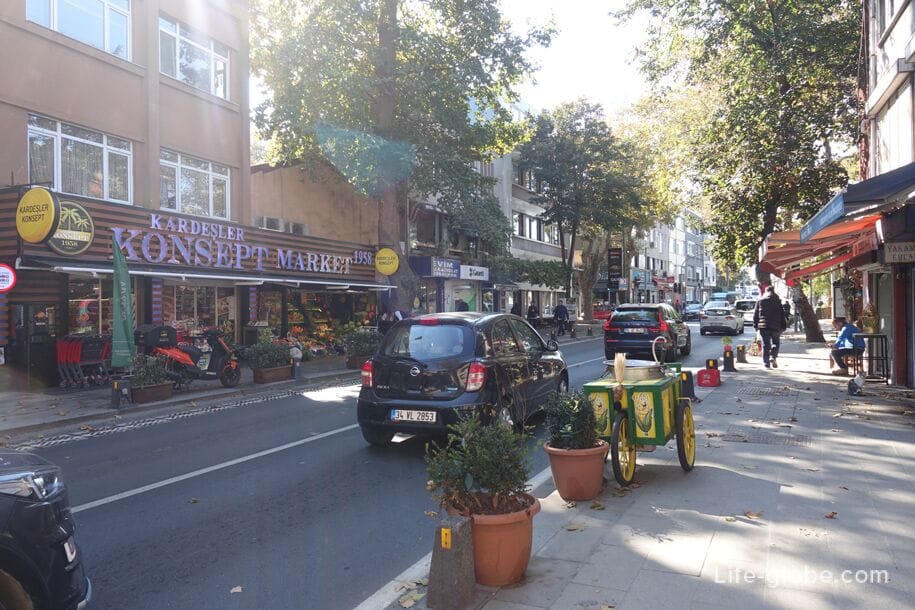

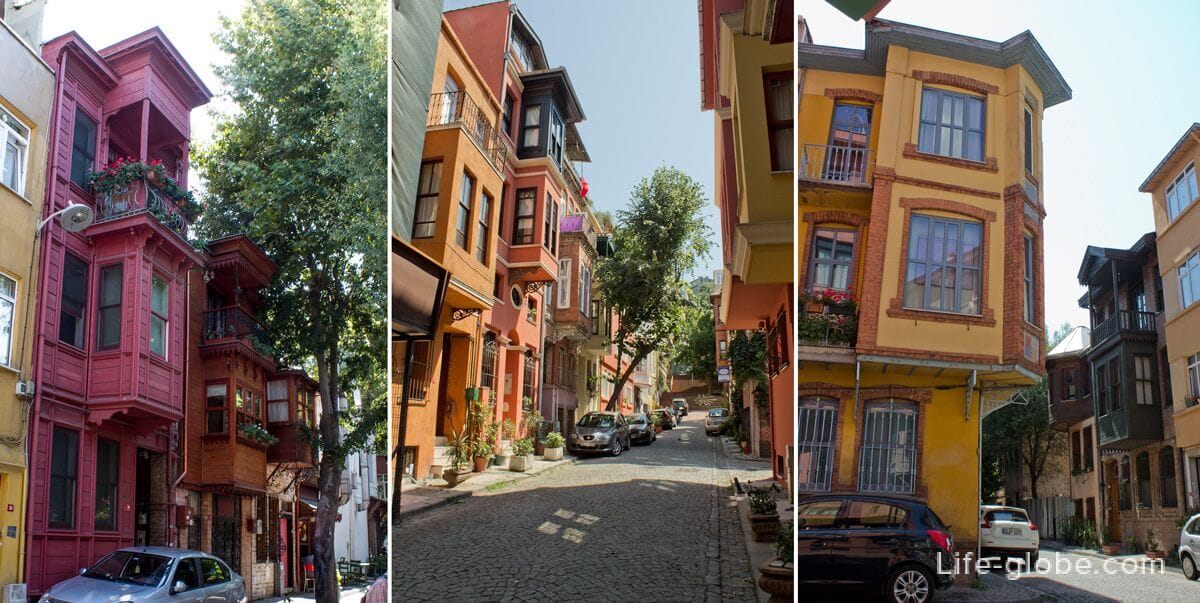
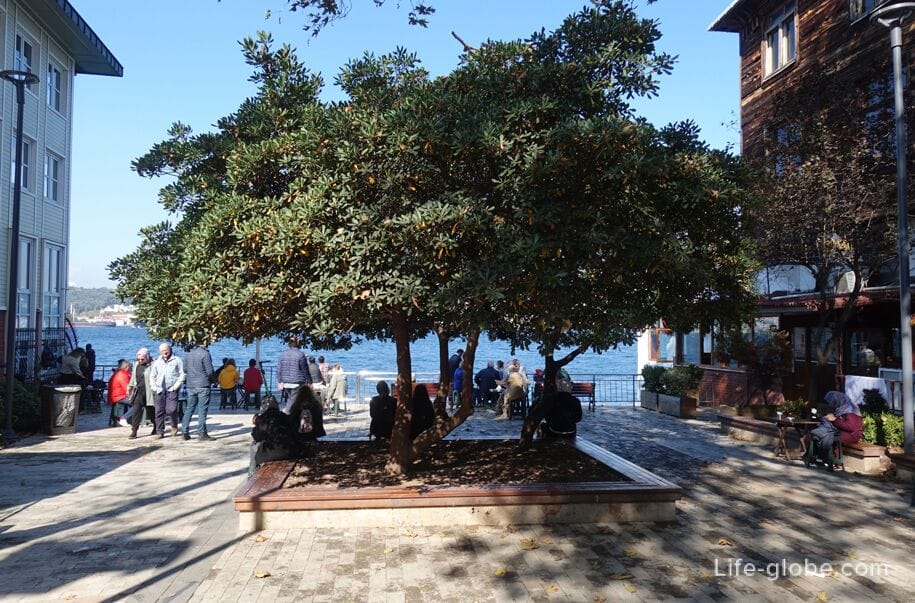
Nakkashtepe (Nakkaştepe Millet Bahçesi) and Fethi Pasha (Fethipaşa Korusu) parks are particularly notable in the area, which have places for walking, cafes, playgrounds and panoramic terraces. Learn more about the districts of Kuzgunchuk and Uskyudar...
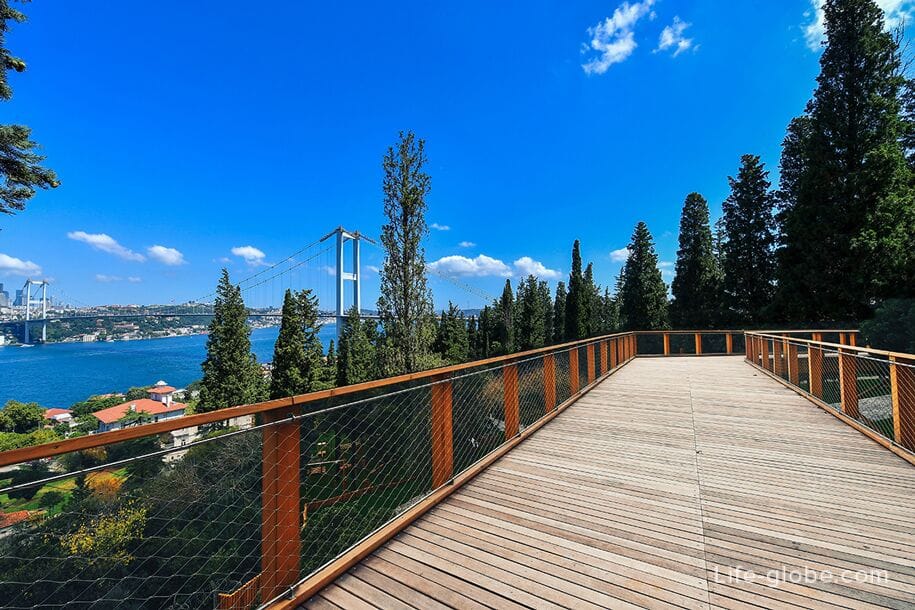
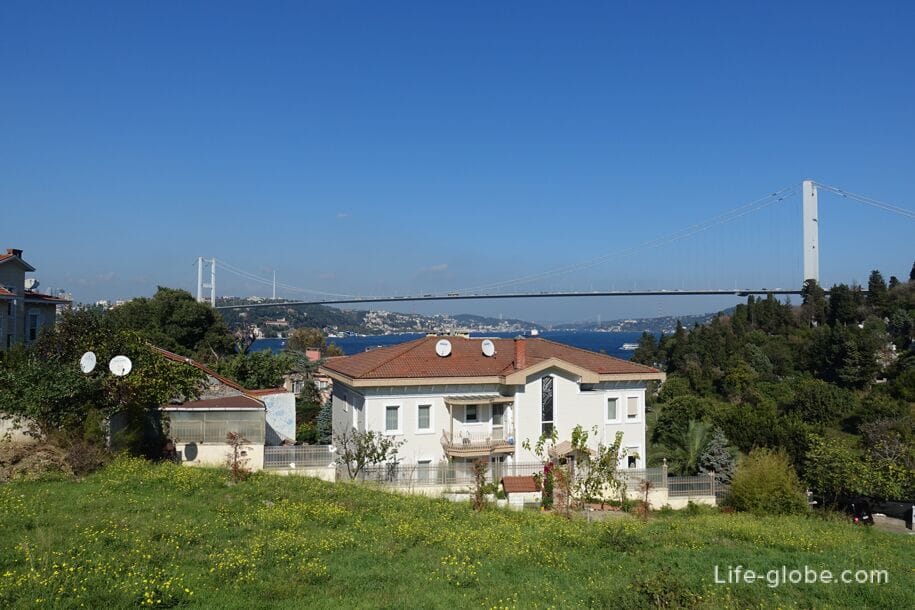
The big hill of Chamlyja (Çamlıca Tepesi) is a high hill (288 meters) on the top of which the Chalmıca Mosque of the same name (Çamlıca Mosque) is located.
The Chalmidja Mosque (Büyük Çamlıca camii) is the largest mosque in Istanbul, which is new, its construction was completed in 2019.
This mosque has six minarets, which represent the six symbols of the Islamic faith.
From the open terrace of the mosque and from the hill there are wonderful panoramic views of Istanbul.
In the public park on the hill with trees, flower beds and fountains there are historical teahouses, cafes and a restaurant. Learn more about Istanbul mosques...
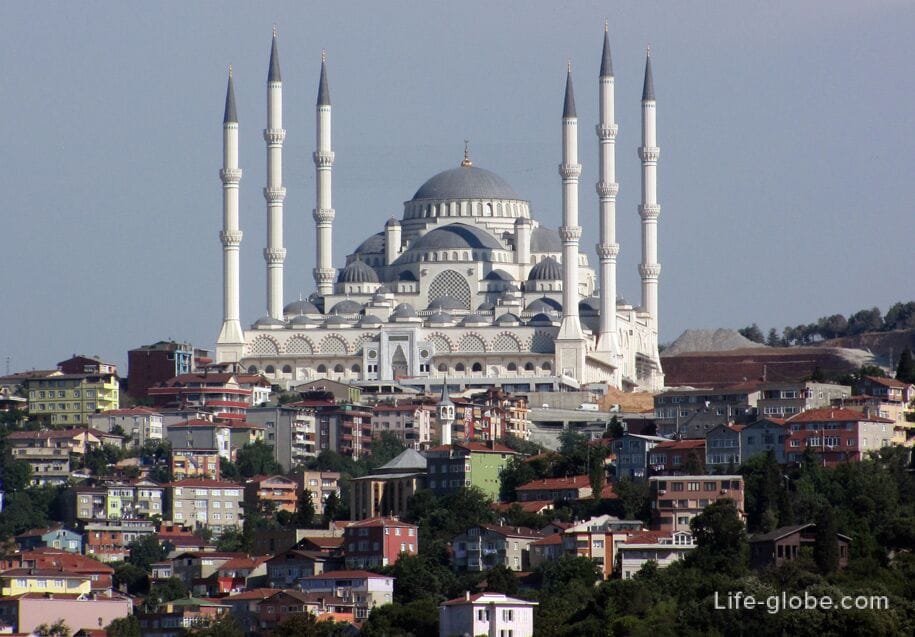


Maiden Tower (Kız Kulesi / Kyz Kulesi), also known as Leandrova Tower (Tower of Leandros) is a former lighthouse, which is now one of the main pearls and a symbol of Istanbul.
The tower is located on a small natural island in the waters of the Bosphorus Strait, a few meters from the shore of Uskyudar.
During its history, the tower has been a lighthouse, a prison and a quarantine isolation ward.
The tower suffered from earthquakes, fires and weather conditions, but it was always restored. The last major renovation of the Maiden Tower during the Ottoman Empire was carried out during the reign of Mahmud II. After the restoration in 1832-1833, the tower was given its current appearance.
Today the Maiden's Tower can be visited. Views of the Bosphorus and its shores open from here. More about the Maiden Tower...
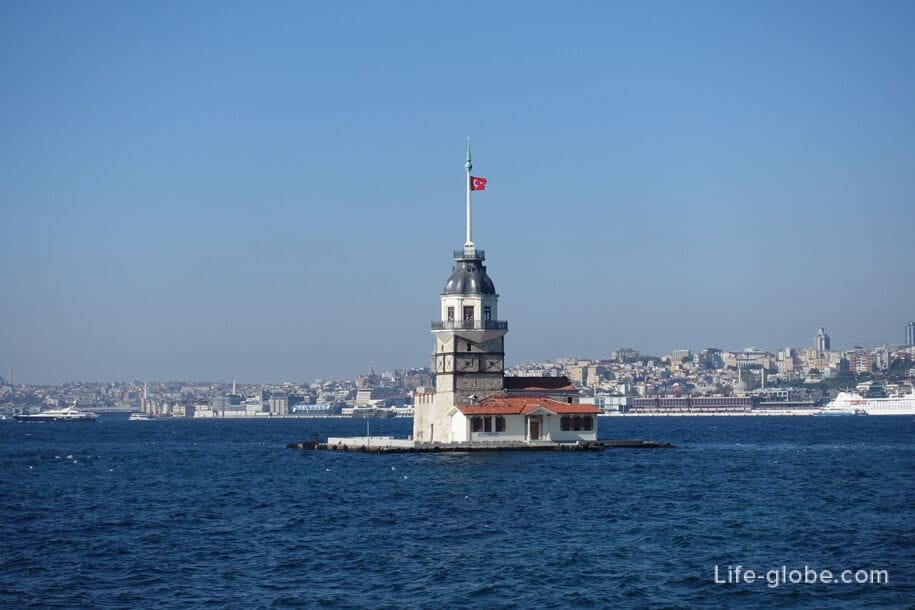
The Chamlyja TV Tower (Çamlıca TV Radyo kulyesi, Çamlıca Kulesi / Camlica Tower) has a modern architecture and a height of 369 meters (and 587 meters above sea level), consists of a total of 49 floors, of which 4 are underground and 45 are above ground.
In addition to media, radio and television broadcasting services, the tower also provides infrastructure services to wireless operators and general tourist services.
There is an observation deck in the tower, giving a 360-degree panoramic view of the whole of Istanbul and the surrounding area. There is also a panoramic cafeteria-restaurant in the tower.
The ascent to the observation deck is paid.
The TV tower is located in the Usküdar district, at the address: Küçük Çamlıca Çilehane Yolu Caddesi Oyma Sokak, D:No: 1, 34696 Üsküdar, Turkey.
TV tower website: camlicakule.istanbul. Learn more about the observation decks and observation points of Istanbul...


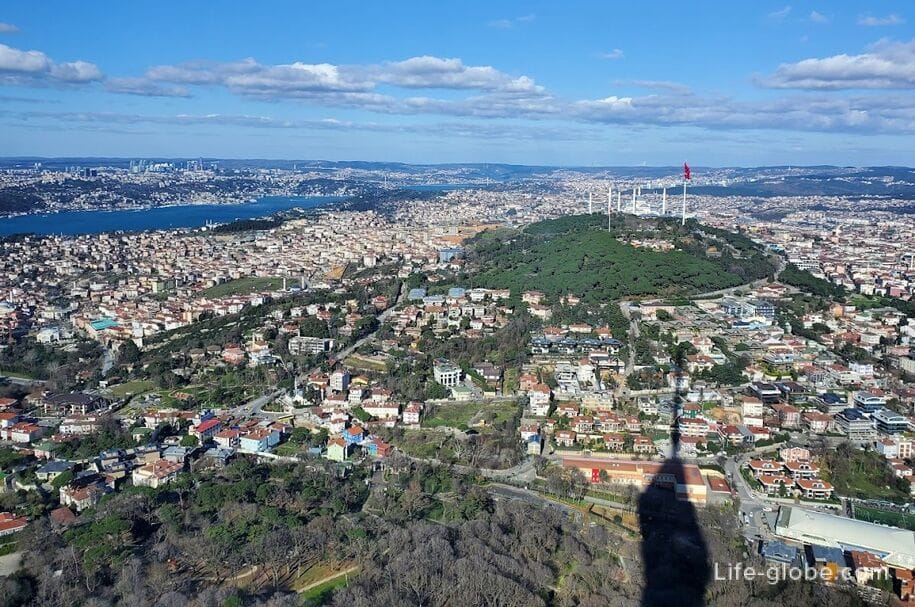
The Toy Museum (Istanbul Oyuncak Müzesi) is a museum in a former mansion with many toys and compositions of toys, including antique sets and figures from 200 years ago.
The museum is based on toys that Sunai Akin (the founder of the museum and collector) bought from antique dealers and auctions in more than 40 countries over 20 years.
There is a cafe at the museum.
Museum address: Göztepe Mah. Ömerpaşa Cad, Dr. Zeki Zeren Sk No: 17, 34730 Kadıköy, Turkey.
The museum's website: istanbuloyuncakmuzesi.com. More about Istanbul museums...

In the recreation and entertainment center Viaport Marina, which is located on the outskirts of Istanbul, you can walk, relax, buy things, have fun and eat.
The complex includes: shopping areas, cafes and restaurants, an amusement park, a water park, an aquarium, a small zoo, a bowling alley, a game center, a cinema and a marina.
On the territory of Viaport Marina is located Crowne Plaza Hotel - Istanbul Tuzla Viaport Marina, an IHG Hotel with a restaurant, bar, fitness center, lounge and 24-hour front desk. The room rate may include: breakfast or breakfast + dinner. Hotel link
Viaport Marina address: Cami Mh Balıkçılar Sokak U Blok 20 U, D:226, 34940 Tuzla, Turkey.
Viaport Marina website: viaportmarina.com.

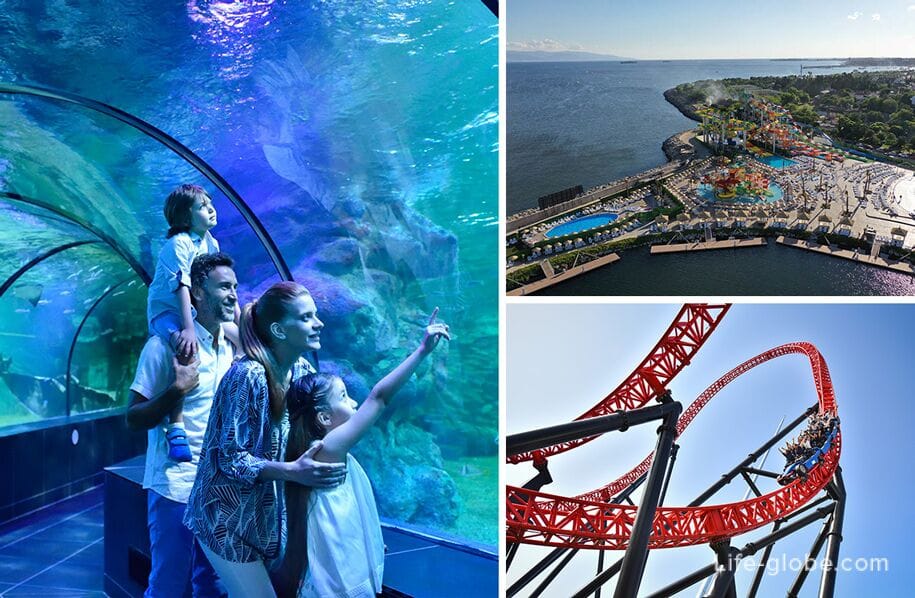
Some palaces, museums and sites in Istanbul have museum and tourist maps.
There are different types of maps in Istanbul. Some of which give the right to visit certain museums, while others, in addition to the main museums, include excursions, as well as some shows and entertainment, public transport rides and discounts on airport transfers.
The classic and most common is the museum card "Museum Pass Istanbul" (Museum Pass Istanbul), which gives the right to enter some museums of the city. There are also more extended Istanbul E-Pass and Istanbul Tourist Pass cards, which give the right to visit museums, attractions, guided tours, an aquarium, shows, cruises along the Bosphorus, trips outside the city, etc. Learn more about museum and tourist maps of Istanbul...
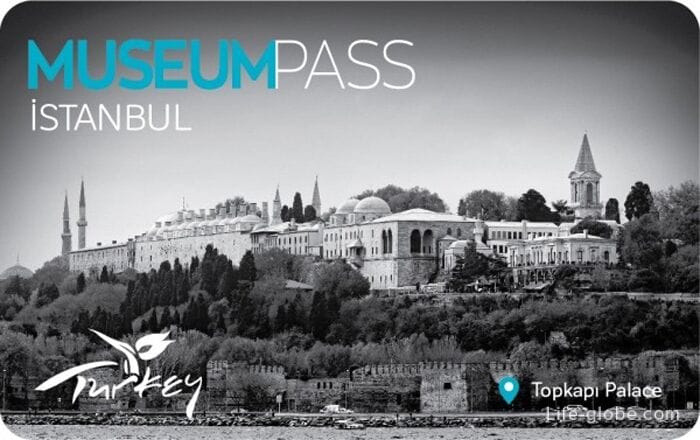
You can visit some of the main sights and museums of Istanbul by taking a tour on the Istanbul Hop-On Hop-Off tour bus.
Tickets for the Istanbul sightseeing bus can be purchased here →
All accommodation facilities in Istanbul, including in the historical center, in the European and Asian parts of the city, can be viewed and booked here
You can get to Istanbul's hotels and attractions by public transport, taxi or rented car.